Pioneer K048 DVD RDS AV RECEIVER User Manual AVH P8400BH
Pioneer Corporation DVD RDS AV RECEIVER AVH P8400BH
Pioneer >
User Manual(AVH-P8400BH)
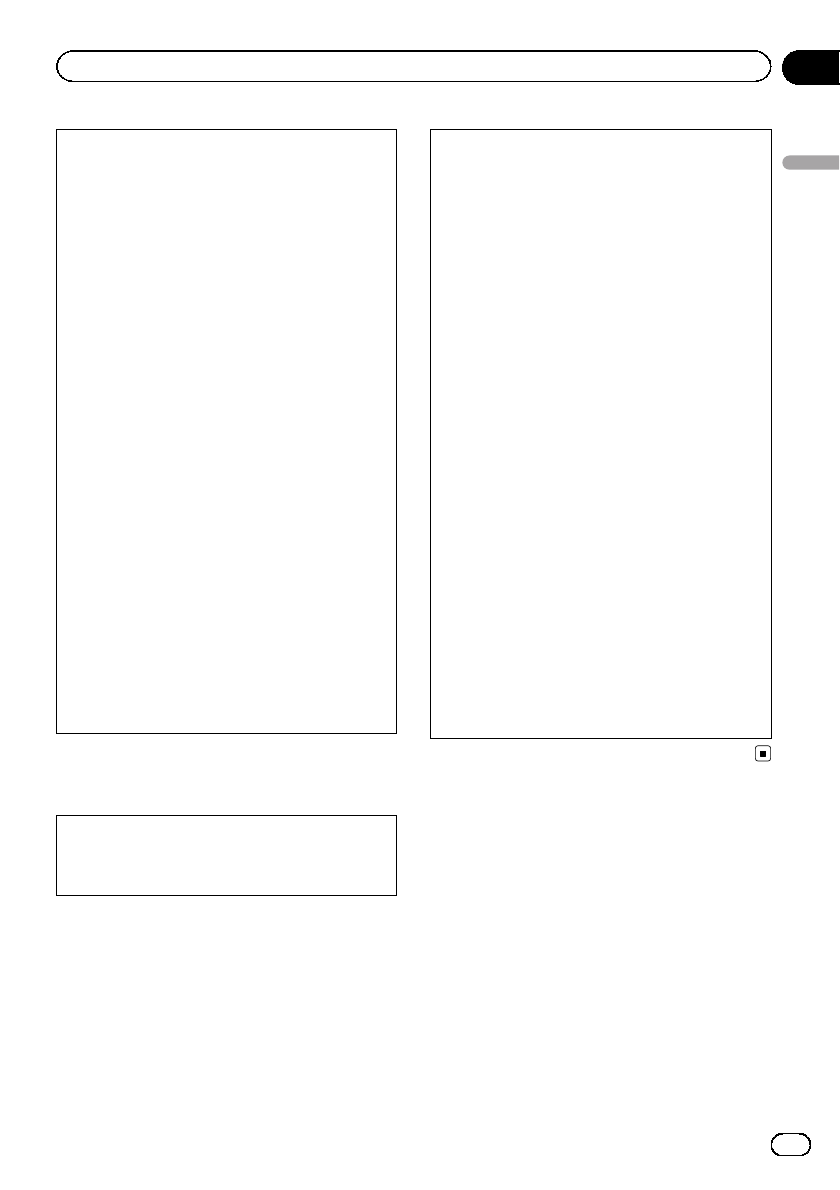
FCC ID: AJDK048
MODEL NO.: AVH-P8400BH
IC: 775E-K048
This device complies with Part 15 of FCC Rules
and Industry Canada licence-exempt RSS stan-
dard(s). Operation is subject to the following
two conditions: (1) this device may not cause
interference, and (2) this device must accept
any interference, including interference that
may cause undesired operation of this device.
This transmitter must not be co-located or op-
erated in conjunction with any other antenna
or transmitter.
The antenna for Bluetooth cannot be removed
(or replaced) by user.
This equipment complies with FCC/IC radiation
exposure limits set forth for an uncontrolled
environment and meets the FCC radio fre-
quency (RF) Exposure Guidelines in Supple-
ment C to OET65 and RSS-102 of the IC radio
frequency (RF) Exposure rules. This equipment
has very low levels of RF energy that it deemed
to comply without maximum permissive expo-
sure evaluation (MPE). But it is desirable that
it should be installed and operated keeping the
radiator at least 20 cm or more away from per-
son’s body (excluding extremities: hands,
wrists, feet and ankles).
Information to User
Alteration or modifications carried out without
appropriate authorization may invalidate the
user’s right to operate the equipment.
Note
This equipment has been tested and found to
comply with the limits for a Class B digital de-
vice, pursuant to Part 15 of the FCC Rules.
These limits are designed to provide reason-
able protection against harmful interference in
a residential installation. This equipment gen-
erates, uses and can radiate radio frequency
energy and, if not installed and used in accor-
dance with the instructions, may cause harm-
ful interference to radio communications.
However, there is no guarantee that interfer-
ence will not occur in a particular installation.
If this equipment does cause harmful interfer-
ence to radio or television reception, which
can be determined by turning the equipment
off and on, the user is encouraged to try to cor-
rect the interference by one or more of the fol-
lowing measures:
- Reorient or relocate the receiving antenna.
- Increase the separation between the equip-
ment and receiver.
- Connect the equipment into an outlet on a
circuit different from that to which the receiver
is connected.
- Consult the dealer or an experienced radio/TV
technician for help.
The Safety of Your Ears is in
Your Hands
Get the most out of your equipment by playing
it at a safe level—a level that lets the sound
come through clearly without annoying blar-
ing or distortion and, most importantly, with-
out affecting your sensitive hearing. Sound
can be deceiving. Over time, your hearing
“comfort level”adapts to higher volumes of
sound, so what sounds “normal”can actually
be loud and harmful to your hearing. Guard
against this by setting your equipment at a
safe level BEFORE your hearing adapts.
En 7
Section
02
Before you start
Before you start
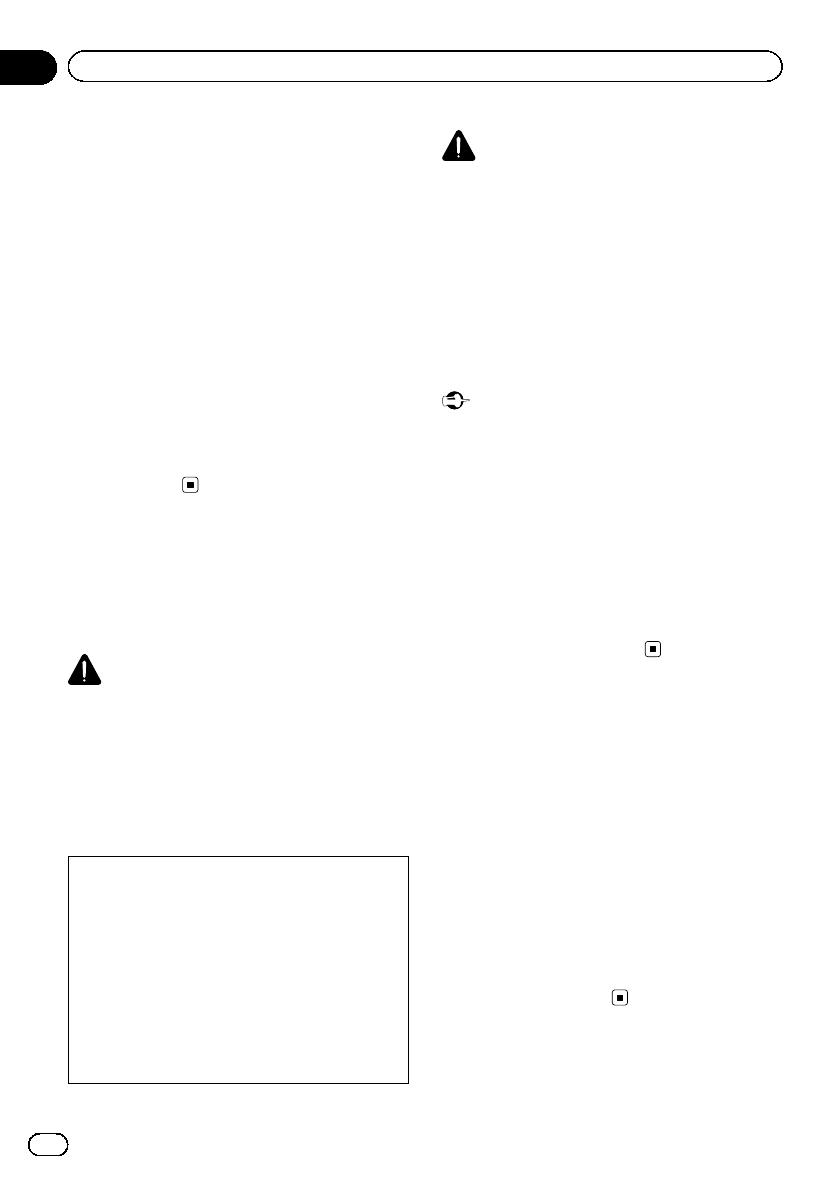
ESTABLISH A SAFE LEVEL:
!Set your volume control at a low setting.
!Slowly increase the sound until you can
hear it comfortably and clearly, without dis-
tortion.
!Once you have established a comfortable
sound level, set the dial and leave it there.
BE SURE TO OBSERVE THE FOLLOWING
GUIDELINES:
!Do not turn up the volume so high that you
can’t hear what’s around you.
!Use caution or temporarily discontinue use
in potentially hazardous situations.
!Do not use headphones while operating a
motorized vehicle; the use of headphones
may create a traffic hazard and is illegal in
many areas.
About this unit
The tuner frequencies on this unit are allo-
cated for use in North America. Use in other
areas may result in poor reception.
WARNING
Handling the cord on this product or cords asso-
ciated with accessories sold with the product
may expose you to chemicals listed on proposi-
tion 65 known to the State of California and other
governmental entities to cause cancer and birth
defect or other reproductive harm. Wash hands
after handling.
CAUTION:
USE OF CONTROL OR ADJUSTMENT OR
PERFORMANCE OF PROCEDURES
OTHER THAN THOSE SPECIFIED HEREIN
MAY RESULT IN HAZARDOUS RADIATION
EXPOSURE.
CAUTION:
THE USE OF OPTICAL INSTRUMENTS
WITH THIS PRODUCT WILL INCREASE
EYE HAZARD.
CAUTION
!Do not allow this unit to come into contact
with liquids. Electrical shock could result.
Also, damage to this unit, smoke, and over-
heating could result from contact with liquids.
!Keep this manual handy for future reference.
!Always keep the volume low enough to hear
outside sounds.
!Avoid exposure to moisture.
!If the battery is disconnected or discharged,
any preset memory will be erased.
Important (Serial number)
The serial number is located on the bottom of
this unit. For your own security and convenience,
be sure to record this number on the enclosed
warranty card.
DVD video disc region numbers
Only DVD video discs with compatible region
numbers can be played on this player. You can
find the region number of the player on the
bottom of this unit and in this manual (refer to
Specifications on page 111).
About this manual
This unit features a number of sophisticated
functions to ensure superior reception and op-
eration. All the functions have been designed
for the easiest possible use, but many are not
self-explanatory. This operation manual will
help you benefit fully from this unit’s potential
and to maximize your listening enjoyment.
We recommend that you familiarize yourself
with the functions and their operation by read-
ing through the manual before you begin
using this unit. It is especially important that
you read and observe WARNINGs and CAU-
TIONs in this manual.
En
8
Section
02 Before you start
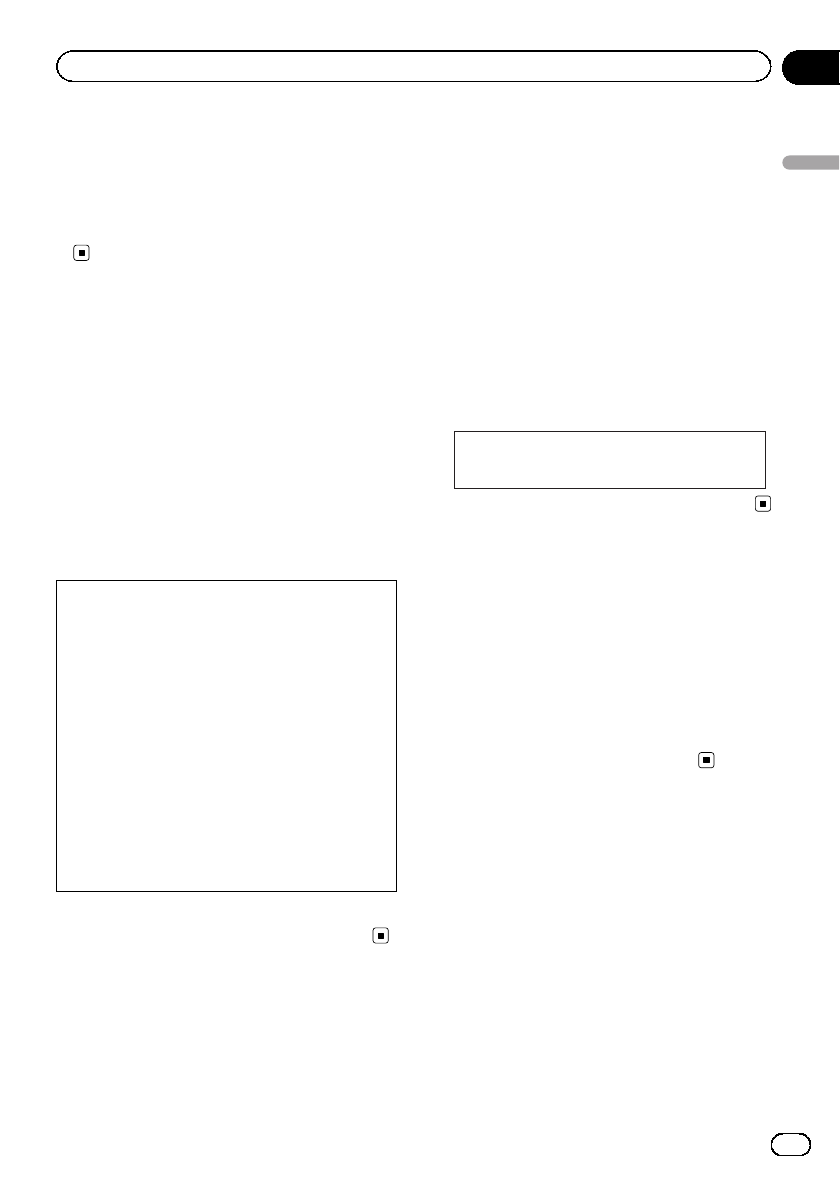
Operating environment
This unit should be used within the tempera-
ture ranges shown below.
Operating temperature range: 14 °F to 140 °F
EN300328 ETC test temperature: –4 °F and 131
°F
After-sales service for
Pioneer products
Please contact the dealer or distributor from
where you purchased this unit for after-sales
service (including warranty conditions) or any
other information. In case the necessary infor-
mation is not available, please contact the
companies listed below:
Please do not ship your unit to the companies
at the addresses listed below for repair without
advance contact.
U.S.A.
Pioneer Electronics (USA) Inc.
CUSTOMER SUPPORT DIVISION
P.O. Box 1760
Long Beach, CA 90801-1760
800-421-1404
CANADA
Pioneer Electronics of Canada, Inc.
CUSTOMER SATISFACTION DEPARTMENT
340 Ferrier Street
Unit 2
Markham, Ontario L3R 2Z5, Canada
1-877-283-5901
905-479-4411
For warranty information please see the Lim-
ited Warranty sheet included with this unit.
Visit our website
Visit us at the following site:
http://www.pioneerelectronics.com
in Canada
http://www.pioneerelectronics.ca
1 Register your product. We will keep the details
of your purchase on file to help you refer to
this information in the event of an insurance
claim such as loss or theft.
2 Receive updates on the latest products and
technologies.
3 Download owner’s manuals, order product
catalogues, research new products, and
much more.
4 Your feedback is important in our continual ef-
fort to design and build the most advanced,
consumer-focused product in the industry.
Serial number
Adjusting the response
positions of the touch panels
(Touch Panel Calibration)
If you feel that the touch panel keys on the
screen deviate from the actual positions that
respond to your touch, adjust the response po-
sitions of the touch panel. Refer to Adjusting
the response positions of the touch panels
(Touch Panel Calibration) on page 74.
Use and care of the remote
control
Installing the battery
Slide the tray on the back of the remote con-
trol out and insert the battery with the plus (+)
and minus (–) poles aligned properly.
!When using for the first time, pull out the
film protruding from the tray.
En 9
Section
02
Before you start
Before you start
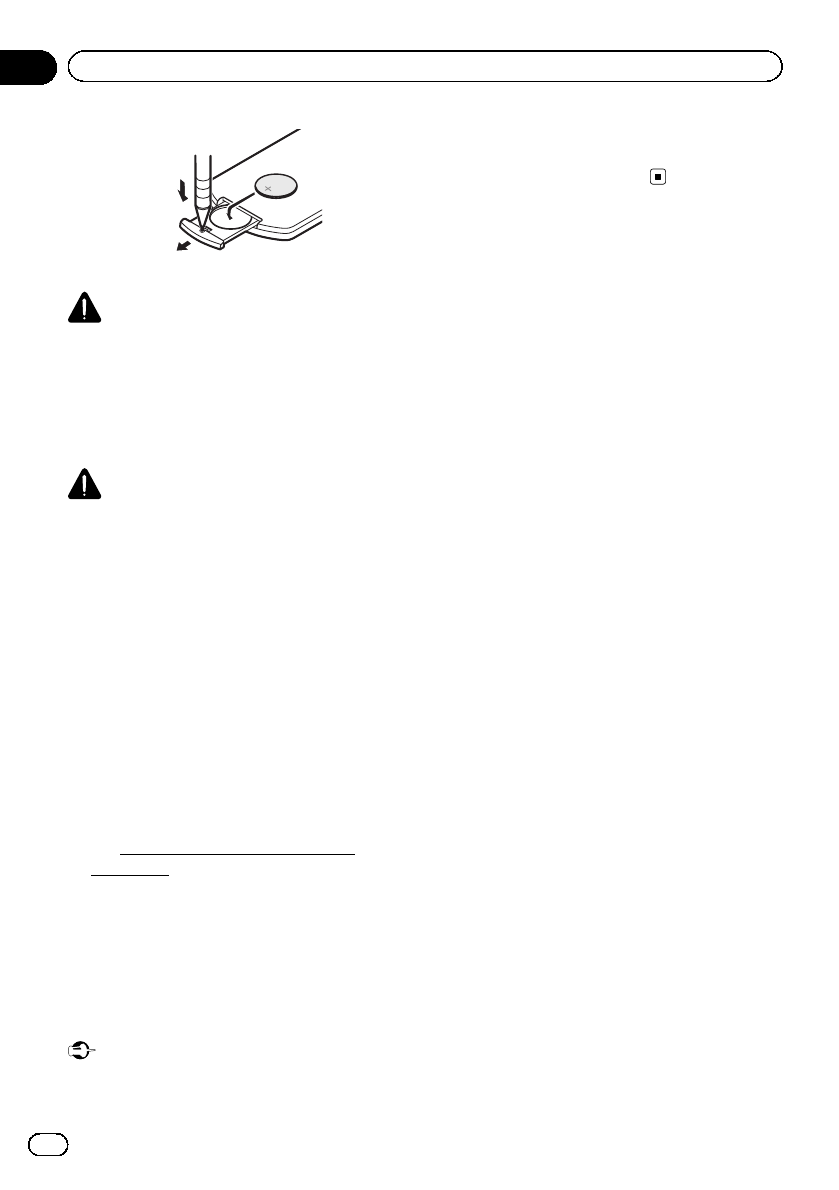
WARNING
!Keep the battery out of the reach of children.
Should the battery be swallowed, consult a
doctor immediately.
!Batteries (battery pack or batteries installed)
must not be exposed to excessive heat such
as sunshine, fire or the like.
CAUTION
!Use one CR2025 (3 V) lithium battery.
!Remove the battery if the remote control is not
used for a month or longer.
!There is a danger of explosion if the battery is
incorrectly replaced. Replace only with the
same or equivalent type.
!Do not handle the battery with metallic tools.
!Do not store the battery with metallic objects.
!If the battery leaks, wipe the remote control
completely clean and install a new battery.
!When disposing of used batteries, comply
with governmental regulations or environmen-
tal public institutions’rules that apply in your
country/area.
!“Perchlorate Material –special handling may
apply.
See www.dtsc.ca.gov/hazardouswaste/
perchlorate. (Applicable to California, U.S.A.)”
Using the remote control
Point the remote control in the direction of the
front panel to operate.
!The remote control may not function prop-
erly in direct sunlight.
Important
!Do not store the remote control in high tem-
peratures or direct sunlight.
!Do not let the remote control fall onto the
floor, where it may become jammed under the
brake or accelerator pedal.
En
10
Section
02 Before you start
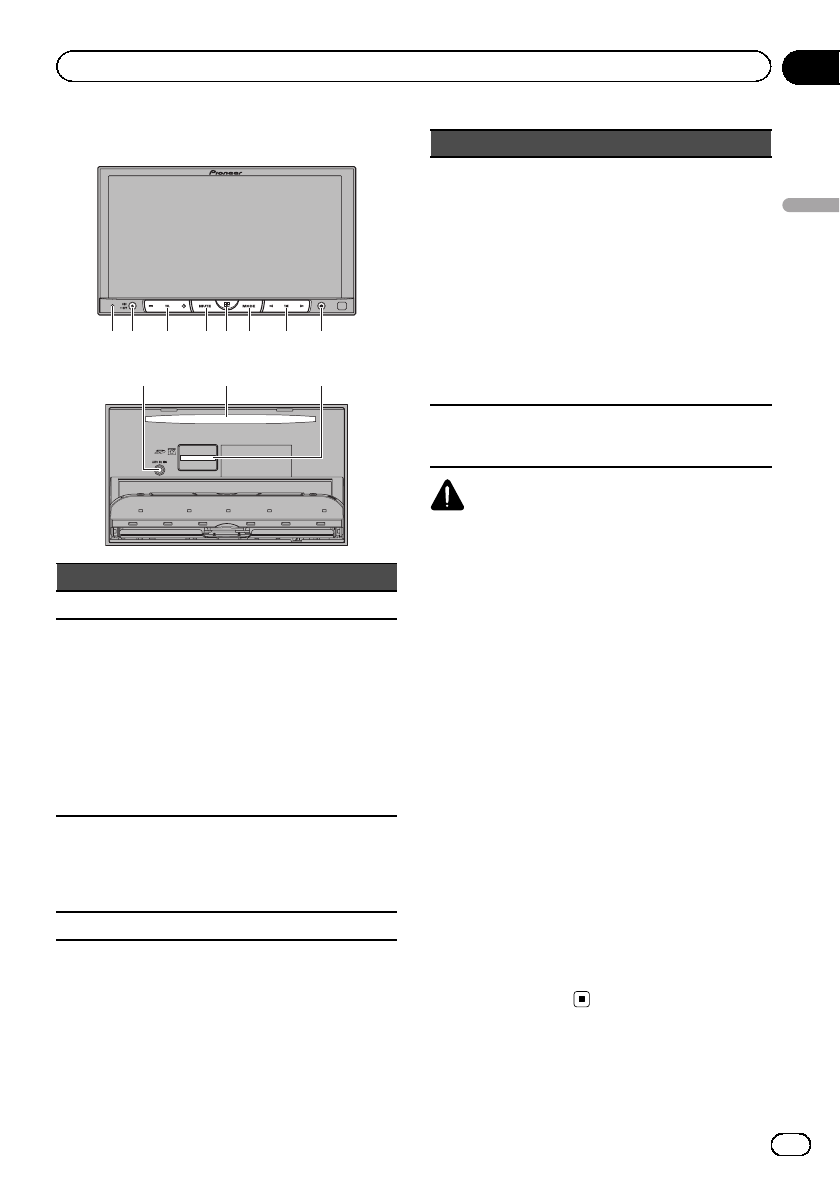
Head unit
12 3 5 6 7
48
9 a b
Part Part
1RESET 7c/d(TRK)
2SRC/OFF 8
h(eject)
Refer to Ejecting a
disc on page 17.
Refer to Ejecting an
SD on page 18.
Refer to Adjusting
the LCD panel angle
on page 17.
Refer to Removing
the front panel on
page 18.
3+/–(VOLUME/
VOL)9
Auto EQ micro-
phone input jack
Use to connect an
auto EQ micro-
phone.
4MUTE aDisc loading slot
Part Part
5
HOME
Displaying the
HOME display.
The display returns
to the Launcher
screen while a 3rd-
party application is
being used in Ad-
vanced App Mode.
Doubleclicking the
icon on the Launch-
er screen returns
the display to the
HOME display.
bSD memory card
slot
6
MODE
Turning the infor-
mation display off.
CAUTION
!Do not use unauthorized products.
!When inserting an SD card into the card slot,
make sure that the label is facing up and
press the card until it clicks and completely
locks into place.
Notes
!When the navigation system is connected,
press MODE to switch to the navigation dis-
play. Press MODE and hold to turn the display
off.
Press MODE again to turn the display on.
!For details on how to operate a navigation sys-
tem from this unit, refer to its operation man-
ual.
!When an iPhone that is running an applica-
tion that supports Advanced App Mode is con-
nected, press MODE to switch to the
application display. You can use the applica-
tion by touching the display.
!About the way to connect the USB portable
audio player/USB memory to this unit, refer to
When connecting with optional CD-IU201V
cable on page 84.
En 11
Section
03
What’s what
What’s what
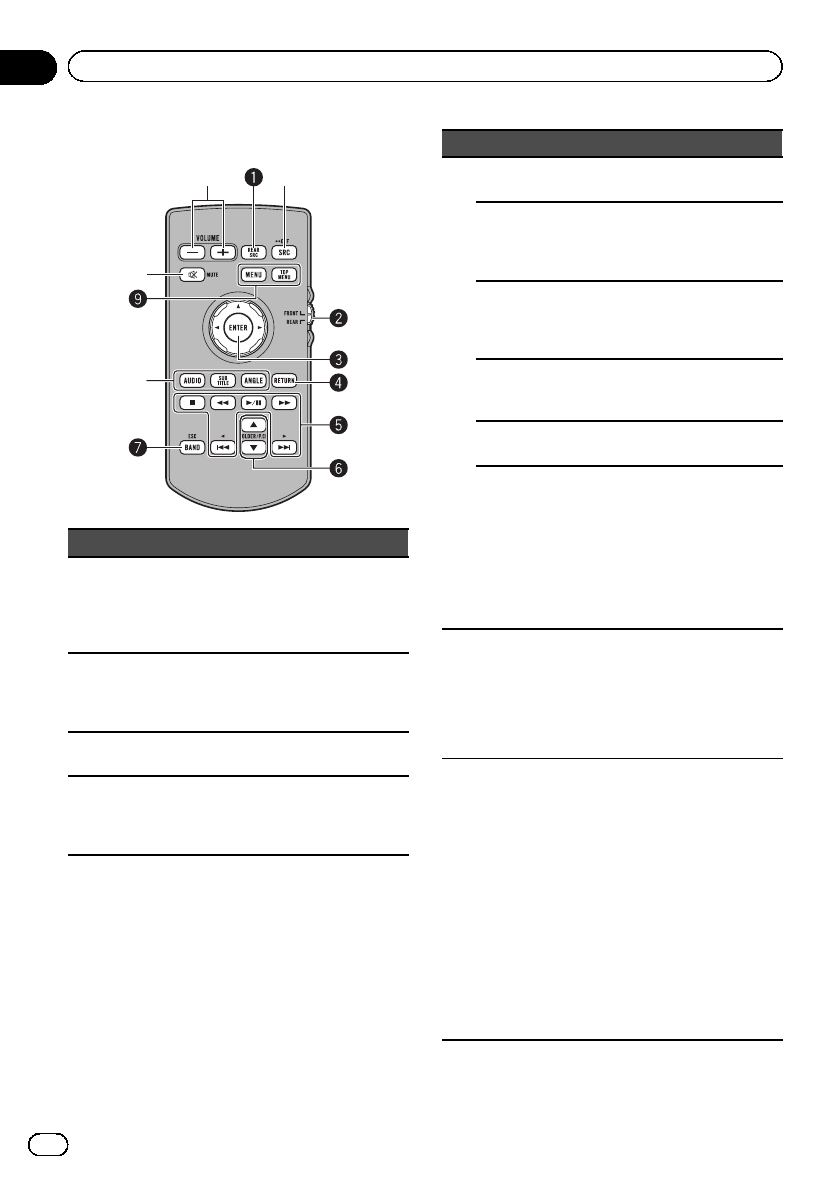
Remote control
32
4
8
Part Operation
1REAR SRC
Press to cycle through
all the available rear
sources.
Press and hold to turn
the rear source off.
2Source mode select
switch
Use to switch the
source mode between
the front source and
the rear source.
3Thumb pad Use to select a menu
on the DVD menu.
4RETURN
Press to display the
PBC (playback con-
trol) menu during PBC
playback.
Part Operation
5
fPress to pause or re-
sume playback.
m
Press to perform fast
reverse.
Press to change the
fast reverse speed.
n
Press to perform fast
forward.
Press to change the
fast forward speed.
o
Press to return to the
previous track (chap-
ter).
pPress to go to the next
track (chapter).
g
Press to stop play-
back.
If you resume play-
back, playback will
start from the point
where you stopped.
Touch the key again to
stop playback comple-
tely.
6a/b(FOLDER/P.CH)
Press to select the
next/previous disc/
folder.
Press to recall radio
station frequencies as-
signed to preset tun-
ing keys.
7BAND/ESC
Press to select the
tuner band when
tuner is selected as a
source. Also used to
cancel the control
mode of functions.
Press to switch be-
tween modes when
playing from discs or
external storage de-
vices(USB, SD) with
compressed audio
and audio data (CD-
DA) such as with CD-
EXTRA and MIXED-
MODE CDs.
En
12
Section
03 What’s what
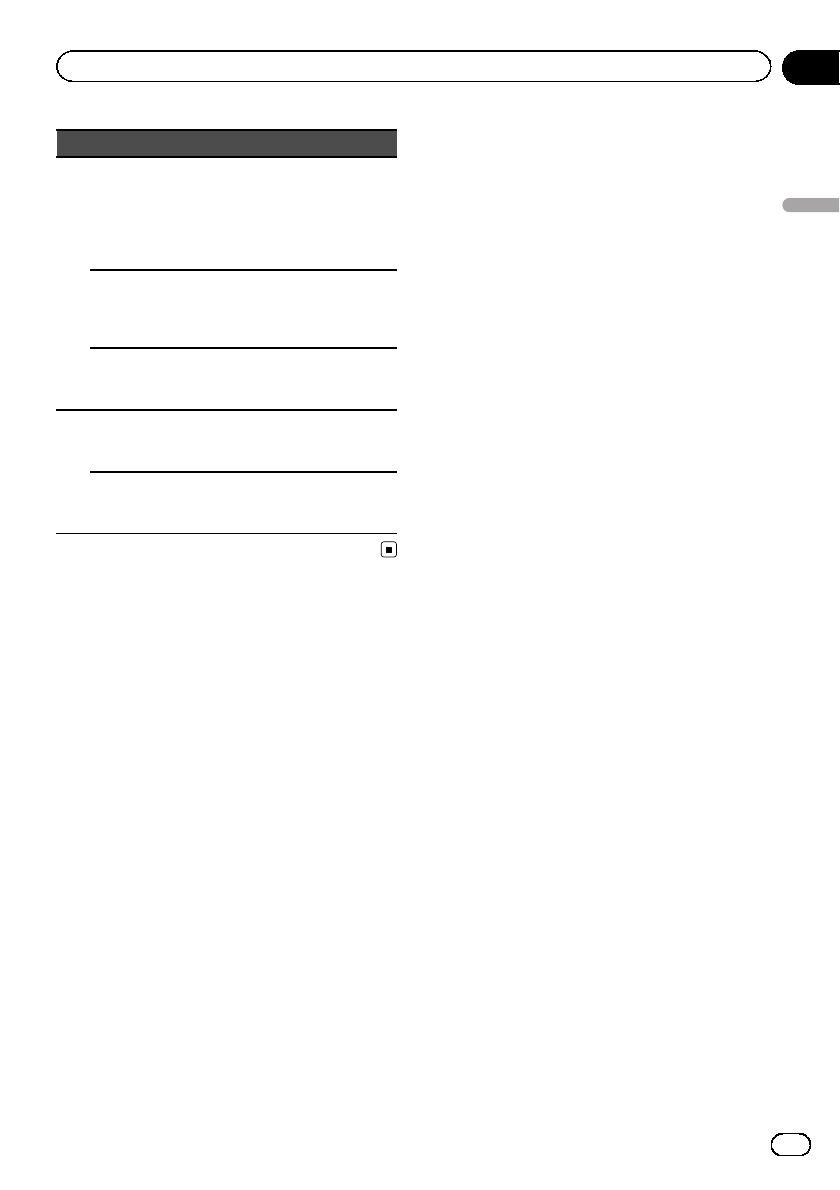
Part Operation
8
AUDIO
Press to change the
audio language during
DVD playback.
Press to switch audio
output for DivX/
MPEG-4.
SUBTITLE
Press to change the
subtitle language dur-
ing DVD/DivX/MPEG-4
playback.
ANGLE
Press to change the
viewing angle during
DVD playback.
9
MENU
Press to display the
DVD menu during
DVD playback.
TOP MENU
Press to return to the
top menu during DVD
playback.
En 13
Section
03
What’s what
What’s what
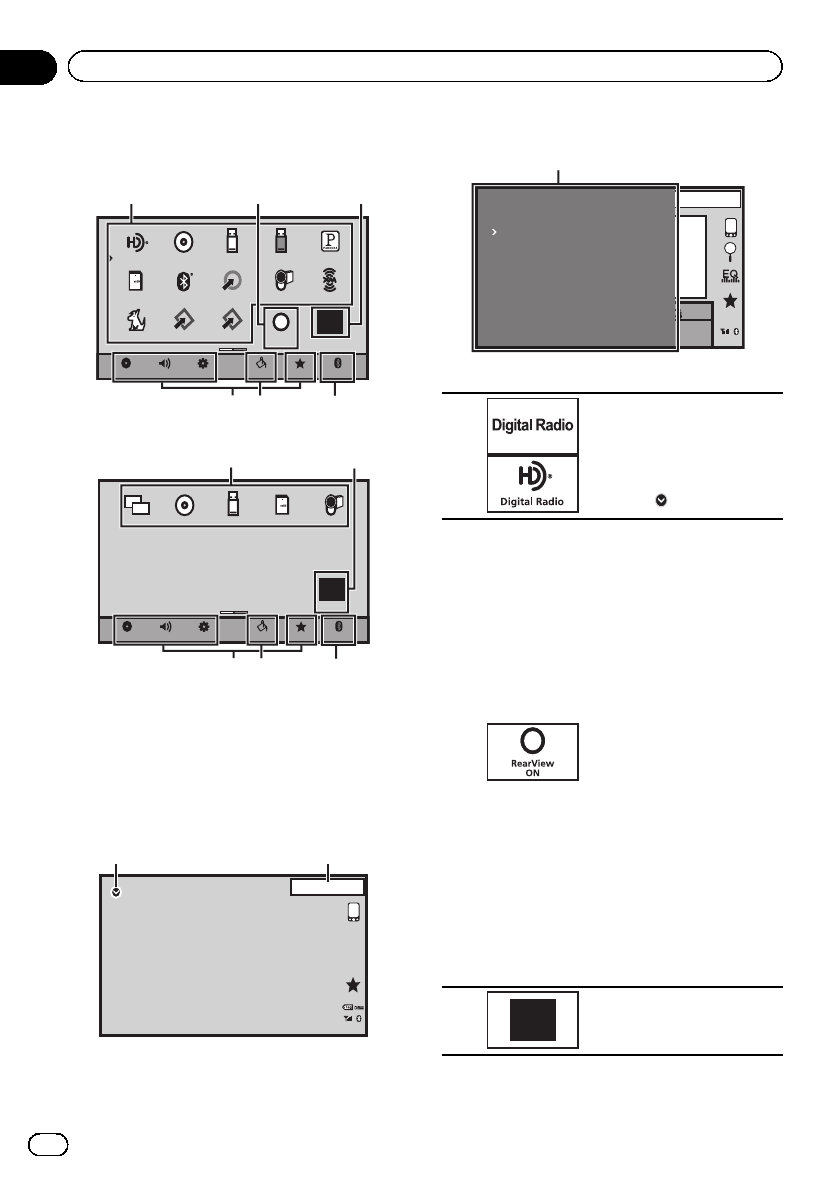
Basic operations
HOME display (Front)
FRONT
BluetoothFavoriteThemeSystem
Settings
AudioVideo
RearView
ON
USB/iPod1 USB/iPod2
Bluetooth Audio AUX AV
Disc
OFF
XM
Digital Radio Pandora
SD
SIRIUS EXT1 EXT2
23
1
456
HOME display (Rear)
REAR
BluetoothFavoriteThemeSystem
Settings
AudioVideo
USB/iPod1
DiscMirror SD AV
456
31
OFF
Flick/drag the icon to switch between Front
and Rear for HOME display. Make sure to
touch the display to flick/drag them.
The following section describes how to switch
the output source for the rear monitor. Refer to
Setting rear monitor output on page 74.
Source off display
13 APR
PM
12:25
OFF
7 8
Source on display
03.APR
PM
12:25
Digital Radio
Pandora
DISC
AUX
iPod 1
Bluetooth Audio
1
Touch panel keys
1
Source icon
Selecting a favorite source.
When the source icon is not
displayed, it can be displayed
by pressing the home key or
touching .
2
Displaying the rear view
image by turning the rear
view image on.
When the rear view image is
displayed, you can switch to
the source display by touch-
ing the display. You can oper-
ate from the source display
temporarily at this time. If
you do not perform any op-
erations within a few sec-
onds, the display will return
to the rear view image.
To turn off the rear view
image, press HOME to re-
turn to the HOME display
and then press the touch key
again.
This unit can be setup to dis-
play the rear view image
automatically when you
move the shift lever to the
REVERSE (R) position. For
details about the settings,
refer to Setting the rear view
camera (back up camera) on
page 65.
3
OFF
Turning the source off.
En
14
Section
04 Basic operations
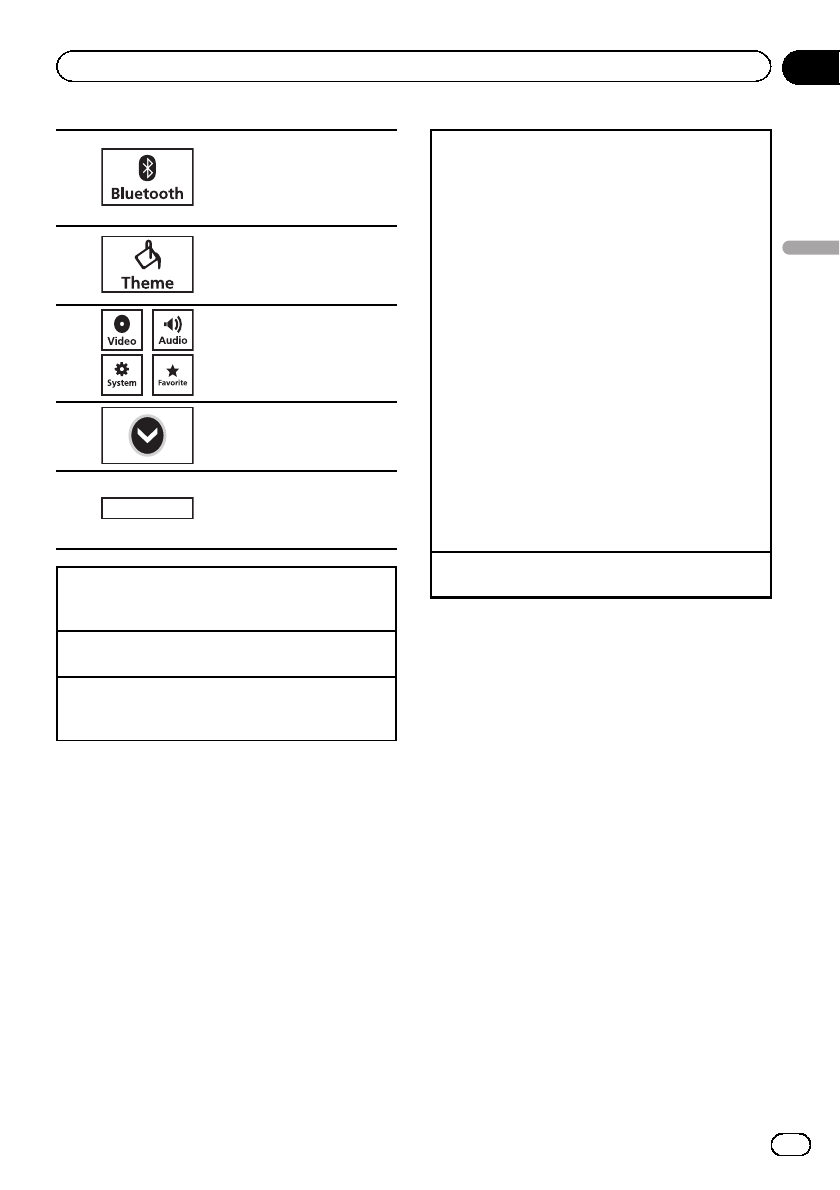
4
Displaying the Bluetooth
connection menu.
Refer to Introduction of
Bluetooth connection menu
operations on page 70.
5
Displaying the Theme menu.
Refer to Introduction of
Theme setting menu opera-
tions on page 72.
6
Displaying the menu.
Refer to Menu operations on
page 55.
7Displaying the source menu.
813 APR
PM
12:25
Switching to clock adjust-
ment display.
Refer to Setting the clock on
page 19.
Switching to HOME display
1Press HOME when you want to switch the dis-
play.
Turning the source on using the buttons
1Press SRC/OFF to turn the source on.
Turning the source off using the buttons
1Press SRC/OFF and hold until the source turns
off.
Selecting a source using the buttons
1Press SRC/OFF to cycle through the sources
listed below:
Selecting a source using the touch panel keys
1Touch the source icon and then touch the desired
source name.
!XM –XM tuner
!SIRIUS –SIRIUS tuner
!Radio –Built-in Digital Radio tuner
!Disc –Built-in DVD player
!USB/iPod 1 –USB/iPod 1
!USB/iPod 2 –USB/iPod 2
!Pandora –Pandoraâinternet radio
!SD –SD memory card
!Bluetooth Audio –Built-in Bluetooth audio
!AUX –AUX
!AV –AV input
!EXT 1 –External unit 1
!EXT 2 –External unit 2
!When the source icon is not displayed, it can be
displayed by touching the screen.
!While operating the menu, you cannot select a
source by touching the source icon.
Adjusting the volume
1Press +/–(VOLUME/VOL) to adjust the volume.
Notes
!In this manual, iPod and iPhone will be re-
ferred to as “iPod”.
!The USB/iPod 1 or USB/iPod 2 icon will
change as follows:
—USB 1 is displayed when a USB storage de-
vice is connected to USB input 1.
—iPod 1 is displayed when an iPod is con-
nected to USB input 1.
—USB 2 is displayed when a USB storage de-
vice is connected to USB input 2.
—iPod 2 is displayed when an iPod is con-
nected to USB input 2.
—STEEZ is displayed when a
STEEZ PORTABLE (Pioneer product) is
connected to USB input 1 or USB input 2.
—USB/iPod 1 or USB/iPod 2 is displayed
when no device is connected.
En 15
Section
04
Basic operations
Basic operations
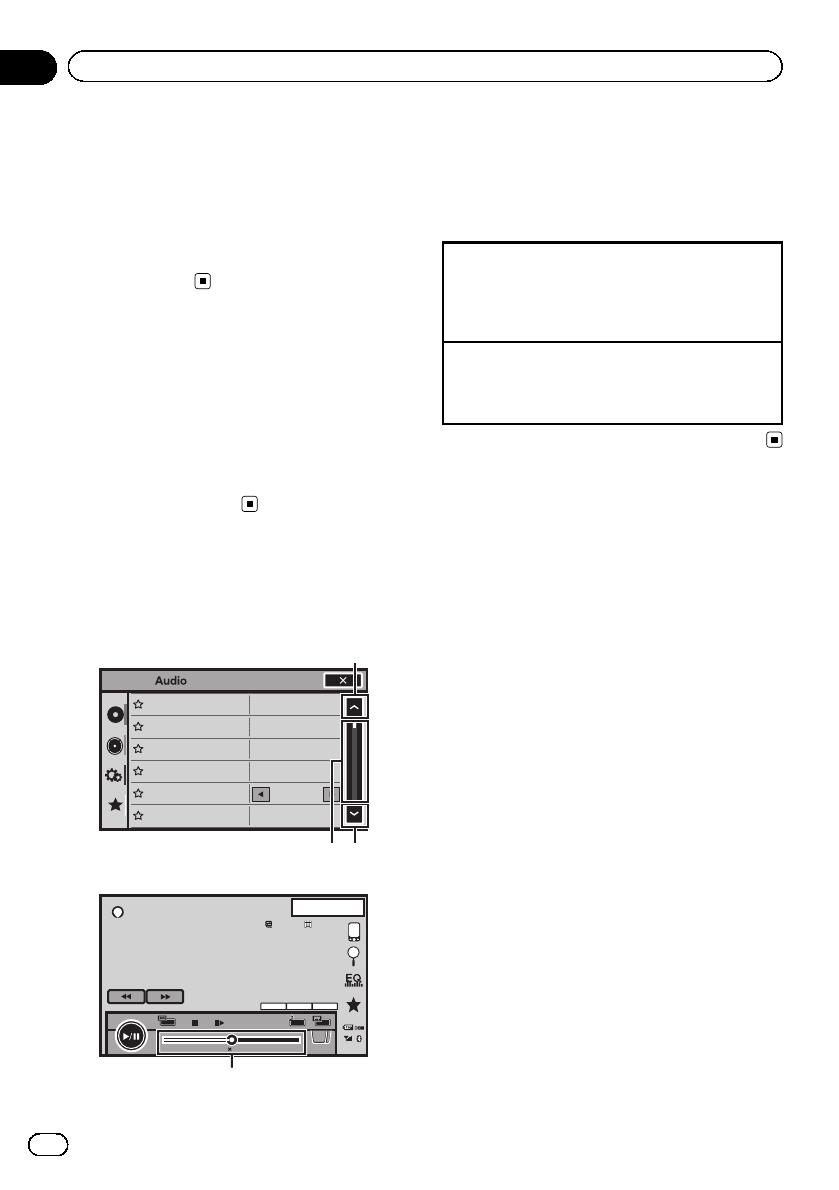
!An external unit refers to a Pioneer product,
such as those which will be available in the fu-
ture. Although incompatible as a source, the
basic functions of up to two external units can
be controlled with this unit. When two exter-
nal units are connected, the external units are
automatically allocated to external unit 1 or
external unit 2.
USB/iPod 1 and USB/iPod 2
This unit has USB/iPod 1 and USB/iPod 2
sources.
In USB/iPod 2, the following functions are not
available.
—Pandora
—Advanced App Mode
—Rear monitor output
Operating the scroll icon
and the scrubber bar
SonicCenter Control FR:0
Powerful
On
LR:0
LR:0
OFF
ON
Loudness
Subwoofer
Bass Booster
High Pass Filter
Source Level Adjuster
Fader/Balance F/R 0
Powerful
Off
L/R 0
L/R 0
OFF
ON
Graphic EQ
Auto EQ
Sonic Center Control
Loudness
Subwoofer
1
1
2
DVD-V 13.APR
PM
12:25
2-01:00
01:00
2ch
48kHz 16bit
Dolby D
MENU MENU
TOP
1/2
XX XX
XXXXXXXXXXXXXXXX
2
1Scroll icon
Appears when selectable items are hidden.
2Scrubber bar
Appears when items cannot be displayed on a
single page only.
Viewing the hidden items
1Touch the scroll icon or drag the scrubber bar to
view any hidden items.
!Also, you can drag the list to view any hidden
items.
Specifying the playback point
1Drag the scrubber bar on the screen.
(Not available when the scrubber bar is grayed
out.)
En
16
Section
04 Basic operations
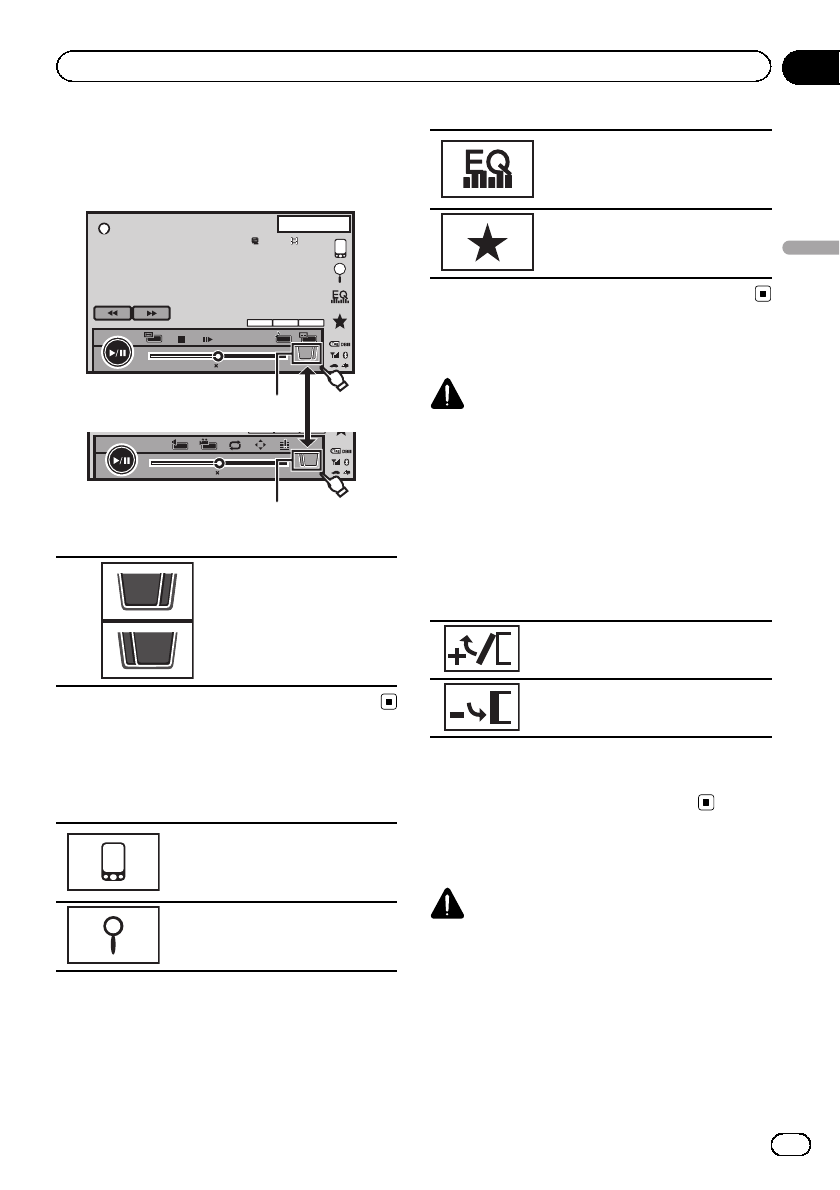
Activating the touch panel
keys
2-01:00
01:00
y
Return
2/2
DVD-V 13.APR
PM
12:25
2-01:00
01:00
2ch
48kHz 16bit
Dolby D
MENU MENU
TOP
1/2
XX XX
XXXXXXXXXXXXXXXX
1
1
Touch panel keys
1
1/2
2/2
Switching the touch keys on
the display.
Common operations for
menu settings/lists
Starting the Bluetooth telephone
menu.
Refer to Introduction of Bluetooth
telephone operations on page 37.
Displaying the list menu.
Starting the search function.
Displaying the EQ (Audio function
menu).
Refer to Using the equalizer on
page 56.
Displaying the Favorite menu.
Refer to Favorite menu on page 69.
Adjusting the LCD panel angle
CAUTION
Keep hands and fingers clear of the unit when
opening, closing, or adjusting the LCD panel. Be
especially cautious of children’s hands and fin-
gers.
1 Press h(eject) to display the ejecting
menu.
2 Adjust the LCD panel to an easily view-
able angle.
Laying the panel down.
Returning the panel to the upright
position.
#As the set angle is saved, the LCD panel will
automatically be adjusted to the same position
the next time the LCD panel is opened.
Ejecting a disc
CAUTION
Keep hands and fingers clear of the unit when
opening, closing, or adjusting the LCD panel. Be
especially cautious of children’s hands and fin-
gers.
1 Press h(eject) to display the ejecting
menu.
En 17
Section
04
Basic operations
Basic operations
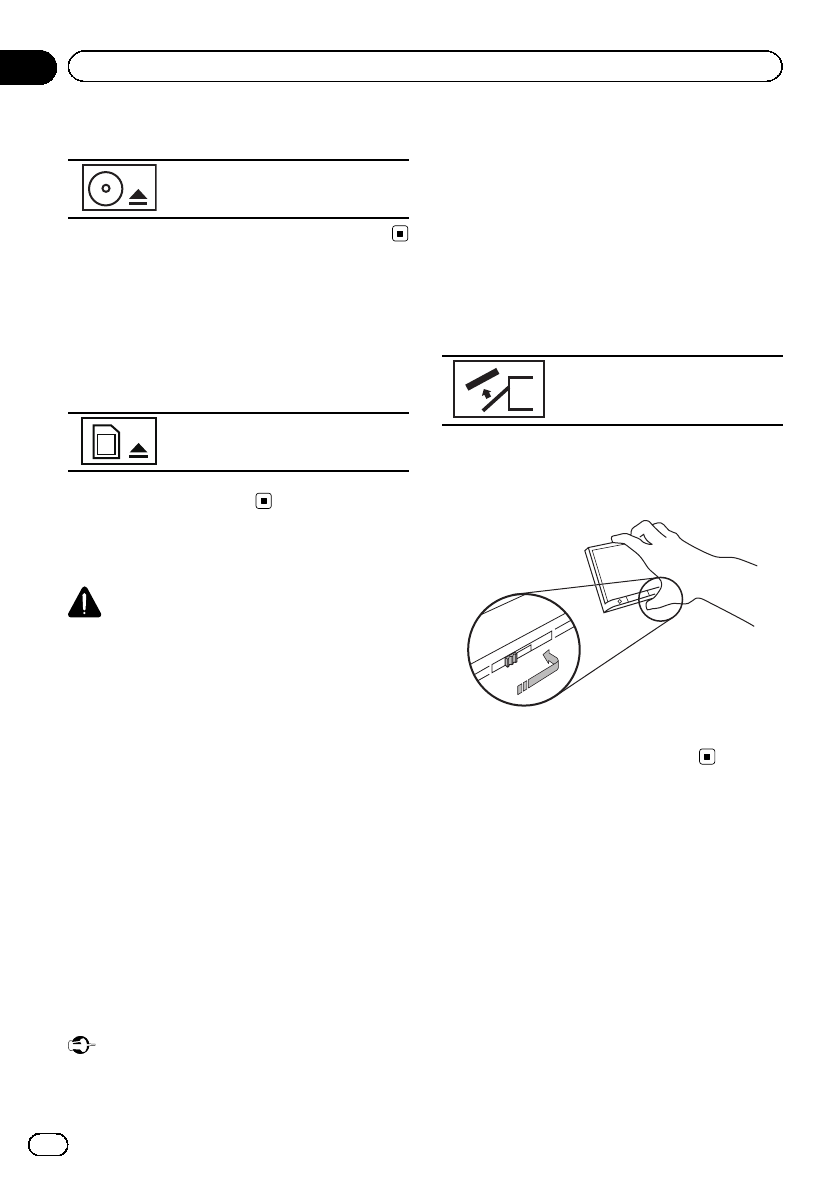
2 Eject a disc.
Ejecting a disc.
Ejecting an SD
1 Press h(eject) to display the ejecting
menu.
2 Eject an SD.
Ejecting an SD.
3 Press an SD to eject.
Removing the front panel
CAUTION
!Do not attempt to detach the front panel while
DISC/SD is in the eject position.
!Do not attempt to detach the front panel while
data is being written to USB/SD.
Doing so may cause the data to become cor-
rupted.
!After the front panel has been detached, the
attaching plate will move back to its original
position automatically.
Be careful not to let hands or other objects
get caught behind the monitor as it is moving
back.
!Please make sure that the front panel is in its
original position while the vehicle is in mo-
tion.
It is dangerous to drive with the front panel
sticking out.
!Do not place beverages or other objects on
top of the front panel while it is fully open.
Important
!Handle gently when removing or attaching
the front panel.
!Avoid subjecting the front panel to excessive
shock.
!Keep the front panel out of direct sunlight and
high temperatures.
!If removed, replace the front panel on the unit
before starting up your vehicle.
1 Press h(eject) to release the front
panel.
2 Touch the detach key.
The front panel automatically
slides toward you.
3 Slide the dial at the bottom of the front
panel to the right, and lift up the front
panel while pushing down on the dial.
4 Put the front panel into the provided
protective case for safe keeping.
Attaching the front panel
1 Slide the front panel into the top of the
unit and push it into place.
Slide the inserter on the front panel into the in-
sertion slot on top of the unit and push it into
place.
En
18
Section
04 Basic operations
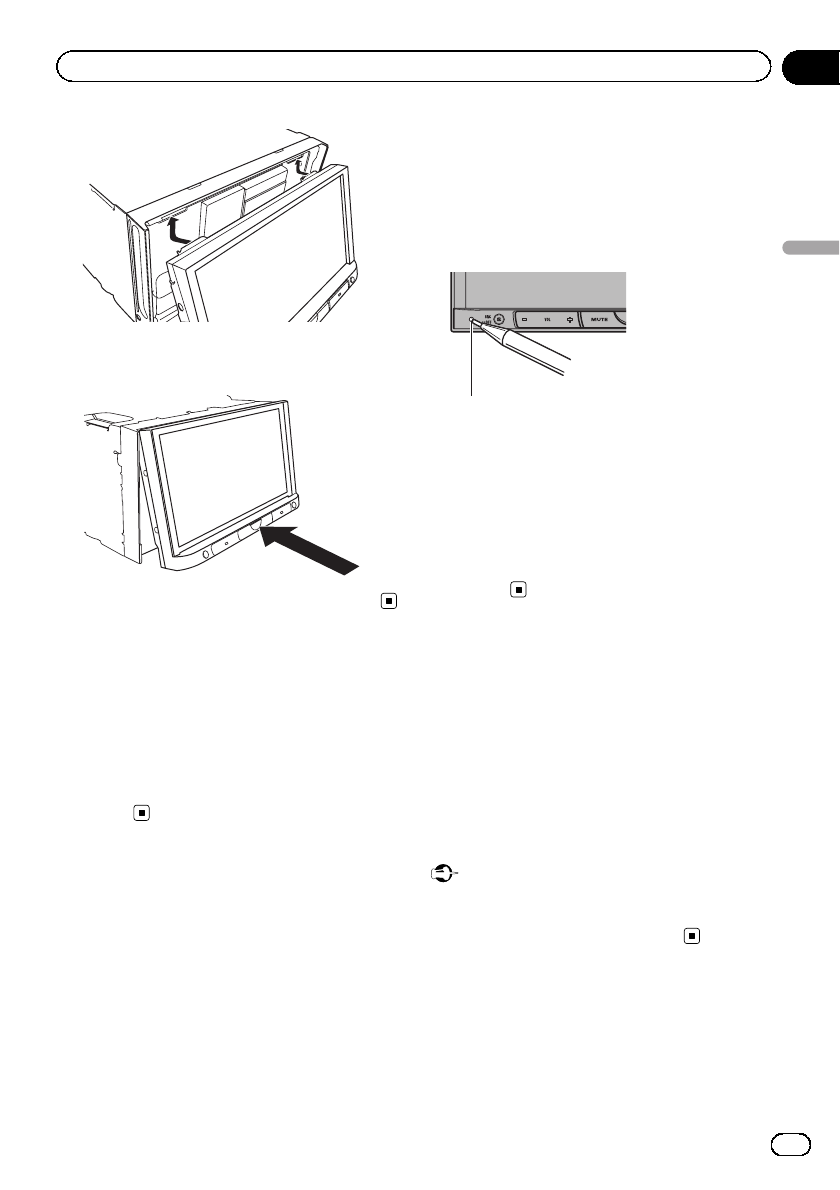
2 Push on the bottom of the front panel
until it clicks into place.
Setting the clock
1 Switch to Clock Adjustment display.
Refer to Basic operations on page 14.
2 Select the item to set.
3 Touch aor bto set the correct date
and time.
Resetting the microprocessor
By pressing RESET, you can reset the micro-
processor to its initial settings without chan-
ging the bookmark information.
The microprocessor must be reset in the fol-
lowing situations:
!Before using this unit for the first time after
installation
!If the unit fails to operate properly
!When strange or incorrect messages ap-
pear on the display
1 Turn the ignition switch OFF.
2 Press RESET with a pen tip or other
pointed instrument.
RESET button
Note
Switch your engine ON or set the ignition switch
to ACC ON before pressing RESET in the follow-
ing situations:
!After completing connections
!When erasing all stored settings
!When resetting the unit to its initial (factory)
settings
Demo mode
The feature demo automatically starts when
you select Off for the source and continues
while the ignition switch is set to ACC or ON.
To cancel the feature demo, press and hold
MUTE. Press and hold MUTE again to restart.
Operating the feature demo while the car en-
gine is turned off it may drain the battery
power.
Important
Failure to connect the red lead (ACC) of this unit
to a terminal coupled with ignition switch on/off
operations may lead to battery drain.
En 19
Section
04
Basic operations
Basic operations
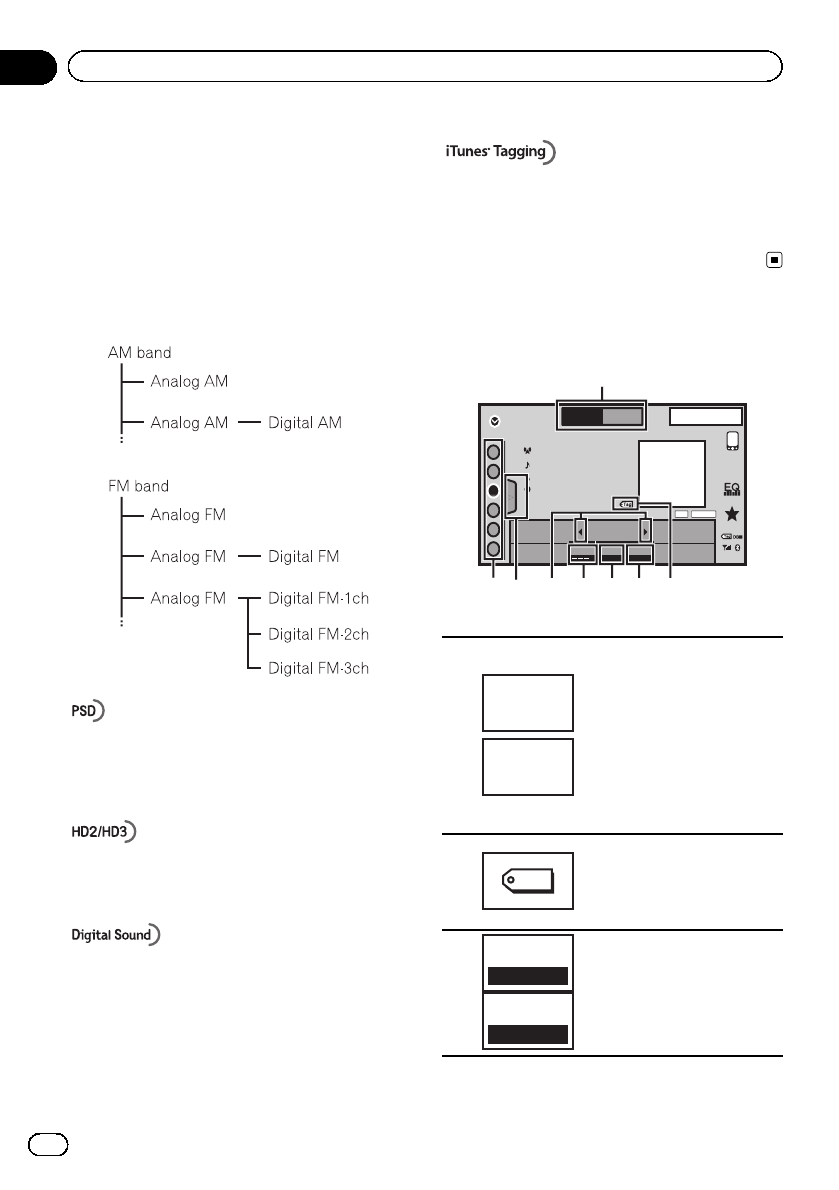
About HD Radioä
broadcasting
HD Radioäbroadcasting is high quality audio
and data services. HD Radio broadcasting is
brought to you by your local FM/AM stations.
HD Radio broadcasting features the following:
!High quality audio
!FM multicasting
!Data services
Program Service Data: Contributes to the superior user
experience of HD Radio Technology. Presents song
name, artist, station IDs, HD2/HD3 Channel Guide, and
other relevant data streams.
Adjacent to traditional main stations are extra local FM
channels. These HD2/HD3 Channels provide new, origi-
nal music as well as deep cuts into traditional genre.
Digital, CD-quality sound. HD Radio Technology enables
local radio stations to broadcast a clean digital signal.
AM sounds like today’s FM and FM sounds like a CD.
iTunesâTagging provides you the opportunity to discover
a wide range of content and the means to “tag”that con-
tent for later review and purchase from the iTunesâ
Store.
Introduction of HD Radio
tuner operations
Radio
13 APR
PM
12:25
1
2
3
4
5
6
WWWWWWWWWWWW
W
WWWWWWWWWWWWWWW
W
WWWWWWWWWWWWWWW
W
WWWWWWWWWWWWWWW
W
FM AM1
HD
Local Seek
HD
Blending
D/A AUTO
87.9MHz
DIGITAL
1
435786 2
Touch panel keys
1
FM1
AM
Selecting a band (FM or AM)
by touching the band key.
The touch panel key for the
selected band is highlighted.
Switching between FM1,
FM2, and FM3 by touching
the band key.
When AM is selected, you
cannot switch to another AM
band by touching the band
key.
2Tag
Saving song information (tag)
from the broadcasting station
to your iPod.
Refer to Using iTunes tagging
on page 39.
3
Blending
D/A AUTO
Blending
ANALOG
Switching to the analog
broadcast of the same fre-
quency.
Refer to Switching the recep-
tion mode on page 51.
En
20
Section
05 HD Radioätuner
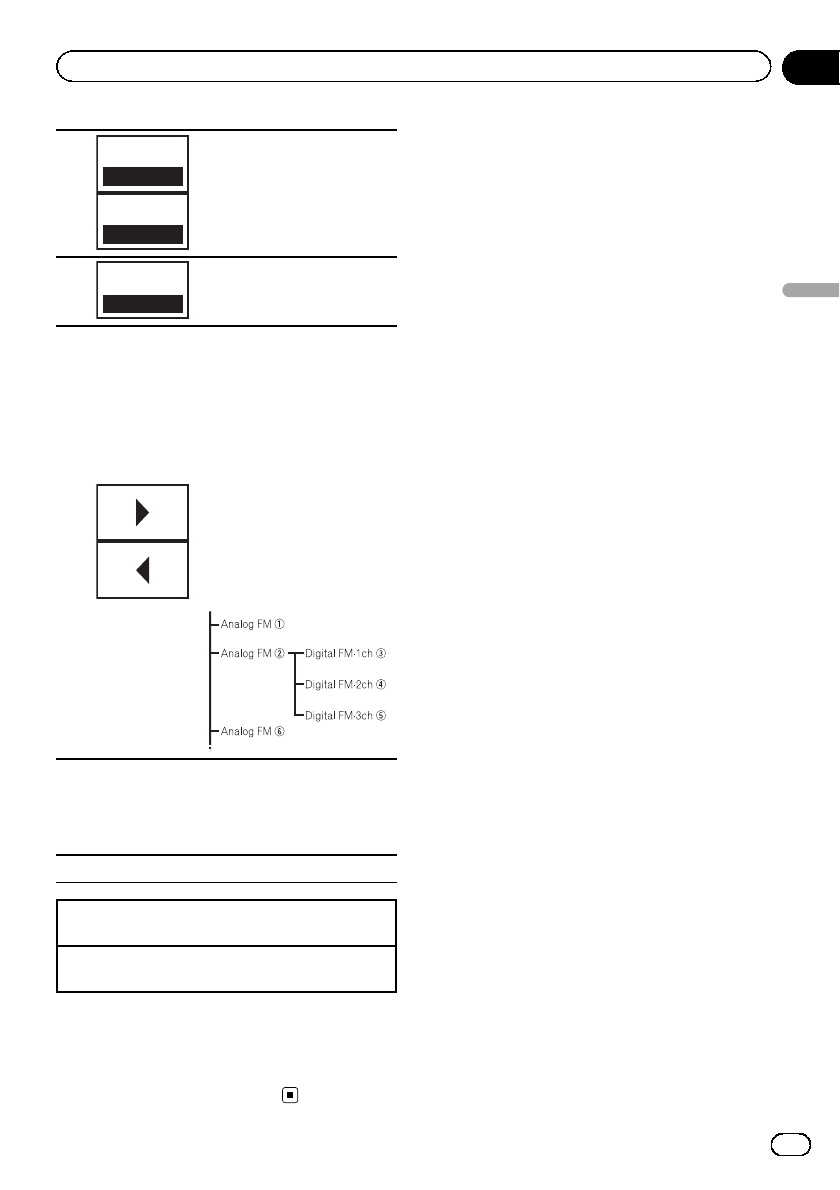
4
Seek
ALL
Seek
HD
Switching between Digital
broadcasting station seek and
normal seek.
Refer to Switching the seek
mode on page 51.
5Local Setting the local seek level.
Refer to Tuning in to strong
signals on page 39.
6
Tuning up or down manually.
Touch and hold for more than
two seconds to skip stations.
Seek tuning starts as soon as
you release. Touch again to
cancel seek tuning.
!When an analog station is
received, tuning down op-
eration is conducted with-
in the analog
broadcasting. (6d2)
!If a digital broadcast is
not yet received, tuning-
up operation tunes in the
next analog station. (2d
6)
7
Displaying the preset channel list.
Refer to Storing and recalling stations on page
39.
Refer to Storing the strongest stations on page
39.
8Select a preset channel.
Switching preset channels using the buttons
1Press cor d(TRK).
Seek tuning using the buttons
1Press and hold cor d(TRK).
Note
Touch panel keys not listed under Introduction of
HD Radio tuner operations may appear on the dis-
play.
Refer to Indicator list on page 98.
En 21
Section
05
HD Radioätuner
HD Radioätuner
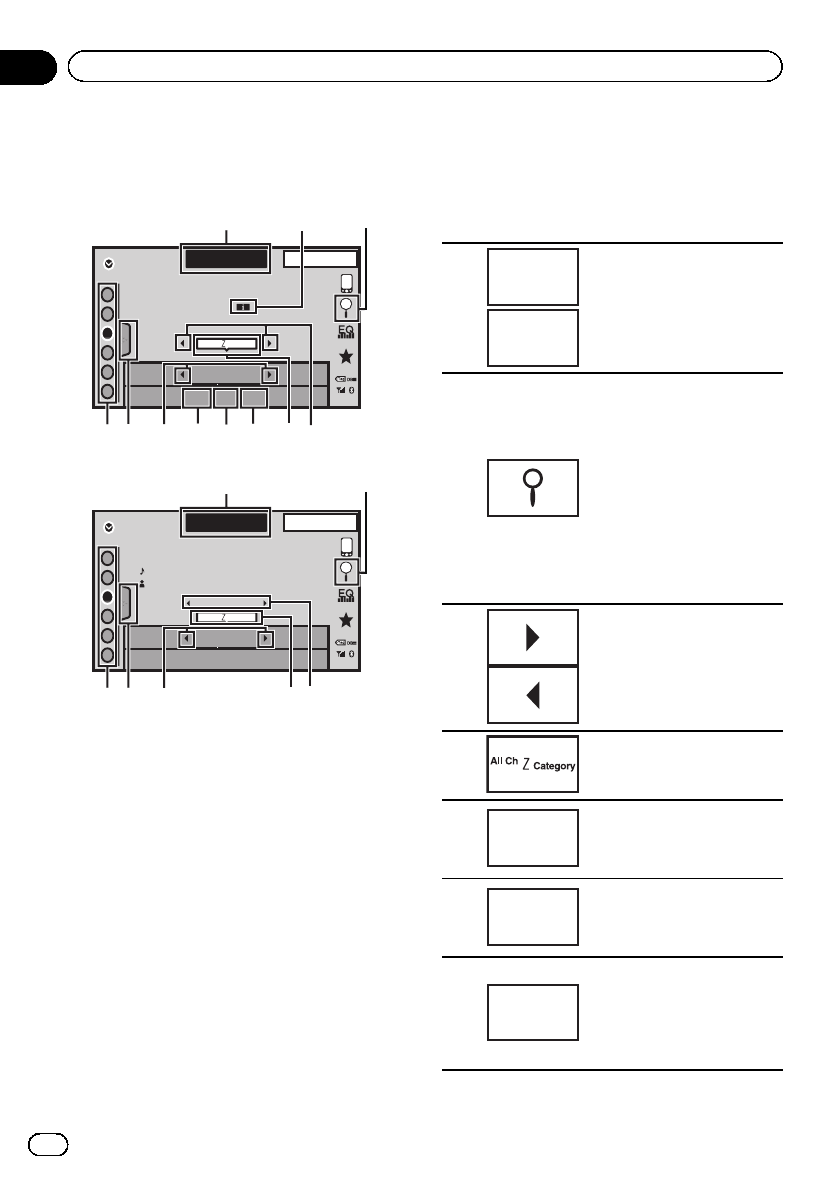
Introduction of XM/SIRIUS
tuner operations
SIRIUS tuner
SIRIUS
13 ARP
PM
12:25
1
2
3
4
5
6
888
CH
Game
Info
Instant
Replay
Team
Sett ing
SIRIUS 1
WWWWWWWWWWWW
W
CH
All Ch Category
21
569a78
1
34
XM tuner
XM
13 ARP
PM
12:25
1
2
3
4
5
6
888
CH
XM 1
All Ch Category
WWWWWWWWWW
W
WWWWWWWWWWWW
W
WWWWWWWWWWWW
W
Dance/Electronic
21
49a38
You can use this unit to control an XM satellite
digital tuner (GEX-P920XM), which is sold se-
parately.
You can use this unit to control a SIRIUS Satel-
lite Radio tuner, which is sold separately.
For details concerning operation, refer to the
XM tuner’s operation manuals. This section
provides information on XM operations with
this unit which differs from that described in
the XM tuner’s operation manual.
When the SIRIUS tuner is used together with
this unit, some operations differ slightly from
those described in the SIRIUS operation man-
ual. This manual provides information on
these points. For all other information on
using the SIRIUS tuner, please refer to the SIR-
IUS operation manual.
!With this unit, you can operate one addi-
tional function: XM/SIRIUS channel direct
selection. Refer to Selecting an XM/SIRIUS
channel directly on page 49.
Touch panel keys
1
XM1
SIRIUS1
Selecting a band (XM1,XM2
or XM3) for XM tuner.
Selecting a band (SIRIUS1,
SIRIUS2 or SIRIUS3) for the
SIRIUS tuner.
2
Displaying the preset chan-
nel list.
Refer to Storing and recalling
stations on page 39.
Selecting a channel directly.
Refer to Selecting an XM/SIR-
IUS channel directly on page
49.
Selecting a channel from the
XM channel list.
Refer to Selecting a channel
from the XM channel list dis-
play on page 49.
3
Selecting a channel or cate-
gory.
Refer to Switching the XM/
SIRIUS channel selection
mode on page 48.
4Selecting a channel cate-
gory.
5
Team
Setting
Selecting teams for game
alert on the SIRIUS tuner.
Refer to Selecting teams for
Game Alert on page 49.
6
Game
Info
Displaying information on
games for the SIRIUS tuner.
Refer to Displaying game in-
formation on page 50.
7
Instant
Replay
Selecting a track, fast for-
warding/reversing or paus-
ing/playing for the SIRIUS
tuner.
Refer to Using the Instant Re-
play function on page 51.
En
22
Section
06 XM/SIRIUS tuner
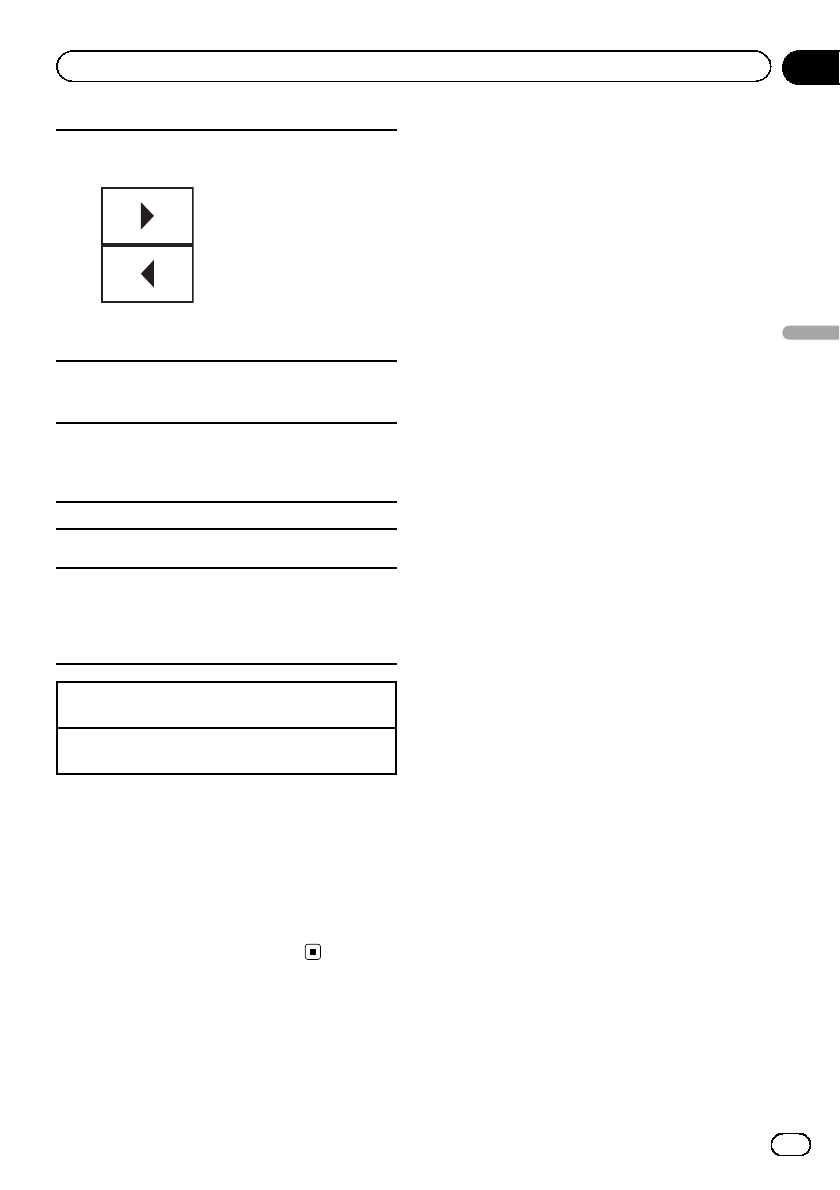
8
Recalling radio station fre-
quencies assigned to preset
tuning keys.
Refer to Storing and recalling
stations on page 39.
Selecting the channel cate-
gory when selecting Mode
Category.
Refer to Switching the XM/
SIRIUS channel selection
mode on page 48 and Select-
ing a SIRIUS channel from a
channel category on page 49.
9
Displaying the preset channel list.
Refer to Storing and recalling stations on page
39.
a
Recalling the preset channels by touching the
key.
Storing the current station in the preset channel
list by touching and holding the key.
SIRIUS tuner information
1
Switching the SIRIUS information.
Refer to Switching the SIRIUS display on page
51.
Touch and hold for more than two seconds to
scroll the text.
Manual tuning (step by step) using the buttons
1Press cor d(TRK).
Seek tuning using the buttons
1Press and hold cor d(TRK).
Notes
!You can also perform tuning from a desired
channel category. (Refer to Selecting a SIRIUS
channel from a channel category on page 49.)
!Touch panel keys not listed under Introduction
of XM/SIRIUS tuner operations may appear on
the display.
Refer to Indicator list on page 98.
En 23
Section
06
XM/SIRIUS tuner
XM/SIRIUS tuner
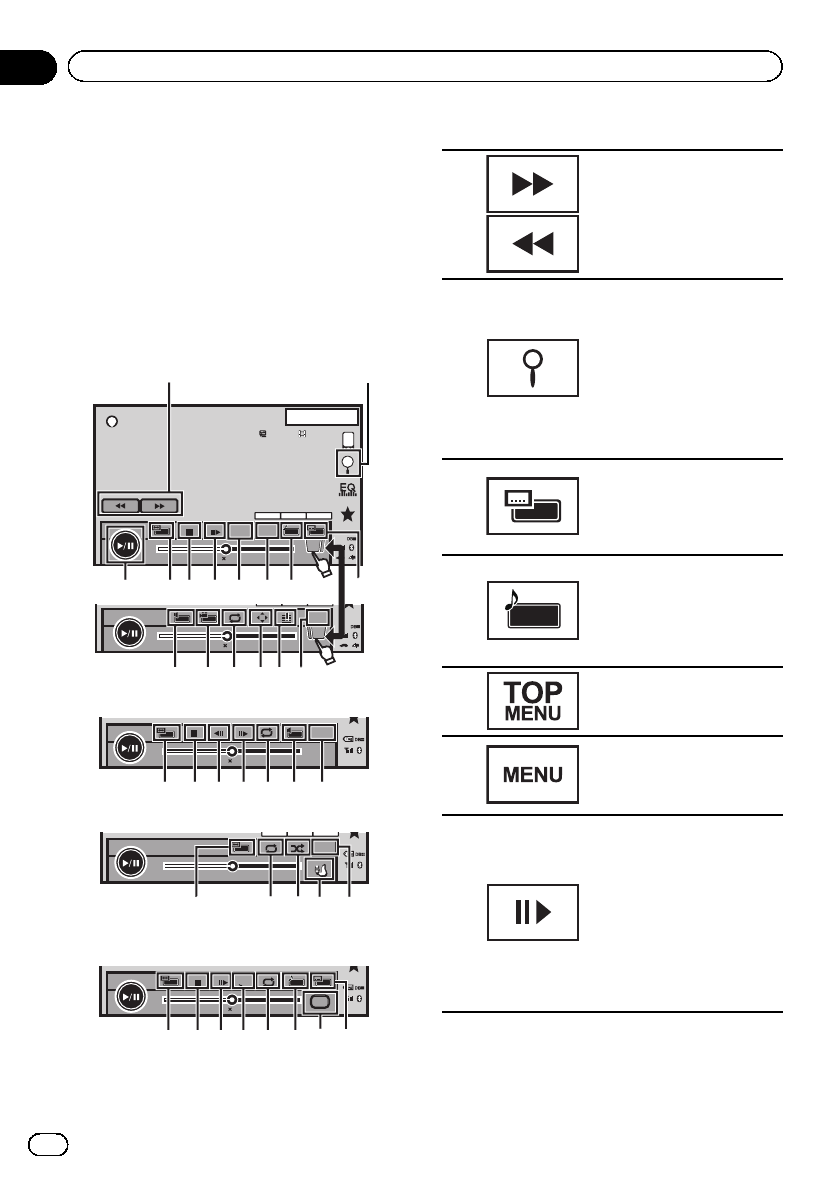
Introduction of video
playback operations
You can view DVD/DVD-R/DVD-RW/CD/CD-R/
CD-RW/USB/SD/iPod.
!Depending on your iPod, there may not be
any output unless you use CD-IU201S/CD-
IU201V (sold separately). Be sure to use
CD-IU201S/CD-IU201V to connect your
iPod.
DVD video
2-01:00
01:00
y
Return
2/2
Dolby PLll
DVD-V 13.APR
PM
12:25
2-01:00
01:00
2ch
48kHz 16bit
Dolby D
MENU MENU
TOP
1/2
XX XX
XXXXXXXXXXXXXXXX
Dolby PLll
48kHz 16bit
Dolby D2ch
21
cdefg
467895a
b
3
Video CD
8-01:00
01:00
Return
g7h8 e9b
iPod video
-01:00
01:00
2ch
48kHz
16bit
Dolby
D
S.Rtrv
Appr
Appr
Ap p
App
Ap p
Dolby
D2ch
48kHz
16bit
i9 kje
When playing a disc containing a mixture
of various media file types
2-01:00
01:00
Media
aa
798 4 3lme
Touch panel keys
1
Fast forwarding or reversing
Press to change the fast for-
ward and reverse speed.
2
Starting the search function.
Refer to Searching for the part
you want to play on page 44.
Refer to Selecting files from
the file name list on page 46.
Displaying iPod menus.
Refer to Playing videos from
your iPod on page 42 and
Browsing for a video/music
on the iPod on page 43.
3
Switching between subtitle
languages during playback.
Refer to Changing the subti-
tle language during playback
(Multi-subtitle) on page 45.
4
Switching between lan-
guages/audio systems dur-
ing playback.
Refer to Changing audio lan-
guage during playback (Multi-
audio) on page 45.
5Returning to the top menu
during DVD playback.
6
Displaying the DVD menu
during DVD playback.
Refer to Operating the DVD
menu on page 40.
7
Moving ahead one frame at a
time during playback.
Refer to Frame-by-frame play-
back on page 44.
Touch and hold for more
than two seconds to slow
down playback speed.
Speeding up the playback
speed in four steps during
slow motion playback on
DVD video/Video CD.
En
24
Section
07 Playing moving images
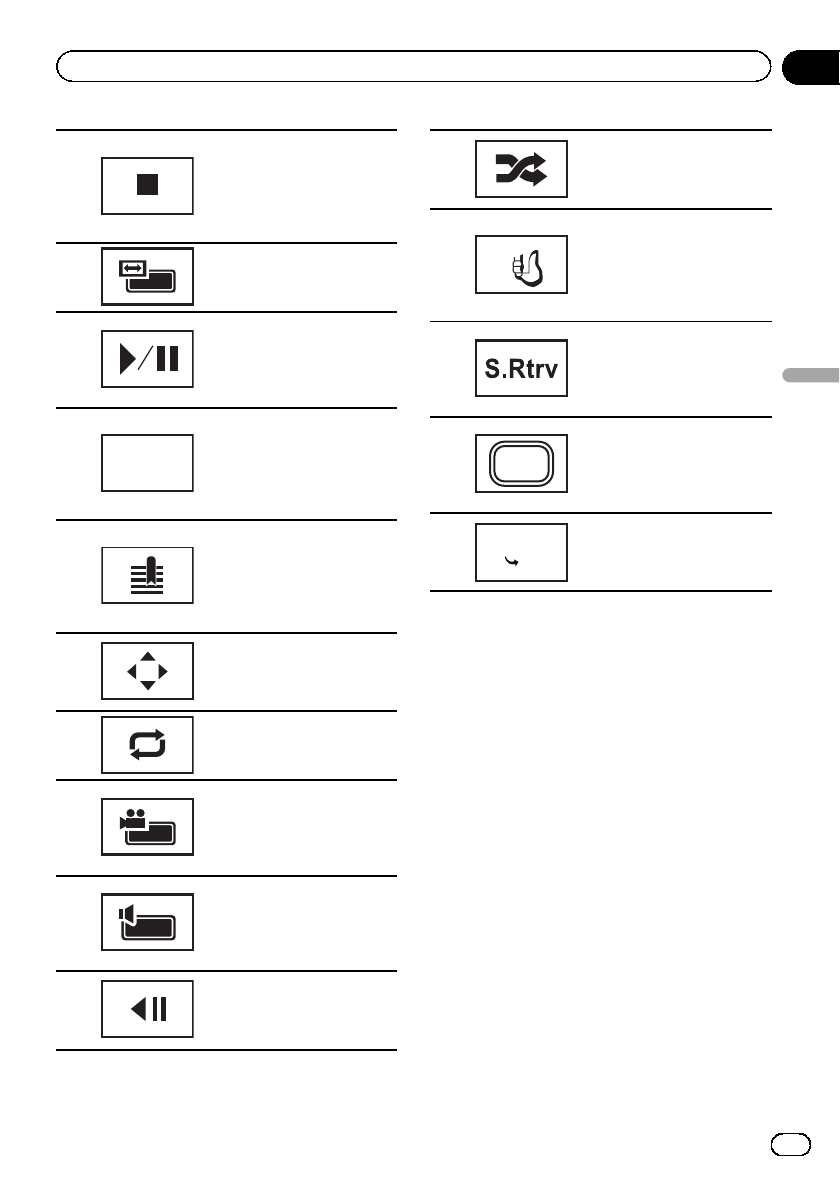
8
Stopping playback.
If you resume playback, play-
back will start from the point
where you stopped. Touch
the key again to stop play-
back completely.
9
Changing the screen mode.
Refer to Changing the wide
screen mode on page 48.
a
Pausing playback.
Returning to normal play-
back during paused, slow
motion, or frame-by-frame
playback.
bReturn
Returning to the specified
scene to which the DVD cur-
rently being played has been
preprogrammed to return.
Refer to Return to the speci-
fied scene on page 45.
c
During playback, touch the
point at which you want to re-
sume playback the next time
the disc is loaded.
Refer to Resume playback
(Bookmark) on page 44.
d
Displaying arrow keys to op-
erate the DVD menu.
Refer to Using the arrow keys
on page 40.
e
Selecting the repeat range.
Refer to Repeating playback
on page 41.
f
Switching among viewing
angles during playback.
Refer to Changing the view-
ing angle during playback
(Multi-angle) on page 45.
g
Switching the audio output,
when playing video discs re-
corded with LPCM audio.
Refer to Selecting audio out-
put on page 45.
h
Speeding down the playback
speed in four steps, during
slow motion playback on
DVD video/Video CD.
i
Playing the video on your
iPod in a random order.
Refer to Random play (shuf-
fle) on page 41.
j
Appr
Appr
Ap p
App
Ap p
Conducting operation from
your iPod and listening to it
using your car’s speakers.
Refer to Operating this unit’s
iPod function from your iPod
on page 41.
k
Switching the S.Rtrv (sound
retriever) function setting
when playing audio.
Refer to Using sound retriever
on page 46.
l
Media
Switching between media
file types to play on DVD/CD/
USB/SD.
Refer to Switching the media
file type on page 40.
maaAdjusting the images on the
display. For details, refer to
Setting the Advanced Display
Resolution on page 47.
En 25
Section
07
Playing moving images
Playing moving images
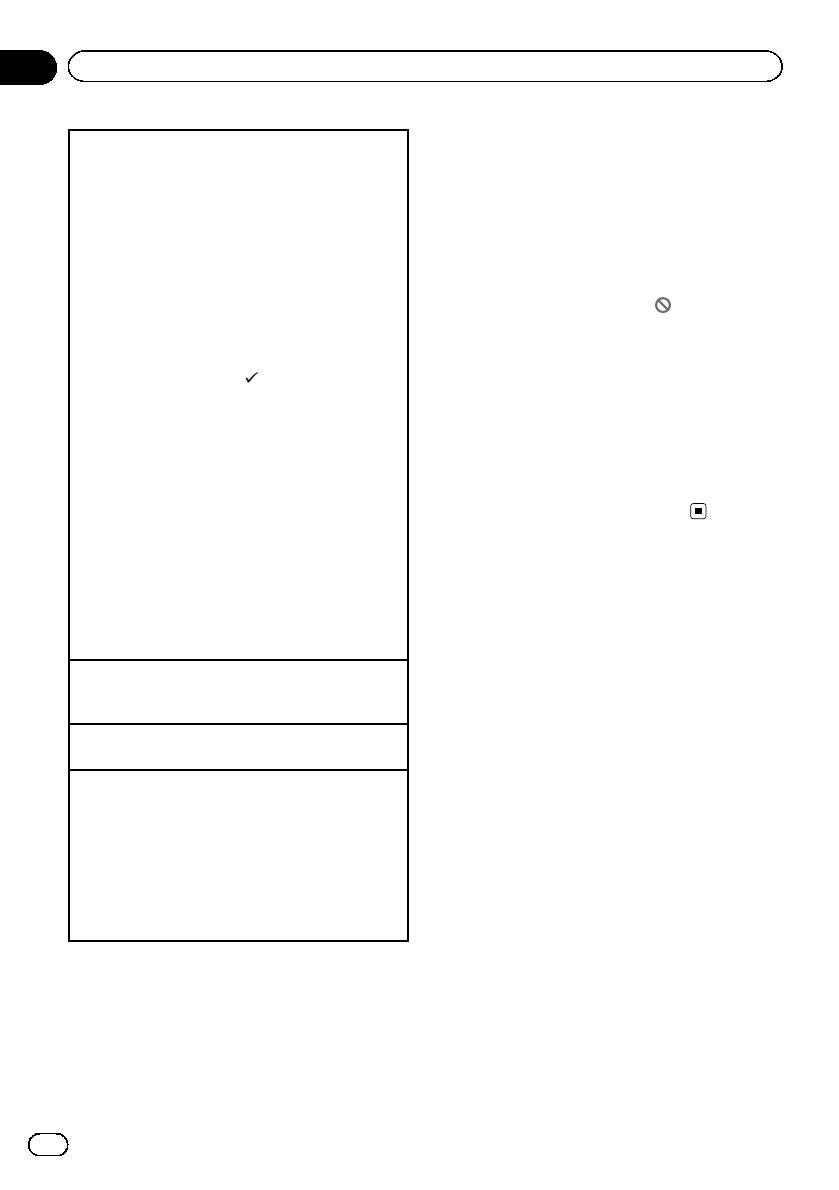
Playing back videos
1Insert the disc into the disc loading slot with the
label side up.
Playback will automatically start.
!If you are playing a DVD or Video CD, a menu
may appear. Refer to Operating the DVD menu on
page 40 and PBC playback on page 46.
!When the automatic playback function is on, the
unit will skip the DVD menu and automatically
start playback from the first chapter of the first
title. Refer to Automatic playback of DVDs on page
62.
!While an iPod is connected to this unit, PIONEER,
Accessory Attached or (check mark) is dis-
played on the iPod.
!When the source icon is not displayed, it can be
displayed by touching the screen.
!Disconnect headphones from the iPod before
connecting it to this unit.
!Depending on the iPod model and the amount of
data stored in the iPod, it may take some time for
playback to begin.
!Use the touch panel keys to select the iPod after
connecting it to this unit.
!No Device is displayed when disconnecting the
iPod.
!If a message is displayed after loading a disc con-
taining DivX VOD content, touch Play.
Refer to Playing DivXâVOD content on page 47.
Ejecting a disc/SD
!Refer to Ejecting a disc on page 17.
!Refer to Ejecting an SD on page 18.
Selecting a chapter using the buttons
1Press cor d(TRK).
Fast forwarding or reversing using the buttons
1Press and hold cor d(TRK).
!Fast forward/fast reverse may not always be possi-
ble on some discs. In such cases, normal play-
back will automatically resume.
!The fast forward/fast reverse speed depends on
the length of time you press and hold down cor
d(TRK). This function is not available for Video
CD.
Notes
!This DVD player can play back a DivX file re-
corded on CD-R/RW, DVD-R/RW, or MPEG-1/
MPEG-2/MPEG-4. (Please see the following
section for files that can be played back. Refer
to DivX video files on page 102.)
!Do not insert anything other than a DVD-R/
RW or CD-R/RW into the disc loading slot.
!If the bookmark function is on, DVD playback
resumes from the selected point. For more de-
tails, refer to Resume playback (Bookmark) on
page 44.
!Some operations may not be available while
watching a media due to the programming of
the disc. In such cases, the icon appears
on the screen.
!To ensure proper operation, connect the dock
connector cable from the iPod directly to this
unit.
!While the iPod is connected to this unit, the
iPod cannot be turned on or off.
!Touch panel keys not listed under Introduction
of video playback operations may appear on
the display.
Refer to Indicator list on page 98.
En
26
Section
07 Playing moving images
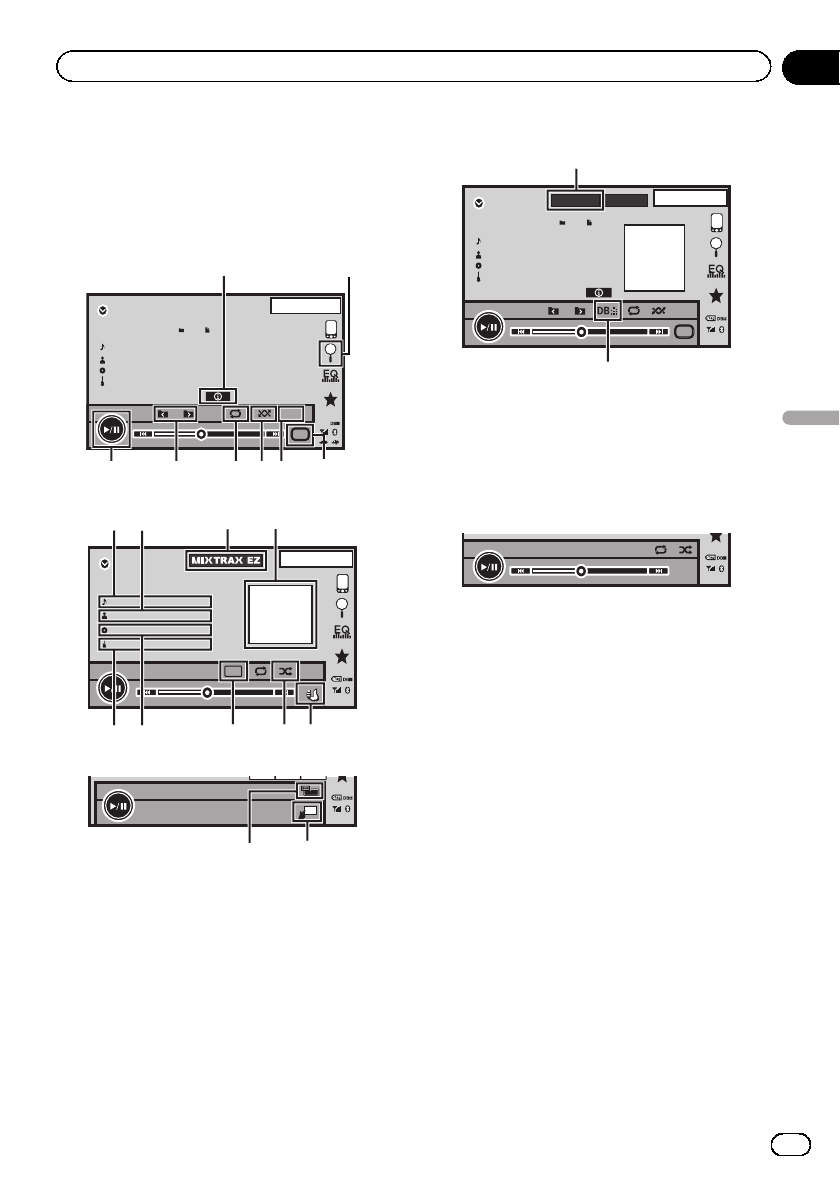
Introduction of sound
playback operations
You can listen to DVD-R/DVD-RW/CD/CD-R/
CD-RW/USB/SD/iPod sound files.
Audio CD
ROM
05’ 26” -00’ 35”
Abcdefghi
Abcdefghi
Abcdefghi
Abcdefghi
13 APR
PM
12:25
S.Rtrv
2015
Media
3
21
5
7684
Dolby PLll
iPod audio (Control Audio)
Abcdefghi
Abcdefghi
Abcdefghi
Abcdefghi
05’ 46” -00’ 31”
13 APR
PM
12:25
S.Rtrv
iPod 1
100/150
Ap p r
Appr
Ap p
App
Ap p
× 1
9
ac
hi
j
l
k b
iPod audio (App Mode)
2ch
48kHz
16bit
Dolby
D
e d
USB/SD audio
SD
Abcdefghi
Abcdefghi
Abcdefghi
Abcdefghi
05’ 26” -00’ 25”
13 APR
PM
12:25
S.Rtrv
EZ
88888888
Media
MIXTRAX
f
g
!Depending on your iPod, there may not be
any output unless you use CD-IU201S/CD-
IU201V (sold separately). Be sure to use
CD-IU201S/CD-IU201V to connect your
iPod.
Bluetooth Audio
05’ 46” -00’ 25”
!Depending on the Bluetooth audio player
connected to this unit, the available opera-
tions will be limited to the following two le-
vels:
—A2DP profile (Advanced Audio Distribu-
tion Profile): You can only playback
songs on your audio player.
—AVRCP profile (Audio/Video Remote
Control Profile): You can perform play-
back, pause playback, select songs, etc.
!Since there are a number of Bluetooth
audio players available on the market, avail-
able operations will vary extensively. When
operating your player with this unit, refer to
the instruction manual that came with your
Bluetooth audio player as well as this man-
ual.
!As the signal from your cellular phone may
cause noise, avoid using it when you are
listening to songs on your Bluetooth audio
player.
En 27
Section
08
Playing audio
Playing audio
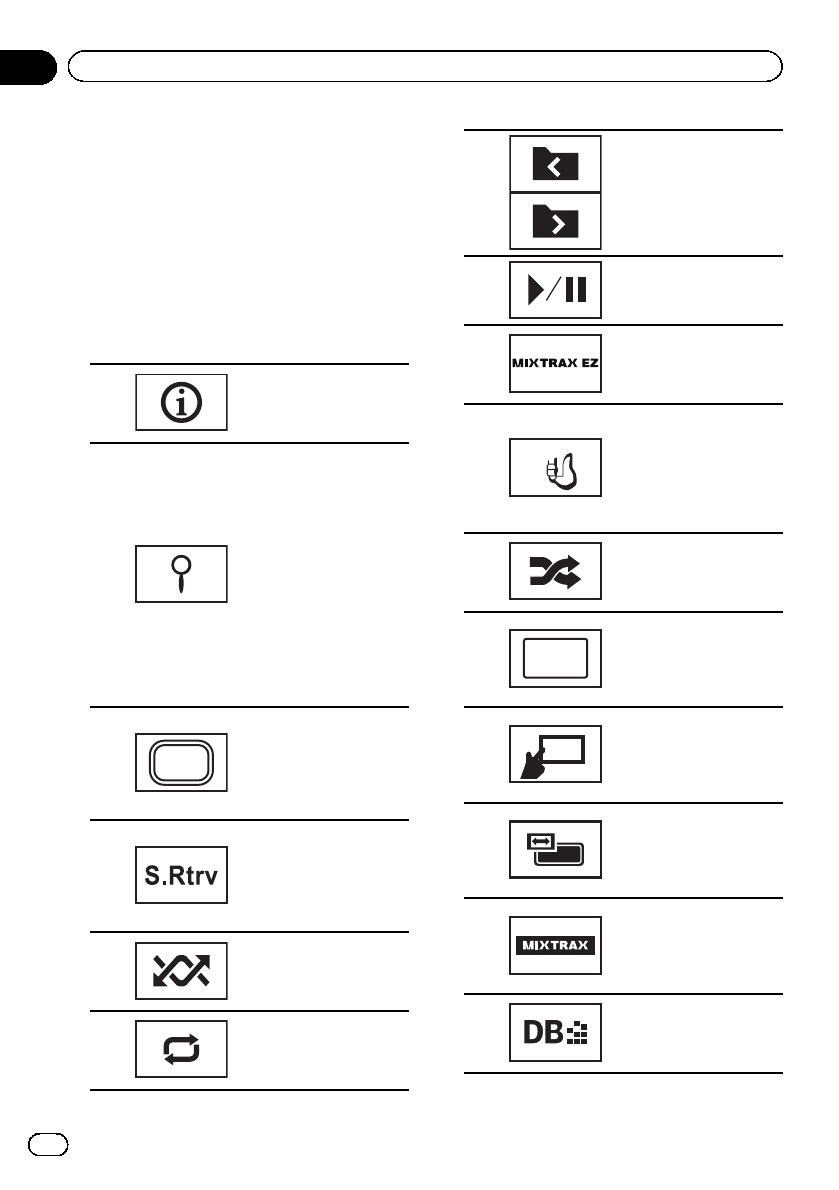
!When a call is in progress on the cellular
phone connected to this unit via Bluetooth
wireless technology, the sound of the
Bluetooth audio player connected to this
unit is muted.
!The play time may not display correctly.
!Depending on the type of Bluetooth audio
player you have connected to this unit, op-
eration and information display may not be
available for some functions.
Touch panel keys
1
Switching the text infor-
mation to display on this
unit when playing MP3/
WMA/AAC/WAV files.
2
Displaying a list of track
titles/file names to select
songs on a CD.
Refer to Selecting tracks
from the track title list on
page 46.
Displaying the file name
list to select the files.
Refer to Selecting files
from the file name list on
page 46.
Displaying iPod menus.
Refer to Browsing for a
video/music on the iPod
on page 43.
3
Media
Switching between
media file types on a
DVD/CD/USB/SD.
Refer to Switching the
media file type on page
40.
4
Switching the S.Rtrv
(sound retriever) function
setting when playing
audio.
Refer to Using sound re-
triever on page 46.
5
Playing songs in random
order.
Refer to Random play
(shuffle) on page 41.
6
Selecting the repeat
range.
Refer to Repeating play-
back on page 41.
7Selecting a folder.
8Pausing and starting
playback.
9
Starting MIXTRAX EZ.
Refer to Introduction of
MIXTRAX EZ operation on
page 32.
a
Appr
Appr
Ap p
App
Ap p
Conducting operation
from your iPod and listen-
ing to it using your car’s
speakers.
Refer to Operating this
unit’s iPod function from
your iPod on page 41.
b
Playing songs on the
iPod in random order.
Refer to Random play
(shuffle) on page 41.
c× 1
Changing the speed of
audiobook playback on
the iPod.
Refer to Changing audio-
book speed on page 46.
d
Performing operations
from this unit and listen-
ing to the music on your
iPod using your car’s
speakers.
e
Changing the screen
mode.
Refer to Changing the
wide screen mode on
page 48.
f
Displaying the MIXTRAX
screen.
Refer to Introduction of
MIXTRAX operation on
page 32.
g
Start Music browse
mode.
Refer to Music Browse
mode on page 47.
En
28
Section
08 Playing audio
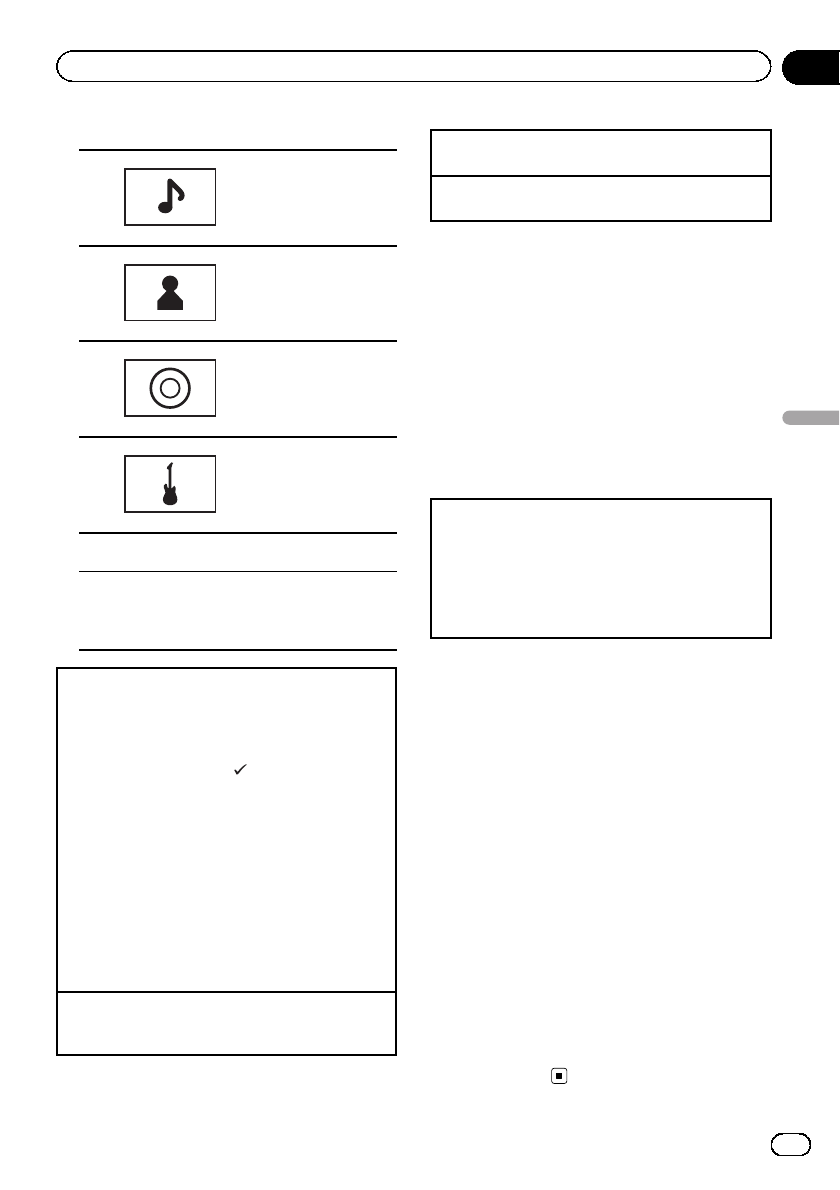
Text information
h
Displaying the Songs list
on the iPod.
Refer to Searching for a
video/music by category
on page 43.
i
Displaying the Artists list
on the iPod.
Refer to Searching for a
video/music by category
on page 43.
j
Displaying the Albums
list on the iPod.
Refer to Searching for a
video/music by category
on page 43.
k
Displaying the Genres
list on the iPod.
Refer to Searching for a
video/music by category
on page 43.
Artwork display
l
Starting Album Link Search on your iPod
when you touch the artwork display.
Refer to Displaying lists related to the cur-
rently playing song (Link Search) on page 46.
Playing back sound
1Insert the disc into the disc loading slot with the
label side up.
Playback will automatically start.
!While an iPod is connected to this unit, PIONEER,
Accessory Attached or (check mark) is dis-
played on the iPod.
!When the source icon is not displayed, it can be
displayed by touching the screen.
!Disconnect headphones from the iPod before
connecting it to this unit.
!Depending on the iPod model and the amount of
data stored in the iPod, it may take some time for
playback to begin.
!Use the touch panel keys to select the iPod after
connecting it to this unit.
!No Device is displayed when disconnecting the
iPod.
Ejecting a disc/SD
!Refer to Ejecting a disc on page 17.
!Refer to Ejecting an SD on page 18.
Selecting a track using the buttons
1Press cor d(TRK).
Fast forwarding or reversing using the buttons
1Press and hold cor d(TRK).
Note
Touch panel keys not listed under Introduction of
sound playback operations may appear on the dis-
play.
Refer to Indicator list on page 98.
Setting up for Bluetooth audio
Before you can use the Bluetooth audio func-
tion you must establish a Bluetooth wireless
connection between the unit and your
Bluetooth audio player.
1Connection
First, you need to connect a Bluetooth audio to
this unit.
For detailed instructions on connecting your
Bluetooth audio to this unit via Bluetooth wireless
technology, see Introduction of Bluetooth connec-
tion menu operations on page 70.
Notes
!When playing back files recorded as VBR
(variable bit rate) files, the play time will not be
correctly displayed if fast forward or reverse
operations are used.
!To ensure proper operation, connect the dock
connector cable from the iPod directly to this
unit.
!While the iPod is connected to this unit, the
iPod cannot be turned on or off.
!If the characters recorded on the disc are not
compatible with this unit, those characters
will not be displayed.
!Text information may not be correctly dis-
played depending on the recorded environ-
ment.
!Disconnect the USB portable audio player/
USB memory when you are done using it.
!When you select Speana on Selecting the
background display on page 73, the artwork is
not displayed.
En 29
Section
08
Playing audio
Playing audio
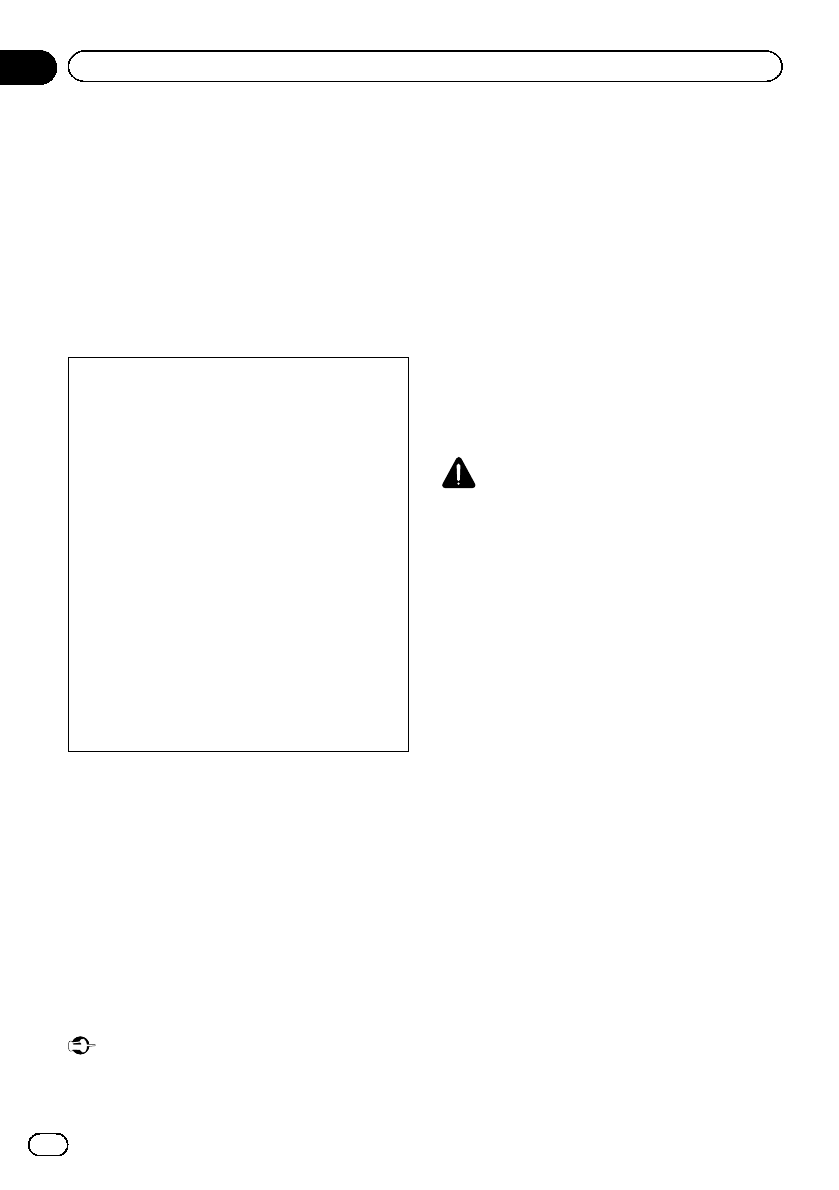
Introduction of Advanced
App Mode operation
This system can switch to the Advanced App
Mode, which you can display and operate the
application for iPhone on the screen.
In Advanced App Mode, you can operate appli-
cations with finger gestures such as tapping,
dragging, scrolling or flicking on the screen of
the system.
!Pioneer is not liable for any issues that may
arise from incorrect or flawed app-based
content.
!The content and functionality of the sup-
ported applications are the responsibility of
the App providers.
!In Advanced App Mode, functionality
through the product is limited while driving,
with available functions determined by the
App providers.
!Availability of Advanced App Mode func-
tionality is determined by the App provider,
and not determined by Pioneer.
!Advanced App Mode allows access to ap-
plications other than those listed (subject
to limitations while driving), but the extent
to which content can be used is determined
by the App providers.
Advanced App Mode is compatible with the
following iPod models.
!iPhone 4S
!iPhone 4
!iPod touch 4th generation
—Applications operable by switching this
system to Advanced App Mode are only
those available for Advanced App Mode.
—Please check iPhone applications sup-
ported Advanced App Mode at
http://www.pioneerelectronics.com/
AppRadio
Important
!Use the CD-IU201S (sold separately) when you
use this function.
!The port that supports Advanced App Mode
will only be USB input 1.
!When you use this function, set the RGB input
to iPhone. For details, refer to Setting the RGB
Input on page 63.
!Depending on the application, you can input
text on the display.
!When using application which allows you to
input text on the keyboard, set the language
setting of this unit and your iPod. For details,
refer to Setting the Keyboard on the next page.
!When listening to music and sounds from ap-
plication simultaneously, see the following
section. Refer to Setting the App sound mixing
on page 63.
CAUTION
!While driving, you cannot enter text on your
iPod.
!Use the connected iPod to open an applica-
tion.
Starting procedure
1 Set RGB Input to iPhone.
When you use this function, set the RGB input
to iPhone. For details, refer to Setting the RGB
Input on page 63.
2 Start an application available for Ad-
vanced App Mode from the iPhone.
An image of the application is displayed on
the screen of this system.
!You can start an application available for
Advanced App Mode also from a launcher
application.
3 Touch MODE to hide the AV source
icons or wait until the source icons disap-
pear.
!If the source icons are displayed, you can-
not conduct the operation of application on
the screen.
4 Operate the application.
En
30
Section
09 Advanced App Mode

Setting the Keyboard
CAUTION
For your safety, the keyboard functionality is only
available when the vehicle is stopped and the
parking brake is engaged.
Depending on the application, you can input
text on the display. In order to input text cor-
rectly using keyboard which appears on this
unit, you need to set the language setting in
this function.
When the Advanced App Mode is used, the
language setting for the keyboard set for the
function and the language setting for the
iPhone keyboard need to be the same.
!Keyboard is available only in Advanced
App Mode.
When you tap a text input area of an applica-
tion for iPhone, a keyboard will be displayed
on-screen. You can input the desired text di-
rectly from this system.
!The language preference for the keyboard
of this system should be same as the set-
ting on your iPhone.
If the settings for this product and the
iPhone are different, you may not be able to
enter characters properly.
1 Display the system menu.
Refer to Introduction of menu operations on
page 55.
2 Touch Keyboard on the System menu
to select desired language.
3 Touch the desired language.
French (French)—German (German)—Greek
(Greek)—Russian (Russian)—English (Eng-
lish)—English (UK) (English)—Dutch (Dutch)
—Italian (Italian)—Norwegian (Norwegian)
—Swedish (Swedish)—Finnish (Finnish)—
Spanish (Spanish)—Portuguese (Portuguese)
4 Tap the text input area on the applica-
tion screen of the iPhone.
Touch to hide the keyboard.
En 31
Section
09
Advanced App Mode
Advanced App Mode
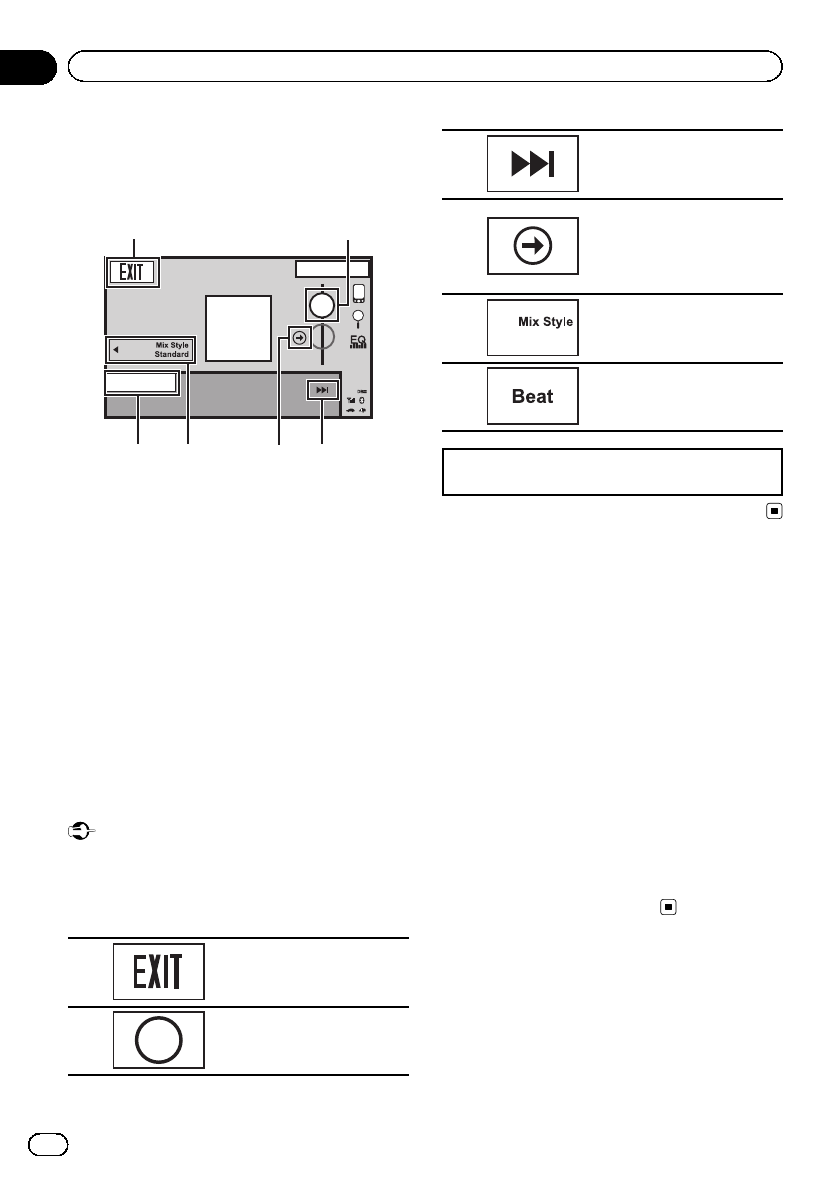
Introduction of MIXTRAX
operation
You can play the audio files of USB/SD.
13 ARP
PM
12:25
ABCDEFGHIJK
ABCDEFGHIJK
Beat
BPM
Dolby PLll
12
54
3
6
MIXTRAX is original technology for creating
non-stop mixes of selections from your audio
library, complete with DJ effects that make
them sound as if a DJ is right there with you
playing the music.
Using MIXTRAX
You can enjoy your music files by installing the
MIXTRAX software to your computer and
using the software to transfer the files to USB
devices and SD cards.
The MIXTRAX software can be downloaded
from the website below.
http://www.mixtraxnet.com
For details on how to use the MIXTRAX soft-
ware, refer to the online manual.
Important
The artwork display can be moved based on the
music type. For details, refer to Setting the Art-
work Dance on page 66.
Touch panel keys
1Switching to the audio mode
of USB/SD.
2
BPM
Changing the BPM (Beats
Per Minute).
3Starting playback of the next
song.
4
Switching to the original
BPM (Beats Per Minute).
The original BPM (Beats Per
Minute) does not display dur-
ing playback.
5
Switching to the Mixstyle dis-
play. You can select the de-
sired Mixstyle in the display.
6
Switching to the Mix playlist.
You can select the desired
Mix playlist.
Starting playback of the next song.
1Press d(TRK).
Introduction of MIXTRAX
EZ operation
You can play the audio files of iPod/USB/SD.
MIXTRAX EZ is used to add a variety of sound
effects between songs for arranging the
pauses between songs. It allows you to enjoy
listening to music nonstop.
!This function is only available when a file
on an external storage device (USB, SD) or
a song on an iPod is being played.
!This function is not available when the con-
trol mode is set to App Mode.
!Depending on the file/song, sound effects
may not be enabled for adding.
!Depending on the file/song, non-stop play-
back may not be available.
En
32
Section
10 Using MIXTRAX
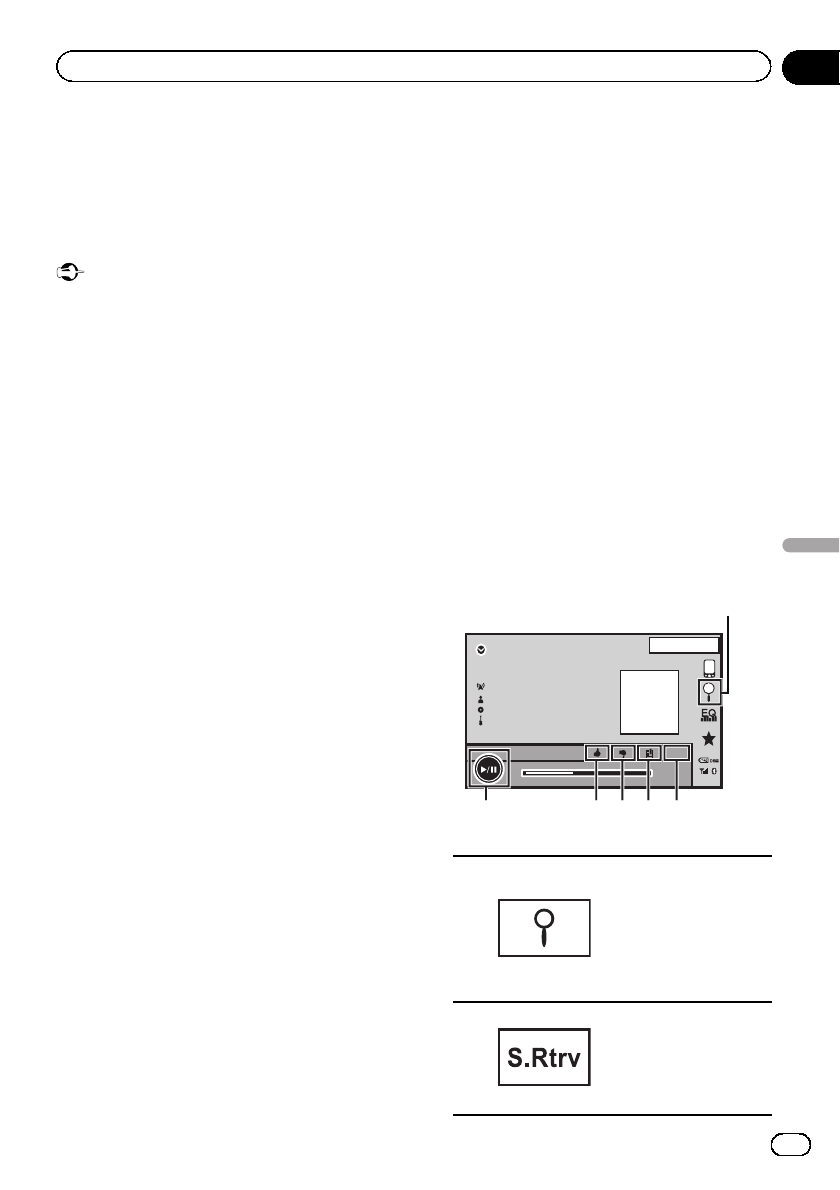
Pandora operations
To play Pandora on the Pioneer car audio/
video products, connect an iPod or iPhone
with the most recent Pandora application in-
stalled, and start the Pandora application.
Important
Requirements to access Pandora using the
Pioneer car audio/video products:
Connect your iPod to USB input 1 when you play
Pandora.
!iPod and iPhone compatibility
Apple iPhone (first generation), iPhone 3G,
iPhone 3GS, iPhone 4, iPod touch 1G, iPod
touch 2G, iPod touch 3G or iPod touch 4G
(firmware version 3.0 or later).
Certain firmware versions for the iPod touch
and iPhone may not be compatible with the
Pandora application. If this appears to be the
case, please update the firmware to a version
that is compatible with Pandora.
!Latest version of the Pandora application,
downloaded to your device. (Search Apple
iTunes App Store for “Pandora”).
!Current Pandora account (Free account and
paid accounts available from Pandora; create
a free account online at
http://www.pandora.com/register or through
the Pandora application for the iPhone).
!Data Plan.
Note: If the Data Plan for your iPhone does
not provide for unlimited data usage, addi-
tional charges from your carrier may apply for
accessing the Pandora service via 3G and/or
EDGE networks.
!Connection to the Internet via 3G, EDGE or
Wi-Fi network.
!Optional Pioneer adapter cable connecting
your iPhone to the Pioneer car audio/video
products.
Limitations:
!Access to the Pandora service will depend on
the availability of a cellular and/or Wi-Fi net-
work for purposes of allowing your device to
connect to the Internet.
!Ability of the Pioneer car audio/video products
to access the Pandora service is subject to
change without notice and could be affected
by any of the following: compatibility issues
with future firmware versions of iPhones;
compatibility issues with future firmware ver-
sions of the Pandora application for the
iPhone; changes to the Pandora music service
by Pandora; discontinuation of the Pandora
music service by Pandora.
!Certain functions of the Pandora service are
not available when accessing the service
through the Pioneer car audio/video products,
including, but not limited to, creating new sta-
tions, deleting stations, emailing current sta-
tions, buying tracks from iTunes, viewing
additional text information, logging in to
Pandora, and adjusting Cell Network Audio
Quality.
Pandora internet radio is a music service not af-
filiated with Pioneer. More information is avail-
able at http://www.pandora.com.
PANDORA
Abcdefghi
Abcdefghi
Abcdefghi
Abcdefghi
05’ 34” -00’ 34”
13 APR
PM
12:25
S.Rtrv
1
62354
Touch panel keys
1
Displaying the QuickMix/
station list to select
QuickMix or the desired
station.
Refer to Selecting and
playing Pandoraâsta-
tions/QuickMix on page
43.
2
Switching the S.Rtrv
(sound retriever) function
setting while playing
Pandora.
Refer to Using sound re-
triever on page 46.
En 33
Section
11
Using Pandoraâinternet radio
Using Pandoraâinternet radio
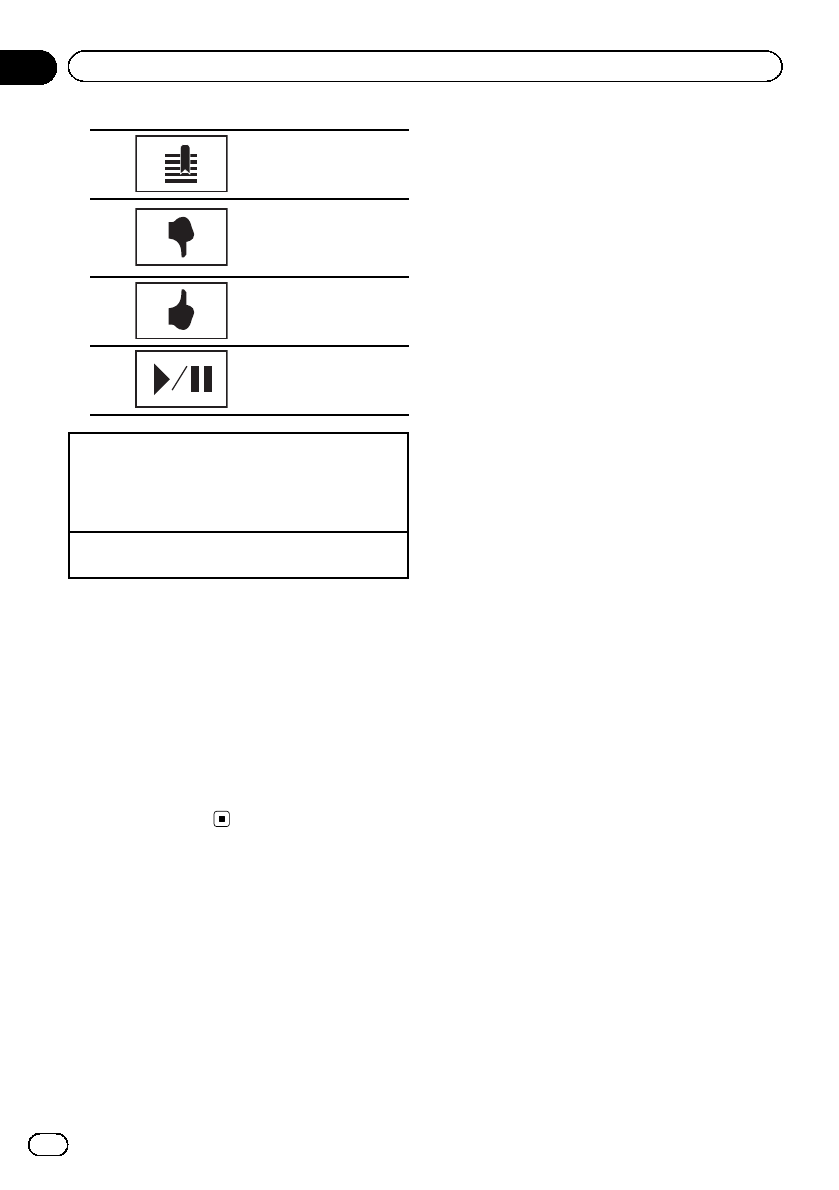
3Storing track information
(Bookmark).
4
Giving a “Thumbs-down”
for the track currently
playing and then skip-
ping to the next track.
5
Giving a “Thumbs-up”for
the track currently play-
ing.
6Pausing and starting
playback.
Playing tracks
1Connect an iPod to USB input 1 with an USB
cable using an iPod or iPhone Dock Connector.
2Start up the Pandora application installed on the
iPod or iPhone.
Skipping tracks
1Press d(TRK).
Notes
!Touch panel keys not listed under Pandora op-
erations may appear on the display.
Refer to Indicator list on page 98.
!Pandora limits the number of skips allowed
on their service. If you attempt to skip songs
beyond the limit, "SKIP LIMIT REACHED" is
displayed. If you have reached the skip limit
and you give a "thumbs-down", the current
track will continue to play, but your feedback
will be registered.
En
34
Section
11 Using Pandoraâinternet radio
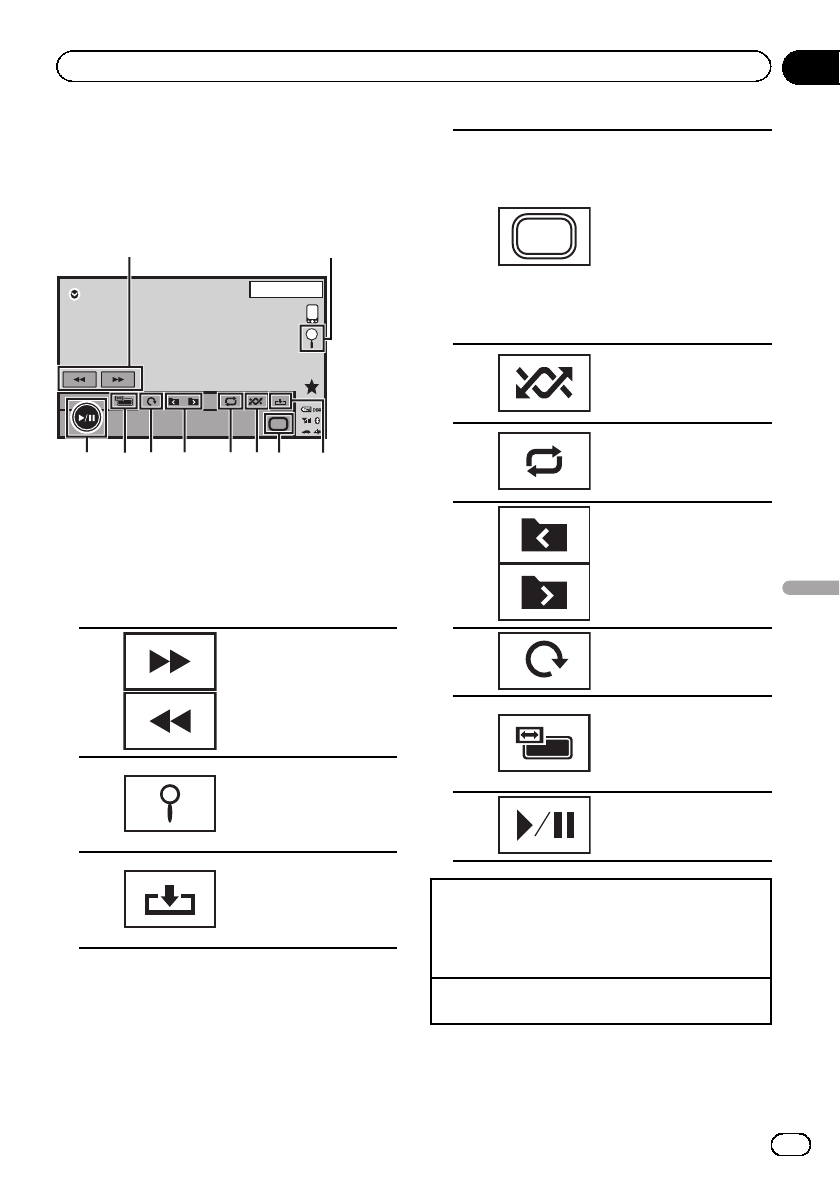
Introduction of still image
playback operations
You can view still images saved in USB/SD.
Still image
SD
13 APR
PM
12:25
Dolby PLll
Media
2
1
567834a9
When loading a USB/SD containing JPEG pic-
ture files, this unit starts a slideshow from the
first folder/picture on the device.
The table below shows the controls for viewing
a slideshow.
Touch panel keys
1Selecting a picture.
2
Displaying the file name
list to select the files.
Refer to Selecting files
from the file name list on
page 46.
3
Capturing an image in
JPEG files.
Refer to Capture an
image in JPEG files on
page 48.
4
Media
Switching between
media file types when
there is more than one
media file type saved to
the USB or SD device.
This key does not appear
if there is only one media
file type saved to the USB
or SD device.
Refer to Switching the
media file type on page
40.
5
Playing files in a random
order.
Refer to Random play
(shuffle) on page 41.
6
Selecting the repeat
range.
Refer to Repeating play-
back on page 41.
7Selecting a folder.
8Rotating the displayed
picture 90° clockwise.
9
Changing the screen
mode.
Refer to Changing the
wide screen mode on
page 48.
aStarting or pausing the
slideshow.
Playing still images
1Connect the USB/SD device.
Playback will automatically start.
!When the source icon is not displayed, it can be
displayed by touching the screen.
Ejecting an SD
!Refer to Ejecting an SD on page 18.
En 35
Section
12
Playing still images
Playing still images
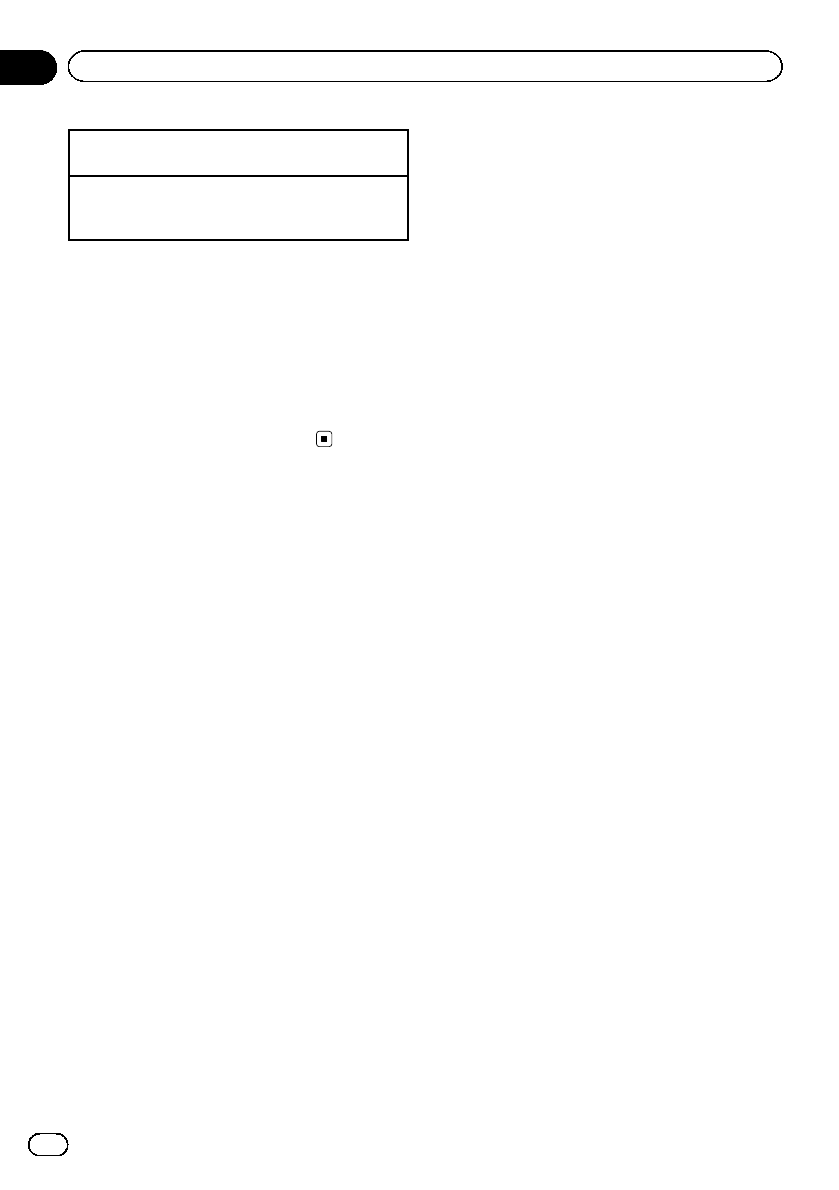
Selecting a file using the buttons
1Press cor d(TRK).
Fast file searching
1Press and hold cor d(TRK).
!You can search 10 JPEG files at a time.
Notes
!Files are played back in file number order and
folders are skipped if they contain no files. (If
folder 1(ROOT) contains no files, playback
commences with folder 2.)
!Touch panel keys not listed under Introduction
of still image playback operations may appear
on the display.
Refer to Indicator list on page 98.
En
36
Section
12 Playing still images
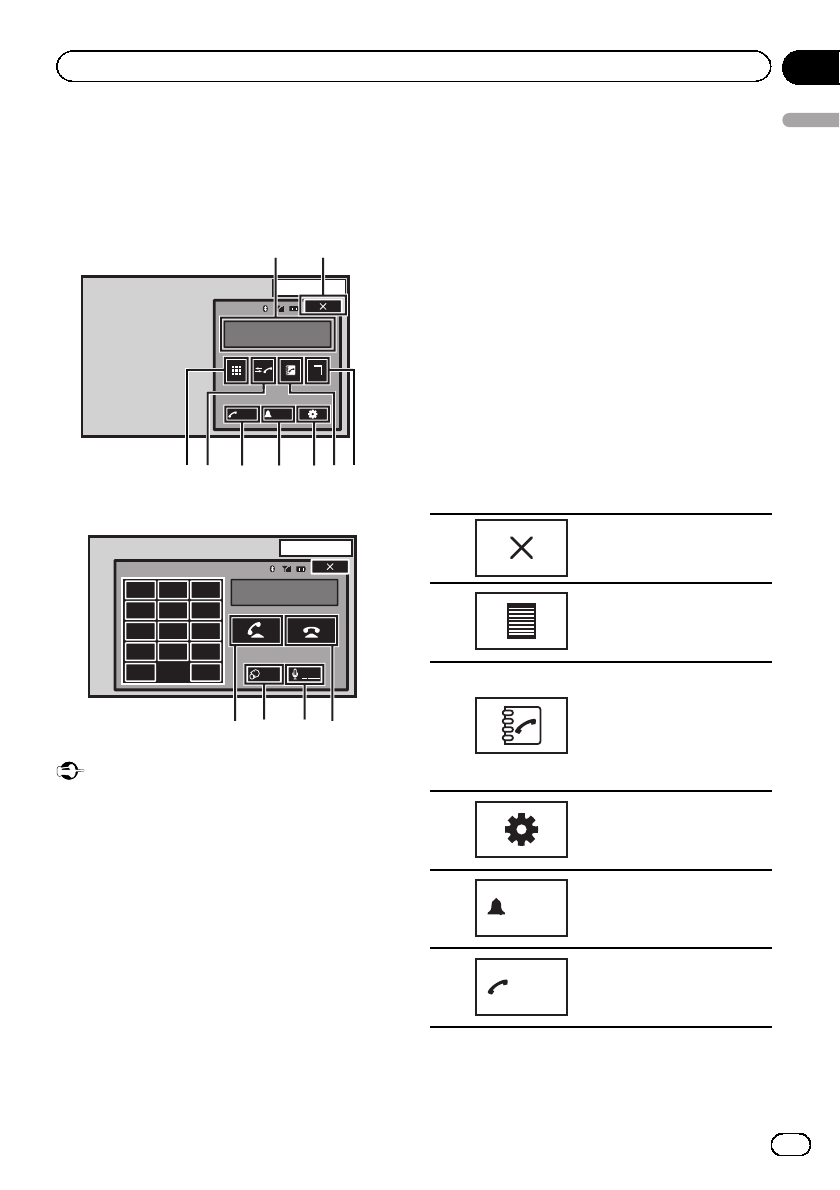
Introduction of Bluetooth
telephone operations
You can use Bluetooth telephone.
Telephone standby display
13 ARP
PM
12:25
1
Abcdefghi
1234567890123456
Auto
ON
Tone
OFF
2356784
11
When switching to the entering phone
number mode
13 APR
PM
12:25
1
123
456
789
*0#
C+
Abcdefghi
XXXXXXXXXXXXXXXX
Private
ON
Vol
9acb
Important
!Since this unit is on standby to connect with
your cellular phone via Bluetooth wireless
technology, using it without the engine run-
ning can drain the battery power.
!Advanced operations that require attention
such as dialing numbers on the monitor, etc.,
are prohibited while driving. Park your vehicle
in a safe place when using these advanced
operations.
!Bluetooth connection menu cannot be se-
lected while driving.
!Operations available may be limited depend-
ing on the cellular phone connected to this
unit.
!Be sure to park your vehicle in a safe place
and apply the parking brake when performing
this operation.
!If you are unable to complete the connection
using this unit, use the device to connect to
the unit.
!If you connect more than one device at a time,
connected device may not operate properly.
Connecting one device at a time is recom-
mended.
1Incoming call notice
Indicates that an incoming call has been re-
ceived and has not been checked yet.
!Not displayed for calls made when your
cellular phone is disconnected from this
unit.
Touch panel keys
1Display is closed.
2
Displaying the preset dial
screen.
Refer to Using the preset dial
lists on page 53.
3
Switching to the phone book
mode.
Refer to Calling a number in
the phone book on page 51.
Refer to Selecting a number
by alphabet search mode on
page 52.
4
Displaying the Bluetooth
connection menu.
Refer to the instructions
from page 70 to page 72.
5
Tone
Turning the ring tone for in-
coming calls on or off.
Refer to Switching the ring
tone on page 53.
6Auto
Turning automatic answering
on or off.
Refer to Setting automatic an-
swering on page 53.
En 37
Section
13
Bluetooth telephone
Bluetooth telephone
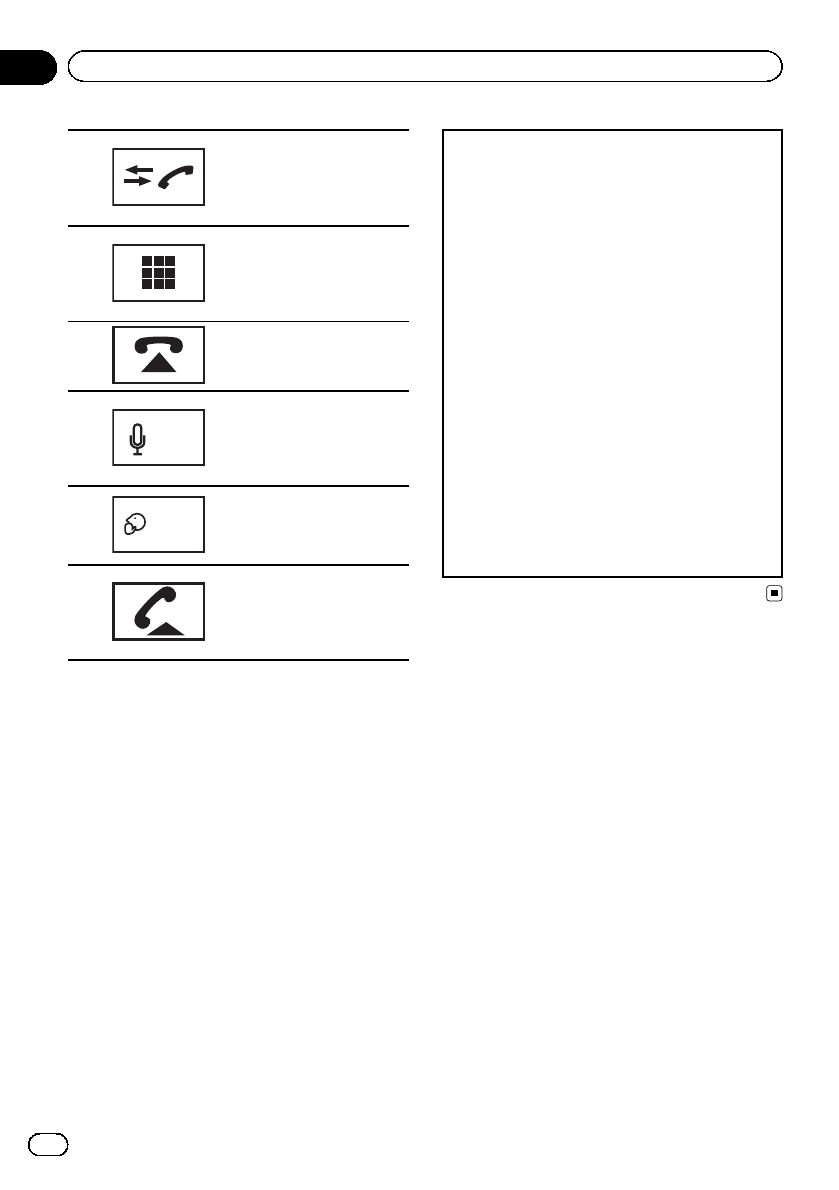
7
Switching to the call history
list.
Refer to Using the missed, re-
ceived and dialed call lists on
page 52.
8
Switching the mode to enter
the phone number directly.
Refer to Making a call by en-
tering phone number on page
54.
9
Ending a call.
Rejecting an incoming call.
Canceling call waiting.
aVol
Adjusting the other party’s
listening volume.
Refer to Adjusting the other
party’s listening volume on
page 53.
bPrivate
Turning private mode on or
off.
Refer to Setting the private
mode on page 54.
c
Accepting an incoming call.
Making a phone call, when
selecting a phone number.
Switching between callers on
hold.
Notes
!Private mode can only be operated while you
are talking on the phone.
!To end the call, both you and the other caller
must hang up your phones.
!Touch panel keys not listed under Introduction
of Bluetooth telephone operations may appear
on the display.
Refer to Indicator list on page 98.
Setting up for hands-free phoning
Before you can use the hands-free phoning
function you must set up the unit for use with
your cellular phone. This entails establishing a
Bluetooth wireless connection between this
unit and your phone, registering your phone
with this unit, and adjusting the volume level.
1Connection
First, you need to connect a Bluetooth telephone
to this unit.
For detailed instructions on connecting your
phone to this unit via Bluetooth wireless technol-
ogy, see following section. Using a Bluetooth de-
vice to pair on page 71 and Pairing from this unit
on page 70.
2Volume adjustment
Adjust the earpiece volume of your cellular phone
to your preference. The unit will record the ad-
justed volume level as the default setting.
!The volume of the caller’s voice and ring tone
may vary depending on the type of cellular
phone.
!If there is a large volume difference between
the ring tone and caller’s voice, the overall vo-
lume level may become unstable.
!Make sure to adjust the volume to a proper
level before disconnecting the cellular phone
from the unit. If the volume is muted (zero
level) on your cellular phone, the volume level
of your cellular phone remains muted even
after the cellular phone is disconnected.
En
38
Section
13 Bluetooth telephone
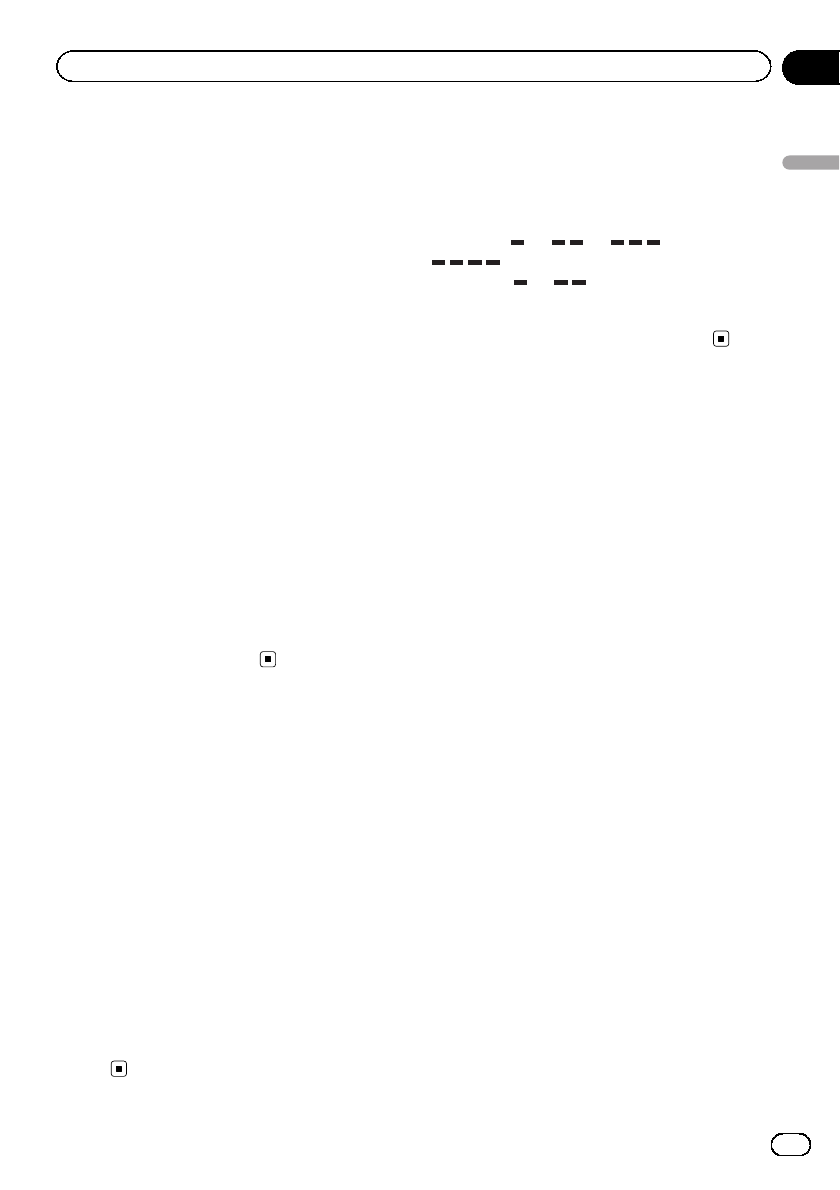
Storing and recalling stations
You can easily store up to six stations for each
band as presets.
!Six stations for each band can be stored in
memory.
!Channels are stored and recalled on a
broadcast station basis. This means that if
the broadcast station you stored has been
assigned to a different channel by SIRIUS,
you can still recall the same broadcast sta-
tion (though a different channel number
may appear in the display).
1 Display the preset channel list screen.
Refer to Introduction of XM/SIRIUS tuner opera-
tions on page 22.
Refer to Introduction of HD Radio tuner opera-
tions on page 20.
The preset channel list appears in the display.
2 Touch and hold one of the preset tun-
ing keys to store the selected frequency in
the memory.
The selected radio station frequency has been
stored in the memory.
3 Touch one of the preset tuning keys to
select the desired station.
Storing the strongest stations
BSM (best stations memory) automatically
stores the six strongest stations in the order of
their signal strength.
Storing broadcast frequencies with BSM may
replace broadcast frequencies you have saved
using the preset tuning keys.
1 Display the preset channel list screen.
Refer to Introduction of HD Radio tuner opera-
tions on page 20.
The preset channel list appears in the display.
2 Touch BSM to turn BSM on.
The six strongest broadcast frequencies will
be stored under preset tuning keys in order of
their signal strength.
#To cancel the storage process, touch
Cancel.
Tuning in to strong signals
Local seek tuning lets you tune in to only
those radio stations with sufficiently strong
signals for good reception.
FM: Off —— — —
AM: Off — —
The highest level setting allows reception of
only the strongest stations, while lower levels
allow the reception of weaker stations.
Using iTunes tagging
This function can be operated with the following
iPod models.
—iPod touch 4th generation
—iPod touch 3rd generation
—iPod touch 2nd generation
—iPod touch 1st generation
—iPod classic 160GB
—iPod classic 120GB
—iPod classic
—iPod with video
—iPod nano 6th generation
—iPod nano 5th generation
—iPod nano 4th generation
—iPod nano 3rd generation
—iPhone 4S
—iPhone 4
—iPhone 3GS
—iPhone 3G
—iPhone
The song information (tag) can be saved from
the broadcasting station to your iPod. The
songs will show up in a playlist called “Tagged
playlist”in iTunes the next time you sync your
iPod. Then you can directly buy the songs you
want from the iTunes Store.
The tagged songs and the song that you can
buy from the iTunes Store may be different.
Make sure to confirm the song before you
make the purchase.
If you cannot use this function normally, up-
date your iPod firmware.
En 39
Section
14
Detailed instructions
Detailed instructions
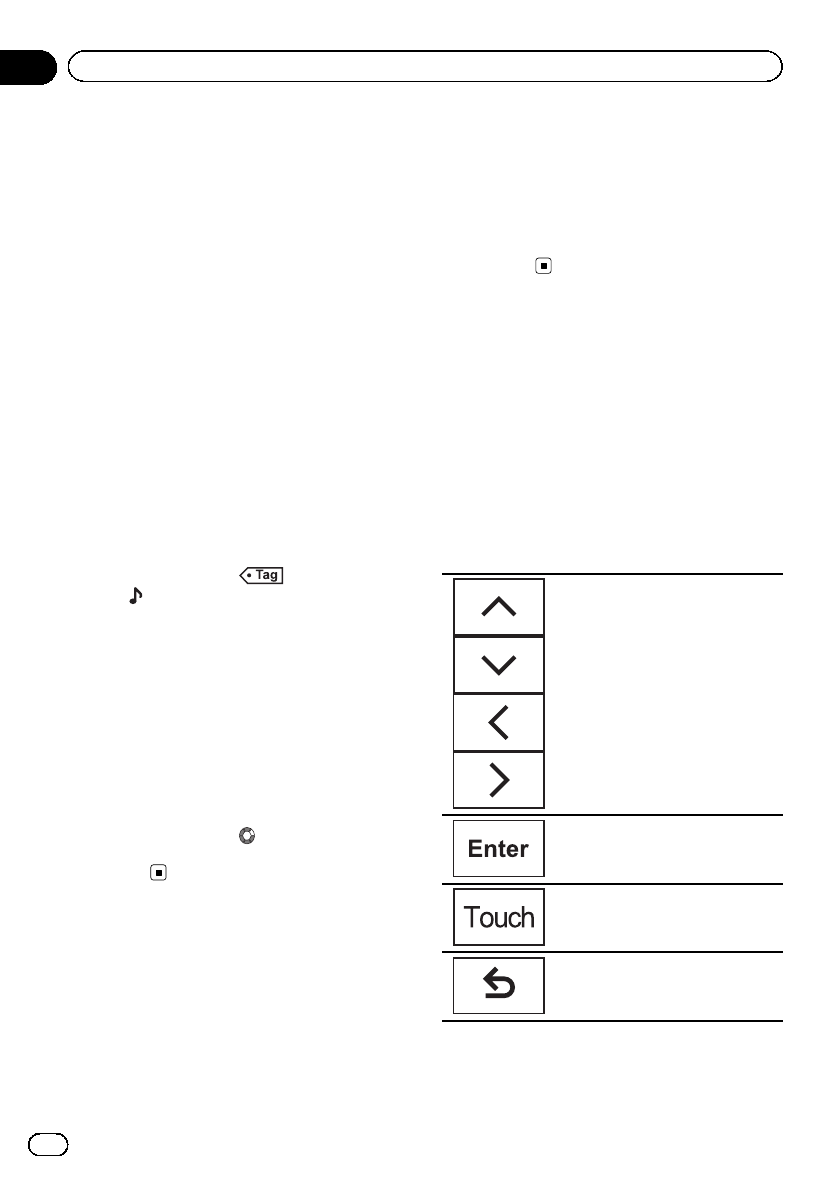
Storing the tag information to
this unit
1 Tune in to the broadcast station.
2 Store the tag information to this unit.
Refer to Introduction of HD Radio tuner opera-
tions on page 20.
You can store the information if the Tag indica-
tor is displayed while the desired song is being
broadcast.
#While storing the tag data on this unit, Tag
flashes.
#The tag information for up to 50 songs can be
stored on this unit.
#Depending on the timing of when the tag in-
formation is stored, the tag information for the
song played before or after the currently playing
song may also be stored.
#If an SD is selected as the source while tag in-
formation is being stored to this unit, the tag in-
formation will not be transferred to the iPod.
3 When completed, indicator turns
off and indicator is displayed.
Storing the tagged information
to your iPod
1 Connect your iPod.
When your iPod is connected to this unit, your
iPod starts storing the tagged information
automatically.
#While transferring the tag, you cannot select
the SD source.
2 When completed, indicator turns off
and the tagged information is stored on
your iPod.
Switching the media file type
When playing a digital media containing a
mixture of various media file types, such as
DivX, MPEG-1, MPEG-2, MPEG-4 and MP3,
you can switch between media file types to
play.
Audio data (CD-DA) and JPEG picture files on
DVD-R/RW/ROM cannot be played back on
this unit.
CD (audio data (CD-DA))—Music/ROM (com-
pressed audio)—Video (DivX, MPEG-1,
MPEG-2, MPEG-4 video files)—Photo (JPEG
picture files)
Operating the DVD menu
(Function for DVD video)
Some DVDs allow you to make a selection
from the disc contents using a menu.
Using the arrow keys
1 Display arrow keys to operate the DVD
menu.
Refer to Playing moving images on page 24.
2 Select the desired menu item.
Selecting the desired menu item.
Starting playback from the se-
lected menu item.
Operating the DVD menu by di-
rectly touching the menu item.
Back to Previous display.
#When operating the DVD menu by directly
touching the menu item, touch the icon to oper-
ate.
En
40
Section
14 Detailed instructions
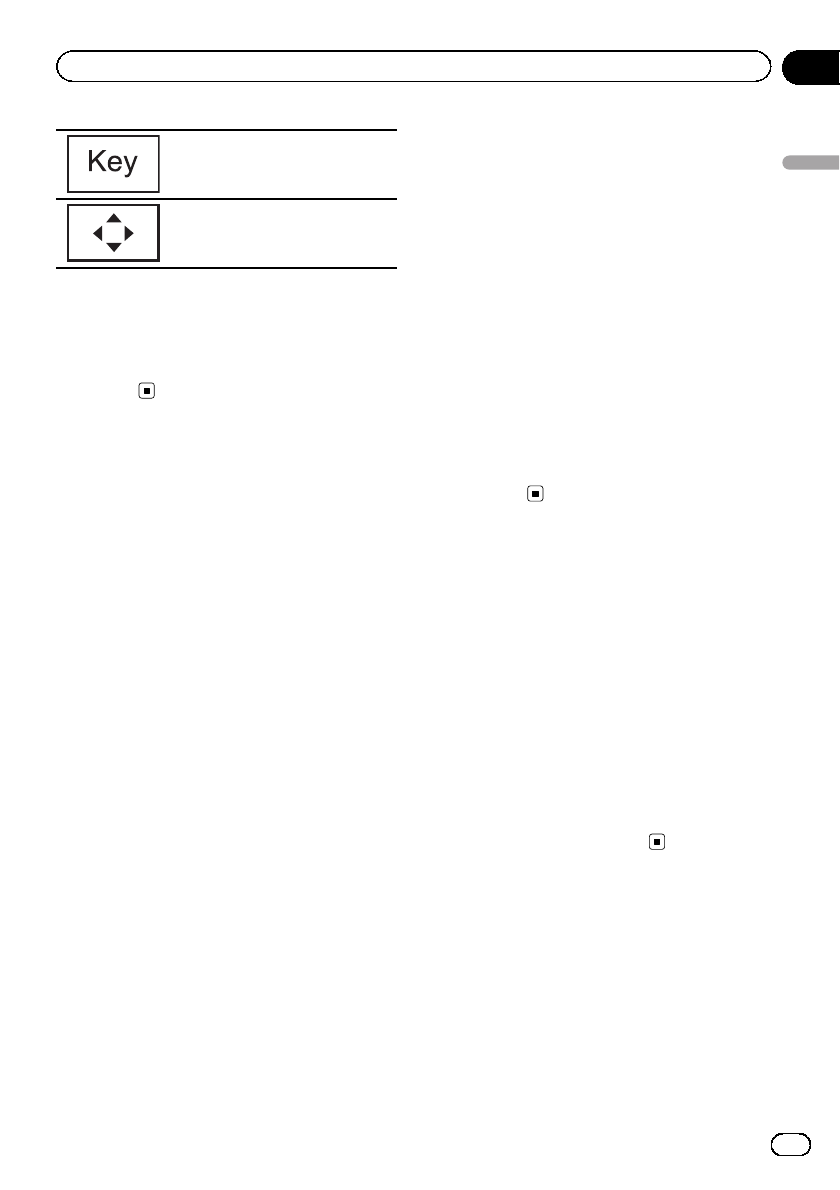
Returning to the normal DVD video
display.
Displaying arrow keys.
#Ways to display the menu will differ depend-
ing on the disc.
#Depending on the contents of the DVD disc,
this function may not work properly. In such
cases, use the touch panel keys to operate the
DVD menu.
Operating this unit’s iPod
function from your iPod
You can listen to the sound from your iPod ap-
plications using your car’s speakers, when
App Mode is selected.
This function is not compatible with the follow-
ing iPod models.
!iPod nano 1st generation
!iPod with video
!While this function is in use, the iPod will
not turn off even if the ignition key is turned
off. Operate the iPod to turn off the power.
1 Switch the control mode to App Mode.
Refer to Introduction of video playback opera-
tions on page 24.
Refer to Introduction of sound playback opera-
tions on page 27.
2 Operate the connected iPod to select a
video/song and play.
Notes
!The following functions are still accessible
from the unit even if the control mode is set to
App Mode.
However, the operation will depend on your
applications.
—Playing/pausing
—Fast forwarding/reversing
—Tracking up/down
—Moving to a chapter up/down
!App Mode is compatible with the following
iPod models.
—iPod touch 4th generation
—iPod touch 3rd generation
—iPod touch 2nd generation
—iPod touch 1st generation
—iPod classic 160GB
—iPod classic 120GB
—iPod classic
—iPod nano 6th generation
—iPod nano 5th generation
—iPod nano 4th generation
—iPod nano 3rd generation
—iPod nano 2nd generation
—iPhone 4S
—iPhone 4
—iPhone 3GS
—iPhone 3G
—iPhone
Random play (shuffle)
iPod-videos/songs can be played back in ran-
dom order.
!Songs –Play back videos/songs in the se-
lected list in random order.
!Albums –Play back videos/songs from a
randomly selected album in order.
!Folder –Play back songs/tracks in the se-
lected folder in random order.
!Disc –Play back songs/tracks in the se-
lected disc in random order.
!On –Play back files in random order within
the repeat range, Folder and Disc.
!Off –Cancel random play.
Repeating playback
!Disc –Play through the current disc
!Chapter –Repeat the current chapter
!Title –Repeat the current title
!Track –Repeat the current track
!File –Repeat the current file
!Folder –Repeat the current folder
!One –Repeat just the current video/song
!All –Repeat all videos/songs in the se-
lected list on the iPod
En 41
Section
14
Detailed instructions
Detailed instructions
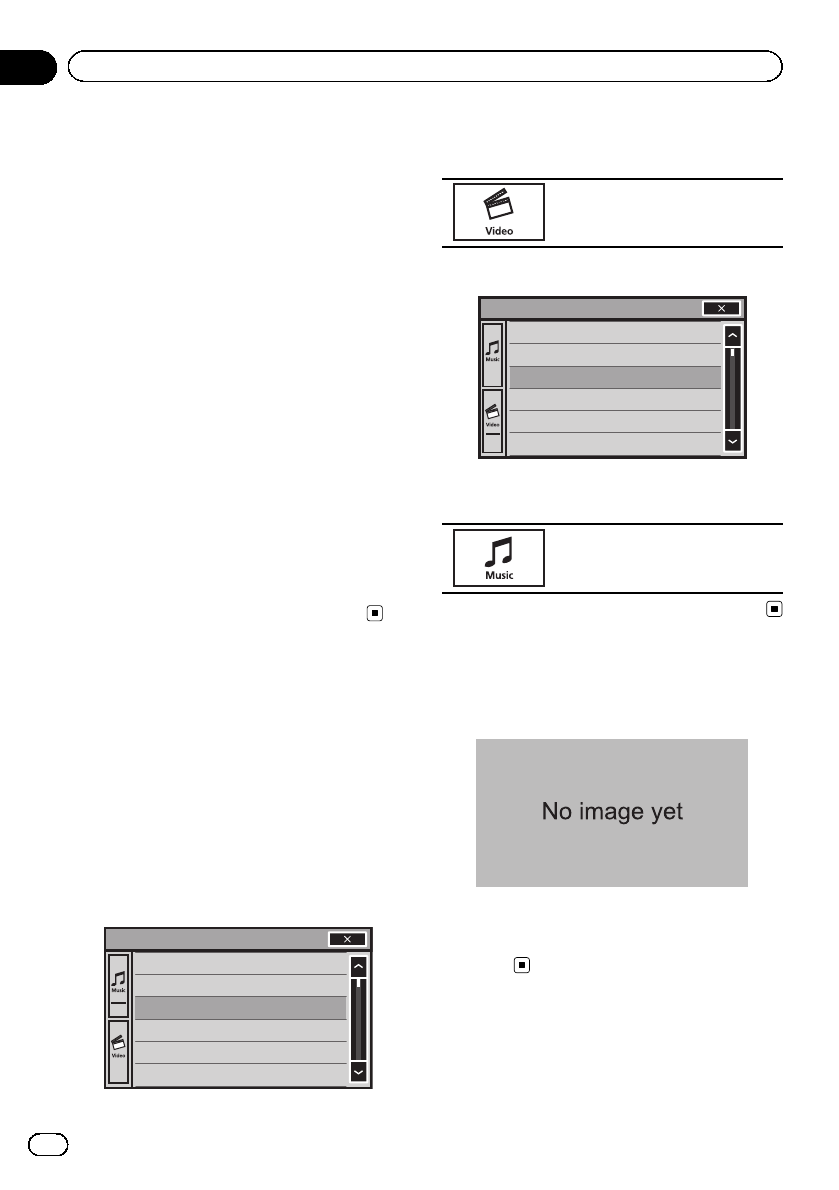
!This function cannot be operated during
Video CD playback featuring PBC (playback
control).
!If you perform chapter search, fast forward/
reverse, frame-by-frame playback or slow
motion playback, the repeat play will stop.
!When playing discs with compressed audio
and audio data (CD-DA), playback is re-
peated within the type of data currently
playing even if Disc is selected.
!If you select another folder during repeat
play, the repeat play range changes to Disc.
If you select USB or SD source, the repeat
play range changes to All.
!If you perform track search or fast forward/
reverse during File, the repeat play range
changes to Folder.
!If you perform title/chapter search or fast
forward/reverse during Chapter, the repeat
play is set to off automatically.
!If you perform track search or fast forward/
reverse during Track, the repeat play range
changes to Disc.
!When Folder is selected, it is not possible
to play back a subfolder of that folder.
Playing videos from your iPod
(Function for iPod)
Videos can be played on this unit if an iPod
with video capabilities is connected.
!This unit can play back “Movies”,“Music vi-
deos”,“Video Podcast”and “TV show”
which are downloaded from the iTunes
store.
1 Display the iPod menus.
Refer to Playing moving images on page 24.
2 Switch to iPod video mode.
Playlists
Artists
Albums
Songs
Podcasts
Genres
#If you want to switch to iPod video mode,
touch the icon.
Switching to iPod video mode.
3 Play the video from the iPod.
Video Playlists
Movies
Music Videos
Video Podcasts
TV Shows
Rentals
#If you want to switch to iPod music mode,
touch the icon.
Switching to iPod music mode.
Playing videos from USB
storage device and SD
Touch the playback sign of the thumbnail to
preview the file. Touch the title to start
playback.
En
42
Section
14 Detailed instructions
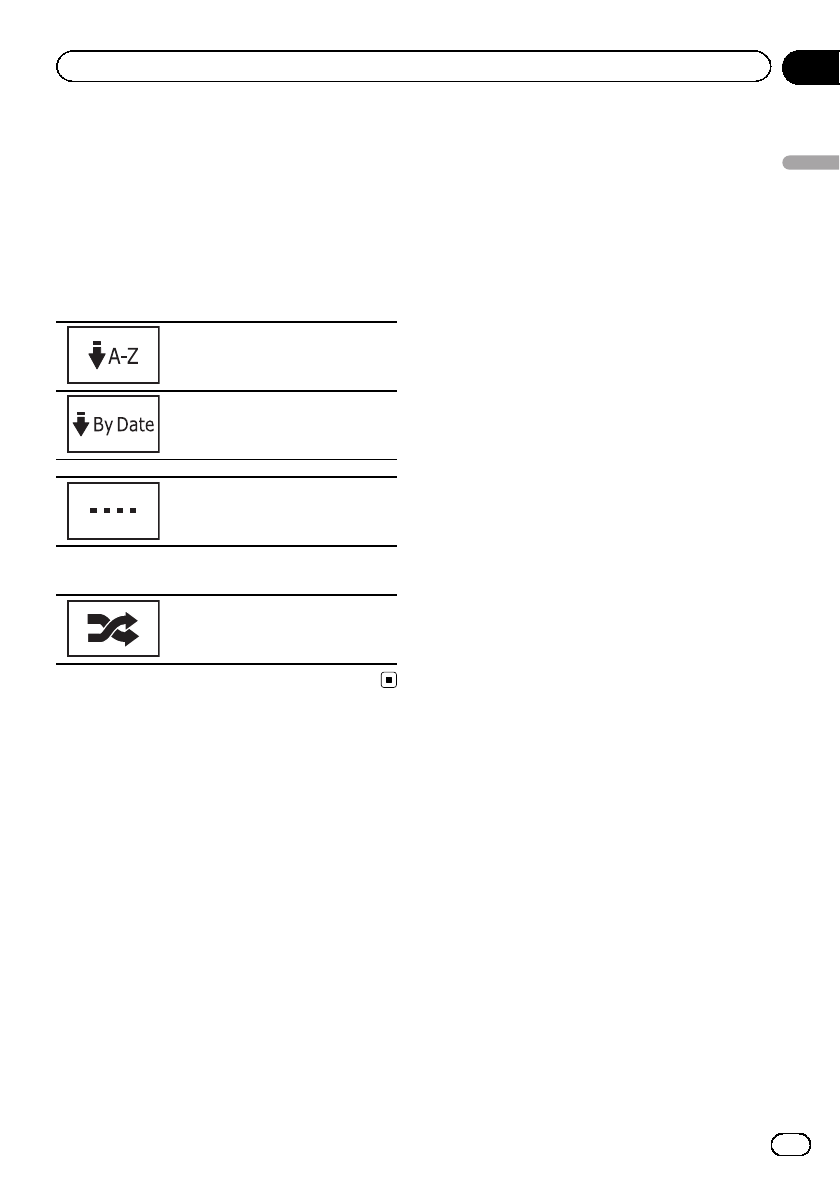
Selecting and playing
Pandoraâstations/QuickMix
Touch the list for your Pandora stations to se-
lect one of them to play.
1 Display the QuickMix/station list.
Refer to Pandora operations on page 33.
2 Change the sort order.
You can sort the items in the list al-
phabetically.
You can sort the items in the list in
order of the dates on which the
items were created.
You can scroll the titles in the list
while you touch and hold down the
scroll icon.
3 Select QuickMix or the desired station.
You can play only one song at a
time from a shuffled mix of several
stations.
Browsing for a video/music
on the iPod
(Function for iPod)
To make operating and searching easy, opera-
tions to control an iPod with this unit are de-
signed to be as similar to the iPod as possible.
Searching for a video/music by
category
1 Display the iPod menus.
Refer to Playing moving images on page 24.
Refer to Playing audio on page 27.
2 Touch one of the categories in which
you want to search for a video/music.
!Video Playlists (video playlists)
!Movies (movies)
!Music Videos (music videos)
!Video Podcasts (video podcasts)
!TV Shows (TV shows)
!Rentals (rentals)
!Playlists (playlists)
!Artists (artists)
!Albums (albums)
!Songs (songs)
!Podcasts (podcasts)
!Genres (genres)
!Composers (composers)
!Audiobooks (audiobooks)
3 Touch the title of the list that you want
to play.
Repeat this operation until you find the de-
sired video/music.
Notes
!You can play playlists created with the PC ap-
plication (MusicSphere). The application will
be available on our website.
!Playlists that you created with the PC applica-
tion (MusicSphere) are displayed in abbre-
viated form.
En 43
Section
14
Detailed instructions
Detailed instructions
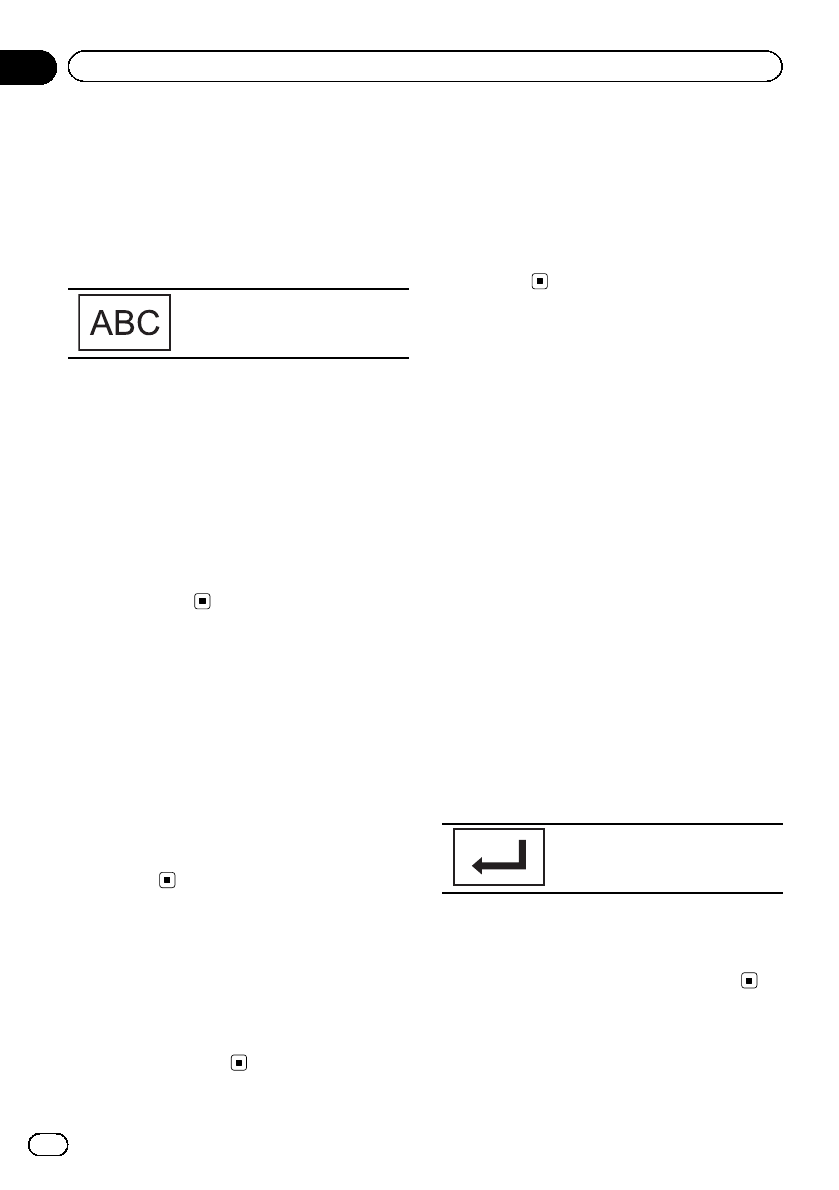
Searching the list by alphabet
(Function for iPod)
1 Select a category.
Refer to Searching for a video/music by cate-
gory on the previous page.
2 Switch to alphabet search mode.
Switching to alphabet search
mode.
Alphabet search mode is displayed.
3 Touch the first letter of the title of the
video/song you are looking for.
While searching, touch panel key operation is
not available.
#To refine the search with a different letter,
touch Cancel.
4 Touch the title of the list that you want
to play.
Repeat this operation until you find the de-
sired song/video.
Resume playback (Bookmark)
(Function for DVD video)
By using the Bookmark function, you can re-
sume playback from a selected scene the next
time the disc is loaded.
The selected scene will be bookmarked so that
playback resumes from that point next time.
!To clear the bookmark on a disc, touch and
hold the key during playback.
!The oldest bookmark is replaced by the
new one.
Frame-by-frame playback
(Function for DVD video/video CD/DivX file/
MPEG-1/MPEG-2/MPEG-4)
Note
Images during frame-by-frame playback may be
unclear for some discs.
Slow motion playback
Notes
!There is no sound during slow motion play-
back.
!Images during slow motion playback may be
unclear for some discs.
!Reverse slow motion playback is not
available.
Searching for the part you
want to play
You can use the search function to find the
part you want to play.
For DVD videos, you can select Title (title),
Chapter (chapter) or 10key (numeric keypad).
For video CDs, you can select Track (track) or
10key (numeric keypad).
!Chapter search is not available when disc
playback is stopped.
!This function cannot be operated during
some DVD videos or Video CD playback
featuring PBC (playback control).
1 Start the search function.
Refer to Playing moving images on page 24.
2 Touch the desired search option (e.g.,
Chapter).
3 Touch 0 to 9 to input the desired num-
ber.
#To cancel the entered numbers, touch C.
4 Start playback from the selected part.
Registering the numbers and start-
ing playback.
Note
With discs featuring a menu, you can also use
the DVD menu to make your selection.
Refer to Playing moving images on page 24.
En
44
Section
14 Detailed instructions
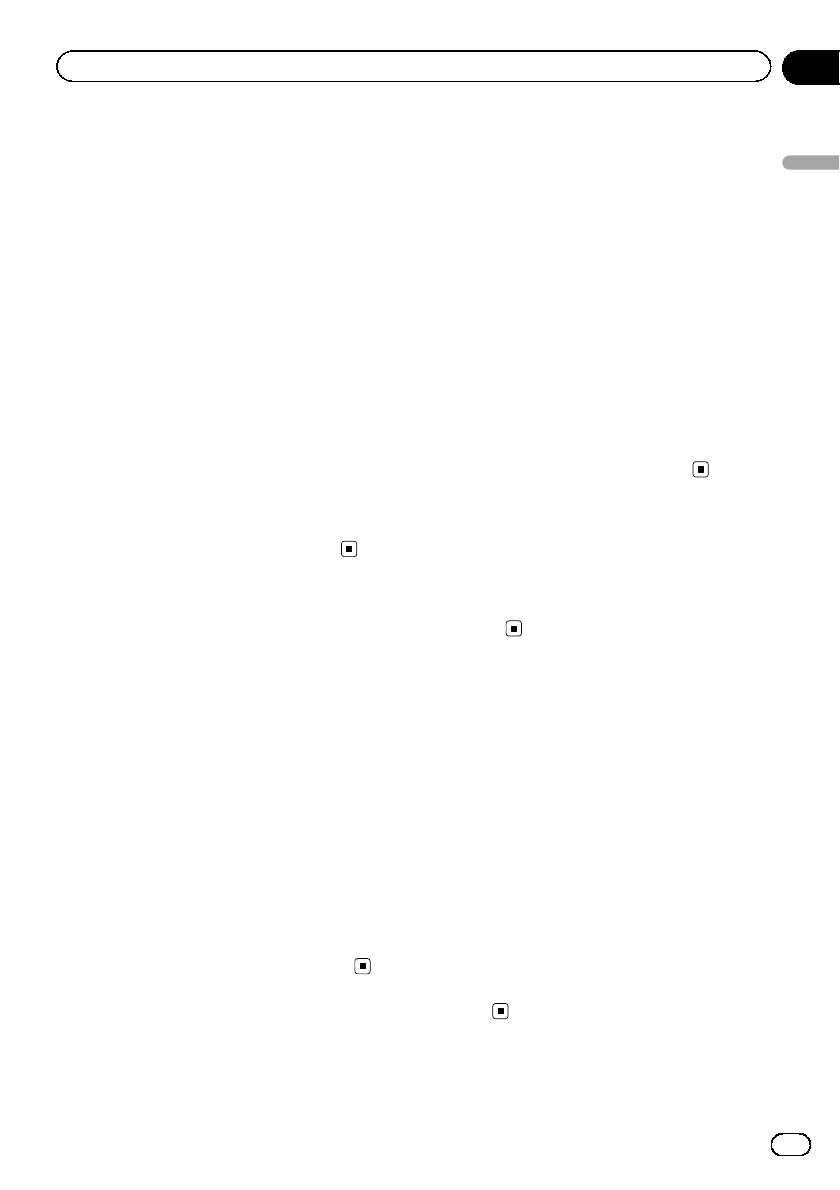
Changing audio language
during playback (Multi-audio)
With DVDs/DivX files that provides audio play-
back in different languages and different
audio systems (Dolby Digital, DTS, etc.), you
can switch between languages/audio systems
during playback.
Notes
!With some DVDs, switching between lan-
guages/audio systems may only be possible
using a menu display.
!You can also switch between languages/audio
systems using Video Setup menu. For details,
refer to Setting the audio language on page 59.
!Depending on the setting, the video may not
be played back with the audio system used to
record the DVD.
!You will return to normal playback if you
change the Audio during fast forward/fast re-
verse, pause or slow motion playback.
Changing the subtitle
language during playback
(Multi-subtitle)
With DVDs/DivX files featuring multi-subtitle
recordings, you can switch between subtitle
languages during playback.
Notes
!With some DVDs, switching between subtitle
languages may only be possible using a menu
display.
!You can also switch between subtitle lan-
guages using Video Setup menu. For details,
refer to Setting the subtitle language on page
59.
!You will return to normal playback if you
change the Subtitle during fast forward/fast
reverse, pause or slow motion playback.
Changing the viewing angle
during playback (Multi-angle)
With DVDs featuring multi-angle (scenes shot
from multiple angles) recordings, you can
switch among viewing angles during play-
back.
!During playback of a scene shot from mul-
tiple angles, the angle icon is displayed.
Use the Video Setup menu to turn the
angle icon display on or off. For details,
refer to Setting the multi-angle DVD display
on page 59.
Note
You will return to normal playback if you change
the viewing angle during fast forward/fast re-
verse, pause or slow motion playback.
Return to the specified scene
(Function for DVD video)
This function cannot be used if a specified
scene has not been preprogrammed on the
DVD disc.
Selecting audio output
When playing DVD video discs recorded with
LPCM audio, you can switch the audio output.
When playing video CDs, you can switch be-
tween stereo and monaural audio output.
!This function is not available when disc
playback is stopped.
!L+R –Left and right
!Left –Left
!Right –Right
!Mix –Mixing left and right
Note
You may not be able to select or use this function
depending on the disc and the playback
location.
En 45
Section
14
Detailed instructions
Detailed instructions
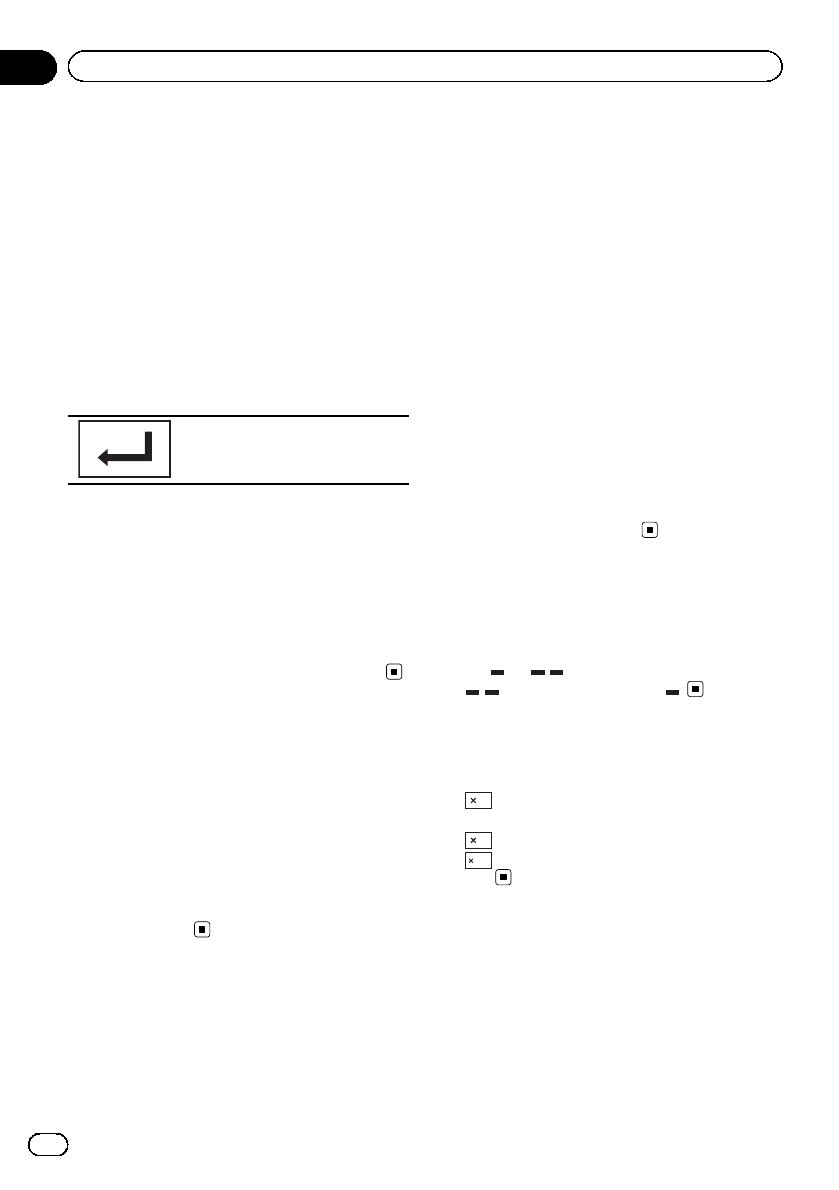
PBC playback
(Function for Video CDs)
During playback of Video CDs featuring PBC
(playback control), PBC On is displayed.
1 Start the search function.
Refer to Playing moving images on page 24.
2 Touch 10key to display the numeric
keypad.
3 Touch 0 to 9 corresponding to a menu
number.
4 Start playback from the selected part.
Registering the numbers and start-
ing playback.
Notes
!You can display the menu by touching Return
during PBC playback. For details, refer to the
instructions provided with the disc.
!PBC playback of a Video CD cannot be can-
celed.
!During playback of Video CDs featuring PBC
(playback control), you cannot select the re-
peat play range or use the search function.
Selecting tracks from the
track title list
You can select tracks to playback using the
track title list which is a list of the tracks re-
corded on a disc.
1 Display the track title list.
Refer to Playing audio on page 27.
2 Touch your favorite track title.
Playback begins.
Selecting files from the file
name list
(Function for compressed audio/DivX/MPEG-1/
MPEG-2/MPEG-4)
File name list is a list of file names (or folder
names) from which you can select a file (or
folder) to play back.
1 Display the file (or folder) name list.
Refer to Playing audio on page 27.
Refer to Introduction of still image playback op-
erations on page 35.
2 Touch your favorite file (or folder)
name.
#When you have selected a folder, a list of the
names of the files (or the folders) in it can be
viewed. Repeat this operation to select the de-
sired file name.
#If folder 1(ROOT) contains no files, playback
commences with folder 2.
Note
If part of the recorded information does not dis-
play, a scroll key appears on the right side of list.
Touch the scroll key to scroll.
Using sound retriever
Automatically enhances compressed audio
and restores rich sound.
Off ——
!is more effective than .
Changing audiobook speed
(Function for iPod)
!2–Playback at a speed faster than nor-
mal
!1–Playback at normal speed
!
1/2
–Playback at a speed slower than nor-
mal
Displaying lists related to
the currently playing song
(Link Search)
(Function for iPod/USB/SD)
1 Touch the artwork display.
Refer to Introduction of sound playback opera-
tions on page 27.
En
46
Section
14 Detailed instructions
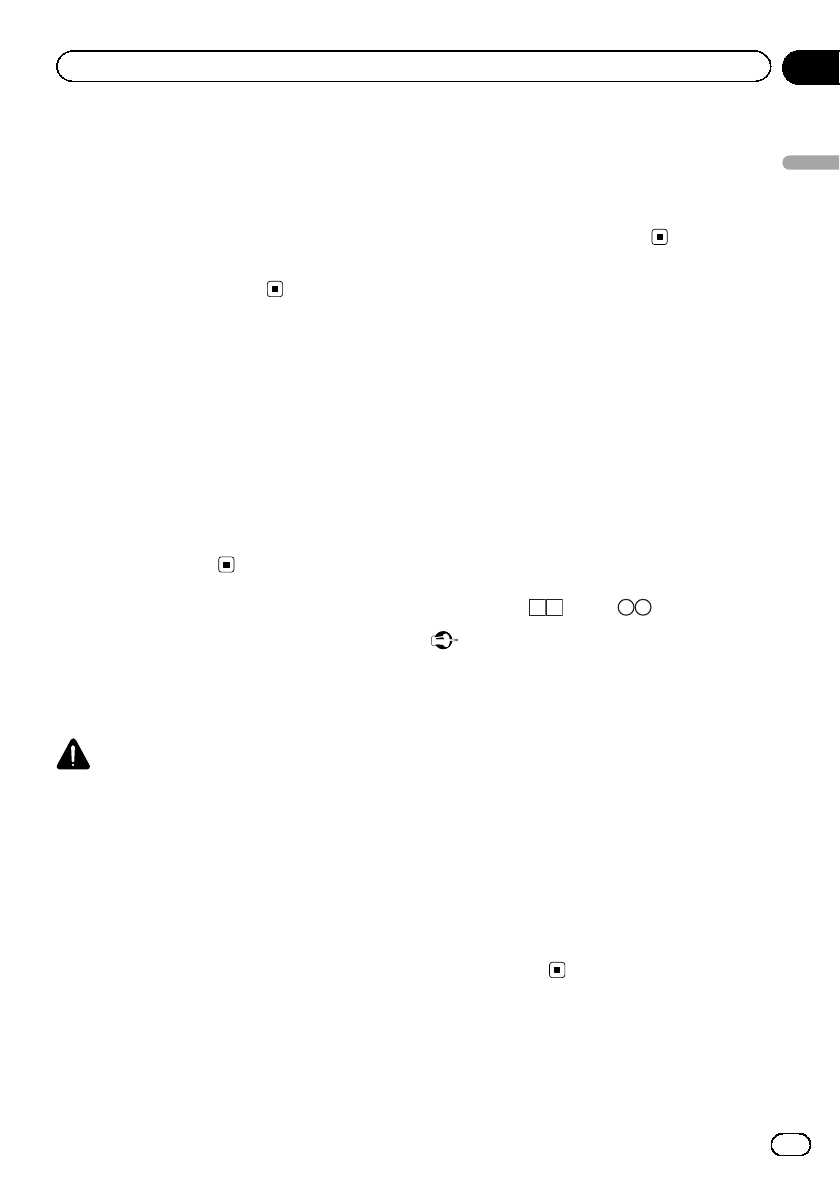
2 Touch the title of the list that you want
to play.
Notes
!If part of the recorded information does not
display, a scroll key appears on the right side
of list. Touch the scroll key to scroll.
!This function is available for USB/SD when
using Music browse mode.
Setting the Advanced
Display Resolution
(Function for USB/SD)
You can increase the resolution of moving
images on your USB/SD storage device.
OFF—1—2
!With some pictures, display adjustment
may not be possible.
!There may not be any effect observed in
some cases depending on the images
being played back.
Music Browse mode
(Function for USB/SD)
This unit creates an index in order to facilitate
browsing for a song. You can search by the ca-
tegories such as Albums and Artists.
CAUTION
!This function is not available when the USB/
SD storage device is locked.
!This function is not available when the free
space of USB/SD storage device is 5MB.
!While this unit creates an index, do not turn
the unit off. It may cause loss of data on your
USB/SD storage device.
1 Create the database in Music browse
mode.
Refer to Introduction of sound playback opera-
tions on page 27.
2 When “Save the Database to memory?”
is displayed, touch “Yes”
Saving of the database is completed. If you do
not save it, touch “No”.
When the saving is completed, “Database
save to memory was completed.”appears.
3 Display a list and touch the tag key.
4 Select a file.
Music browse mode will start.
Playing DivXâVOD content
Some DivX video on demand (VOD) content
may only be playable a fixed number of times.
When you load a disc containing this type of
content, the number of times it has been
played will be shown on-screen. You can then
decide whether or not to play the disc.
!If there is no limit to the number of times
the DivX VOD content can be viewed, then
you may load the disc into your player and
play the content as often as you like, and
no message will be displayed.
!You can confirm the number of times that
the content can be played by checking the
number displayed after This DivX rental
has used out of views..
Important
!In order to play DivX VOD contents on this
unit, you first need to register the unit with
your DivX VOD contents provider. For details
on your registration code, refer to Displaying
the DivXâVOD registration code on page 62.
!DivX VOD content is protected by a DRM (Di-
gital Rights Management) system. This re-
stricts playback of content to specific,
registered devices.
%If a message is displayed after loading
a disc containing DivX VOD content, touch
Play.
Playback of the DivX VOD content will start.
#To skip to the next file, touch Next Play.
#If you do not want to play the DivX VOD con-
tent, touch Stop.
En 47
Section
14
Detailed instructions
Detailed instructions
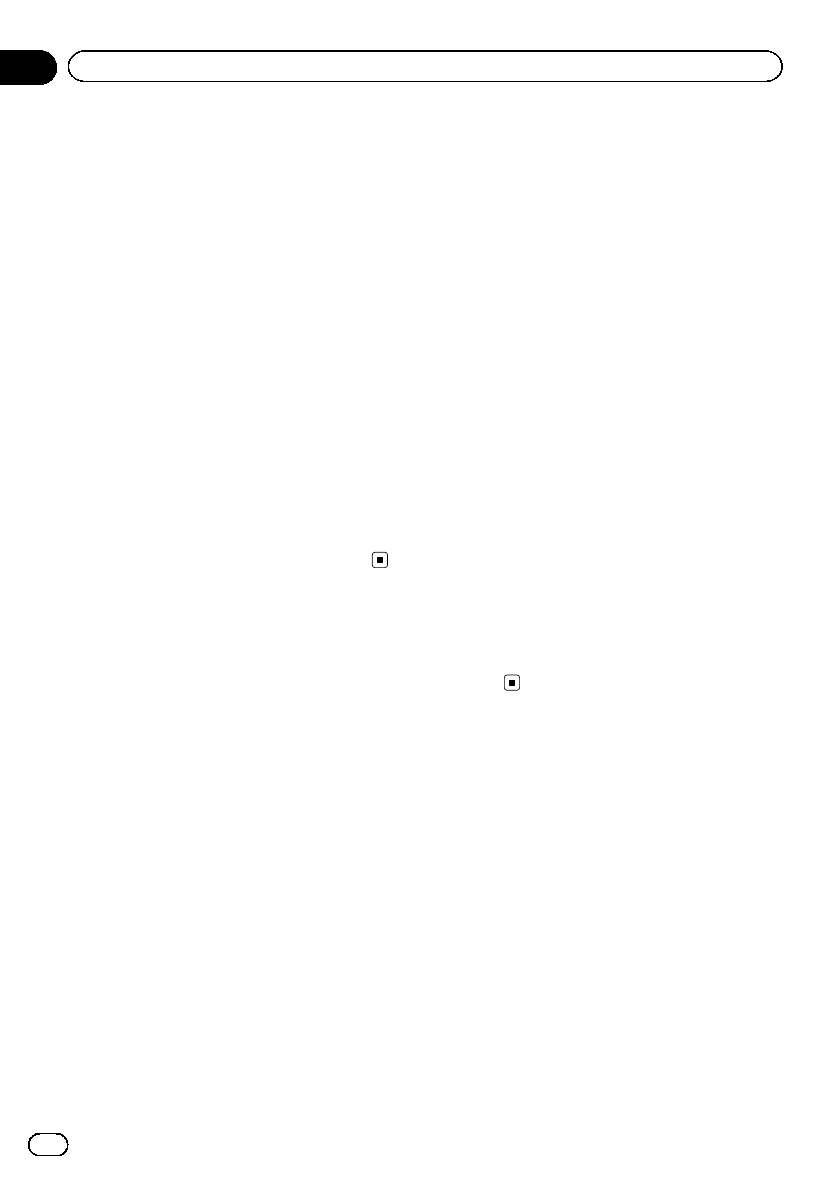
Capture an image in JPEG files
You can capture image data and use it as wall-
paper. Images can be stored and recalled ea-
sily in this unit.
!Only one image can be stored on this unit.
Old image is overwritten with the new one.
1 Pause the slideshow when the desired
image is displayed.
Refer to Introduction of still image playback op-
erations on page 35.
2 Capture the image.
Refer to Introduction of still image playback op-
erations on page 35.
3 When “Do you save this image?”is dis-
played, touch Yes.
While storing the image to this unit, “Saving
the image. Don’t switch off the battery.”is
displayed. When the process is finished,
“Image saved.”is displayed.
#To cancel the storage process, touch No.
Changing the wide screen
mode
You can select a desired mode for enlarging a
4:3 picture to a 16:9 picture.
1 Display the screen mode.
Refer to Introduction of video playback opera-
tions on page 24.
Refer to Introduction of still image playback op-
erations on page 35.
2 Touch the desired wide mode setting.
FULL (full screen)
The 4:3 picture is enlarged in the horizontal direc-
tion only, giving you a 4:3 TV picture (normal pic-
ture) without any omissions.
ZOOM (zoom)
The 4:3 picture is enlarged in the same proportion
both vertically and horizontally; ideal for a cinema
sized picture (wide screen picture).
NORMAL (normal)
The 4:3 picture is displayed as it is, giving you no
sense of disparity since its proportions are the
same as that of the normal picture.
TRIMMING (trimming)
The image is displayed across the entire screen
with the horizontal-to-vertical ratio left as is. If the
horizontal-to-vertical ratio differs between the dis-
play and the image, the image may be displayed
partly cut off either at the top/bottom or sides.
Notes
!You cannot operate this function while driving.
!Different settings can be stored for each video
source.
!When a video is viewed in a wide screen mode
that does not match its original aspect ratio, it
may appear different.
!Remember that using the wide mode feature
of this system for commercial or public view-
ing purposes may constitute an infringement
on the author’s rights protected by the Copy-
right Law.
!The video image will appear coarser when
viewed in ZOOM mode.
!FULL/ZOOM/NORMAL is used for videos.
NORMAL/TRIMMING is used for JPEG im-
ages.
Switching the XM/SIRIUS
channel selection mode
You have two methods for selecting a channel:
by number and by category. When selecting
by number, channels in any category can be
selected. Select by category to narrow your
search down to only channels in a particular
category.
Mode All CH (channel number select setting)
—Mode Category (channel category select
setting)
En
48
Section
14 Detailed instructions
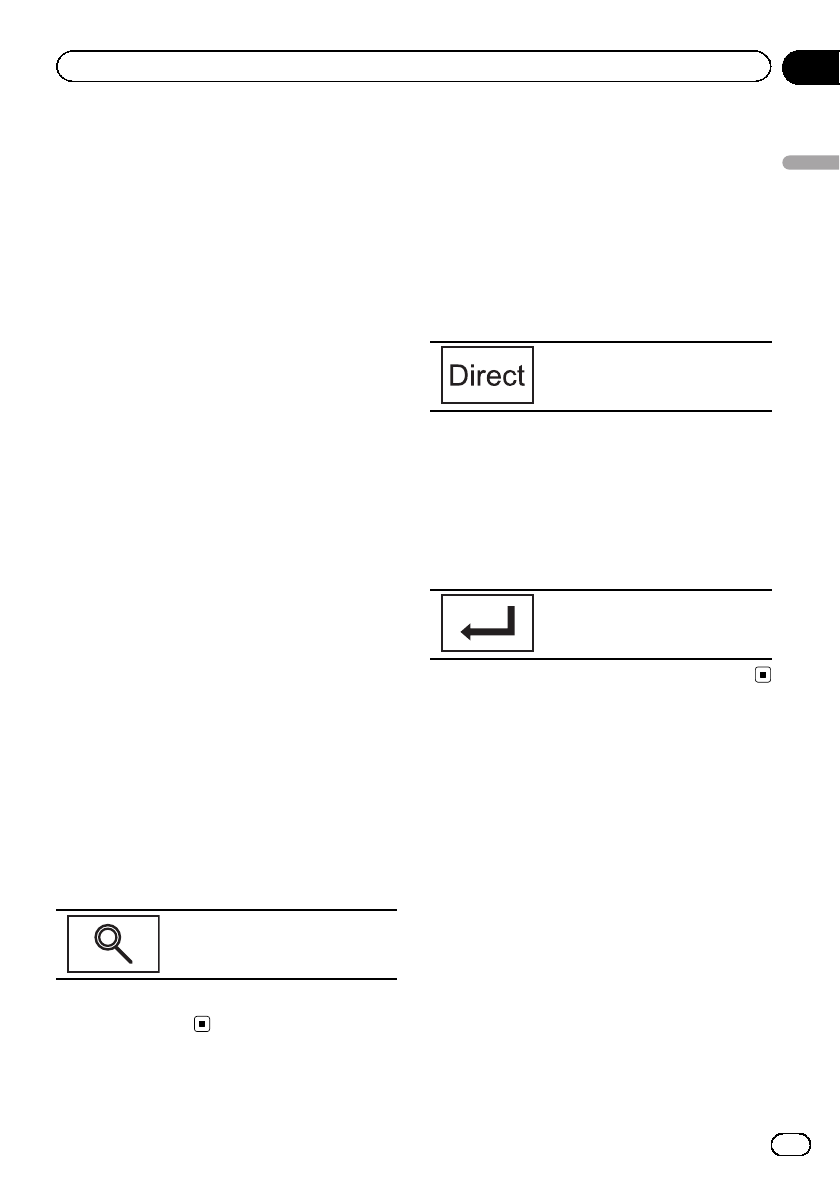
Selecting a SIRIUS channel from
a channel category
Channels are organized into various program
categories, e.g. Rock, Classic, Jazz while lis-
tening to a SIRIUS station. You can specify
channels by selecting the desired category.
1 Select channel category selection
mode.
Refer to Introduction of XM/SIRIUS tuner opera-
tions on page 22.
Mode All CH (channel number select setting)
—Mode Category (channel category select
setting)
2 Touch cor dto select the desired chan-
nel category.
3 Touch cor don the buttons to select
the desired channel in the selected channel
category.
Selecting a channel from the
XM channel list display
The list content can be switched so you can
search for the track you want to listen to not
only by the channel name but also by the artist
name or song title.
!This function is available for GEX-P920XM.
!The channel list shows all the channels
during Mode All CH mode, and the chan-
nels included in the selected category dur-
ing Mode Category mode.
1 Display the preset channel list.
Refer to Introduction of XM/SIRIUS tuner opera-
tions on page 22.
2 Switch the channel list mode.
Switching the channel list mode to
the channel name or the artist
name/song title.
3 Touch the desired channel that you
want to listen to.
Selecting an XM/SIRIUS
channel directly
You can select an XM/SIRIUS channel directly
by entering the desired channel number.
1 Display the preset channel list.
Refer to Introduction of XM/SIRIUS tuner opera-
tions on page 22.
2 Switch to direct input display.
Switching to direct input display.
3 Touch 0 to 9 to input the desired chan-
nel number.
#To cancel the input numbers, touch C.
4 Select the XM/SIRIUS channel of the en-
tered number.
The XM/SIRIUS channel of the entered num-
ber is selected.
Selecting the XM/SIRIUS channel
of the entered number.
Using the Game Alert function
This system can alert you when games invol-
ving your favorite teams are about to start. To
use this function you need to set up a game
alert for the teams in advance.
!This function is available for SIR-PNR2/SIR-
PNR2C.
Selecting teams for Game Alert
1 Start Game Alert setup.
Refer to Introduction of XM/SIRIUS tuner opera-
tions on page 22.
En 49
Section
14
Detailed instructions
Detailed instructions
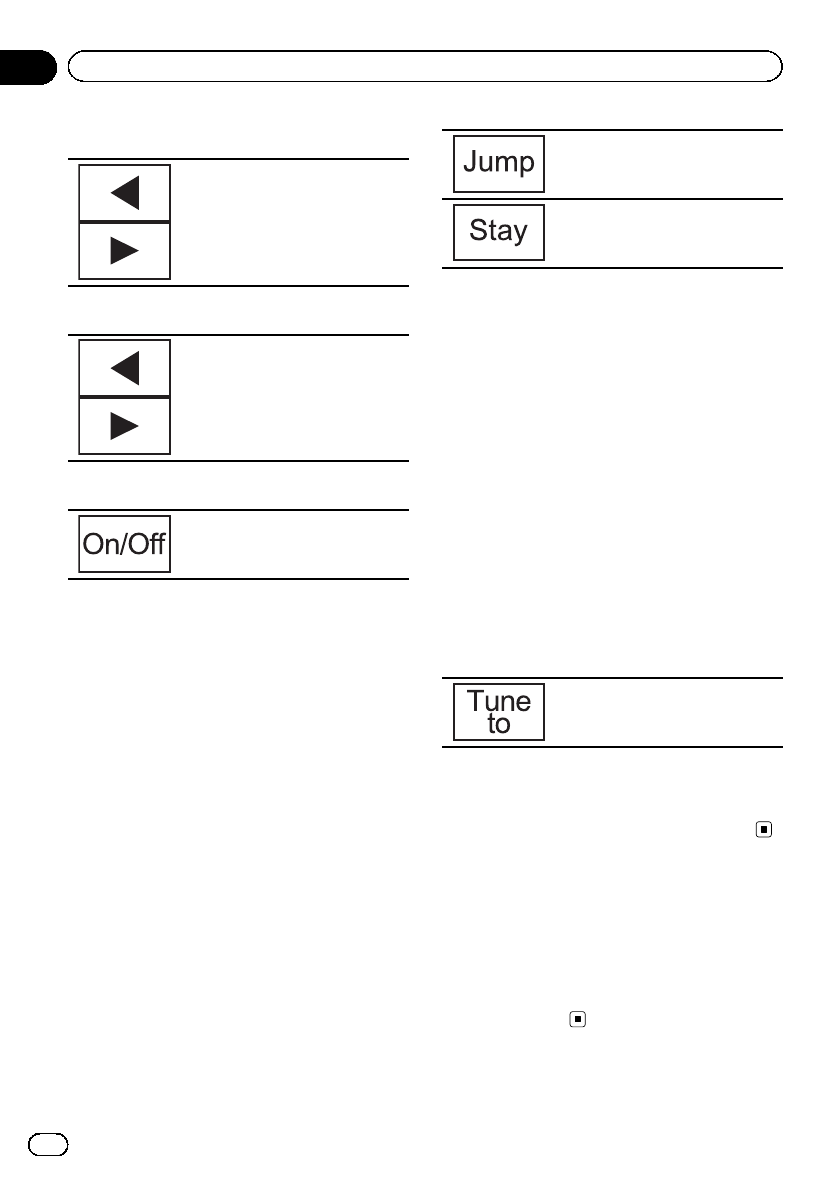
2 Select a desired league in League.
Switching the league name.
3 Select a desired team in Team.
Switching the team name.
4 Turn the alert on or off.
Turning the alert on or off.
The game alert function is activated for that
team.
#When you have already selected 12 teams,
FULL is displayed and additional teams cannot
be selected. In this case, first delete a selected
team and then try again.
5 Repeat these steps to select other
teams.
Up to 12 teams can be selected.
Switching the Game Alert on or off
Once you select the teams, you need to turn
the Game Alert function on.
The Game Alert function is on at the default
setting.
When a game of a selected
team starts
When a game of the selected team is about to
start (or is currently playing) on a different sta-
tion, a game alert is displayed.
Switching to the other station to
listen to the game.
Not tuning in to the other station.
Displaying game information
If any games of the selected teams are cur-
rently playing, you can display information on
the games and tune in to the broadcast chan-
nel.
1 Display the game information for the
selected team.
Refer to Introduction of XM/SIRIUS tuner opera-
tions on page 22.
2 Touch cor dto select a game.
The game is displayed, followed by more de-
tailed game information.
!The game score will be updated automati-
cally.
3 Switch to the other station to listen to
the game.
Switching to the other station to
listen to the game.
#If you have not selected any teams, NOT SET
is displayed.
#When games involving your favorite teams are
not currently playing, NO GAME is displayed.
Displaying the Radio ID
Channel number selection setting
If you select CH000, the ID code is displayed.
%Select CH000.
Refer to Introduction of XM/SIRIUS tuner opera-
tions on page 22.
En
50
Section
14 Detailed instructions
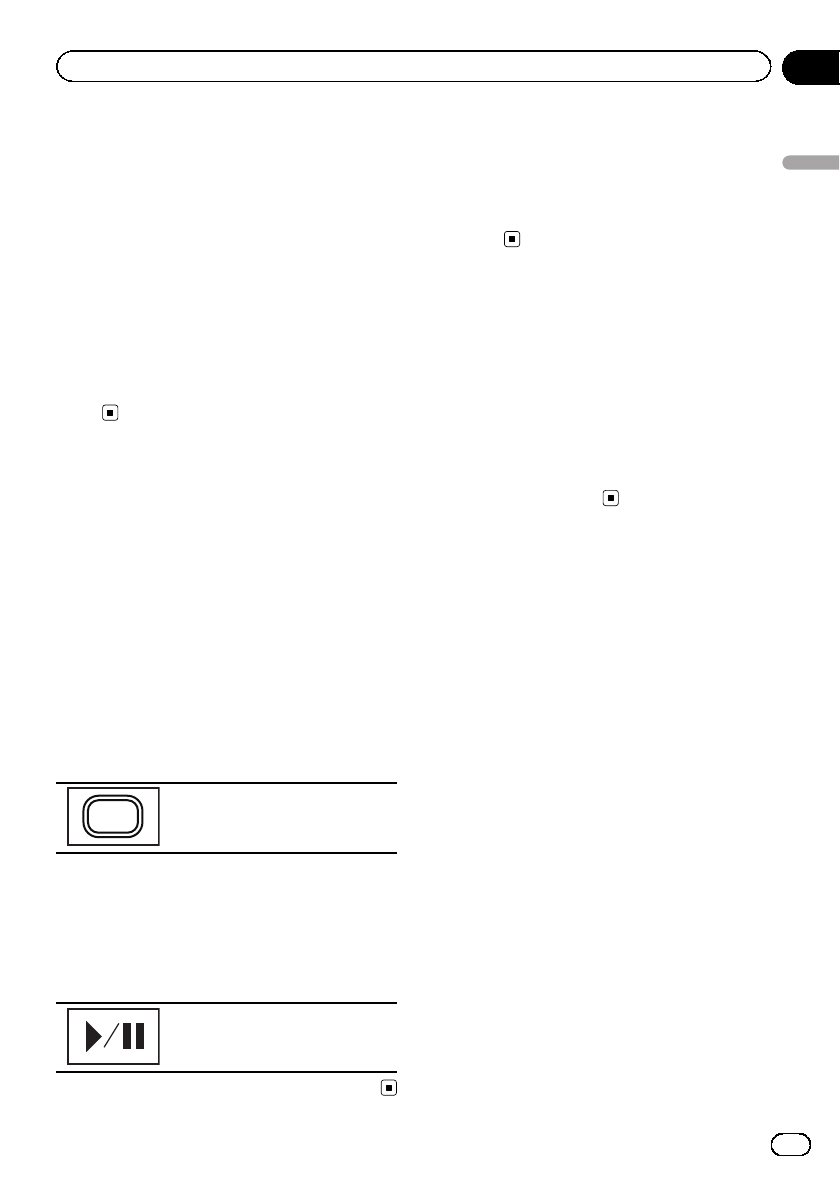
Switching the SIRIUS display
!Actions will differ depending on the con-
nected SIRIUS tuner.
%Touch SIRIUS tuner information to
switch the SIRIUS display.
Refer to Introduction of XM/SIRIUS tuner opera-
tions on page 22.
Channel number—Channel name—Category
name—Artist name—Song title/Title name—
Composer name—Play time
Note
Play time is displayed during the Instant Replay
mode.
Using the Instant Replay
function
The following functions can be operated in In-
stant Replay mode.
!To use this function, a Pioneer SIRIUS bus
interface (e.g. CD-SB10) is required.
!To use this function, a SIRIUS plug-and-
play unit with an Instant Replay Function is
required.
!For details, refer to the SIRIUS plug-and-
play unit’s manuals.
%To exit from Instant Replay mode, se-
lect another source or touch the following
icon.
Live
Live
Live
Exiting from Instant Replay mode.
%Select a track
Press cor d(TRK).
%Fast forward or reverse
Press and hold cor d(TRK).
%Pause and play
Playing and pausing.
Switching the seek mode
There are two seek tuning settings, one is HD
(Digital broadcasting stations seek) and the
other is ALL (normal seek).
ALL—HD
Switching the reception mode
If the reception for a digital broadcast be-
comes poor, this unit automatically switches
to the analog broadcast of the same fre-
quency. If this function is set to D/A AUTO,
the tuner switches between digital broadcast
and analog broadcast automatically. If this
function is set to ANALOG, the tuner will only
receive analog broadcasts.
D/A AUTO—ANALOG
Calling a number in the
phone book
The phone book in your cellular phone will be
transferred automatically when the phone is
connected to this unit.
After finding the number you want to call in
the phone book, you can select the entry and
make the call.
1 Switch to phone book mode.
Refer to Introduction of Bluetooth telephone op-
erations on page 37.
The phone book display appears.
2 Select the phone number list.
The detailed phone number list of the selected
entry is displayed.
3 Select the phone number.
#If you want to store the phone number, touch
and hold the list.
4 Make the call.
Refer to Introduction of Bluetooth telephone op-
erations on page 37.
5 End the call.
Refer to Introduction of Bluetooth telephone op-
erations on page 37.
En 51
Section
14
Detailed instructions
Detailed instructions
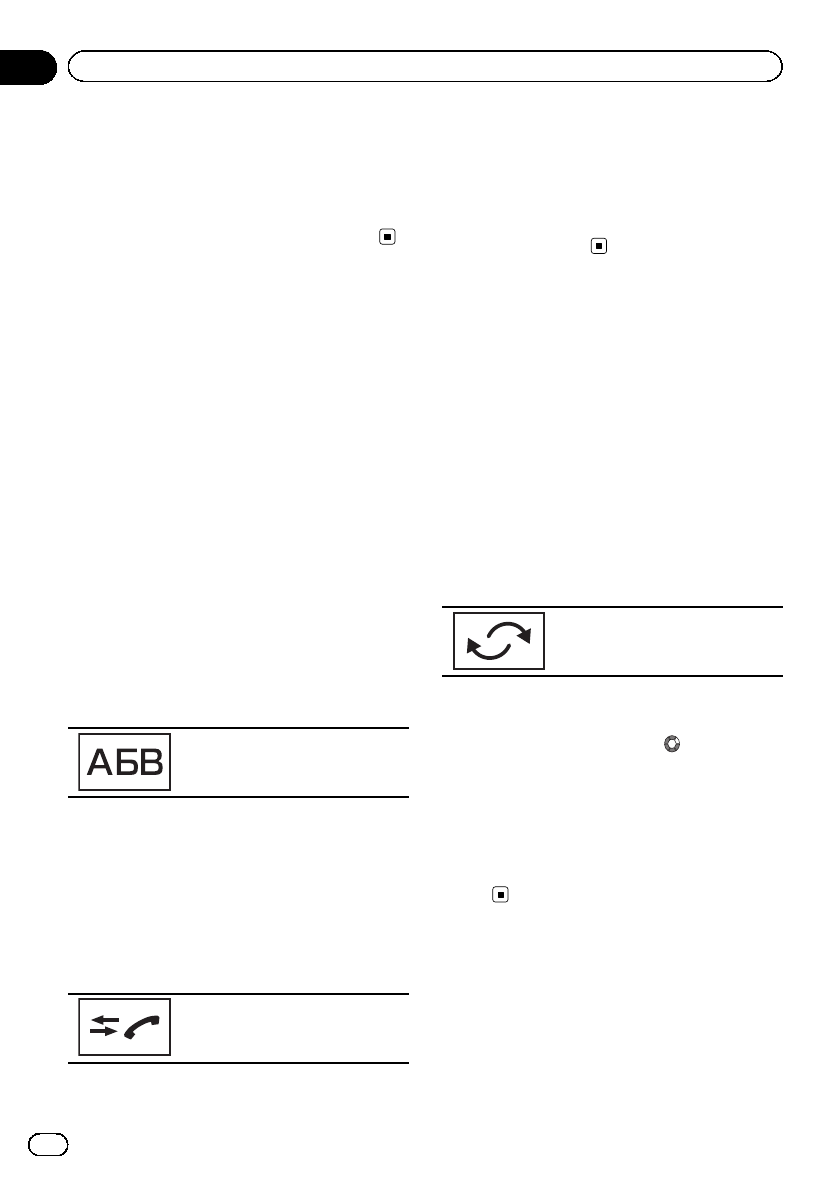
Note
Depending on the cellular phone, the phone book
may not be transferred automatically. In this
case, operate your cellular phone to transfer the
phone book. The visibility of this unit should be
on. Refer to Switching visible unit on page 71.
Selecting a number by
alphabet search mode
If a lot of numbers are registered in the phone
book, you can search for the phone number by
alphabet search mode.
1 Switch to phone book mode.
Refer to Introduction of Bluetooth telephone op-
erations on page 37.
The phone book display appears.
2 Touch ABC to switch to alphabet search
mode.
3 Touch the first letter of the entry you
are looking for.
The Phone Book entries starting with that let-
ter (e.g. “Ben”,“Brian”and “Burt”when “B”is
selected) will be displayed.
#If you want to change the character to Rus-
sian, touch the icon. To return to English, touch
the icon again.
Changing the character to Rus-
sian.
#The order of the first name and last name may
be different from that of the cellular phone.
4 Touch the list to display the phone
number list of the selected entry.
#If several phone numbers are included in an
entry, select one by touching the list.
#If you want to switch to the call history list,
touch the icon.
Switching to the call history list.
5 Make the call.
Refer to Introduction of Bluetooth telephone op-
erations on page 37.
6 End the call.
Refer to Introduction of Bluetooth telephone op-
erations on page 37.
Inverting names in phone
book
When your cellular phone is connected to this
unit, the first and last names of your contacts
may be registered to the phone book in reverse
order. You can use this function to change the
order back.
(Inverting the names in the phone book)
1 Switch to phone book mode.
Refer to Introduction of Bluetooth telephone op-
erations on page 37.
The phone book display appears.
2 Invert names in phone books.
Inverting names in phone books.
3“Would you like to invert all names?”
appears. Touch Yes to continue.
While the names are inverted, is displayed.
#If the inversion fails, “Invert Name Error”ap-
pears. In such cases, try again from the begin-
ning.
Note
Inverting the names of your contacts from this
unit does not affect the data on your Bluetooth
device.
Using the missed, received
and dialed call lists
The 80 most recent calls dialed, received, and
missed are stored in the memory. You can
browse them and call numbers from these
lists.
En
52
Section
14 Detailed instructions
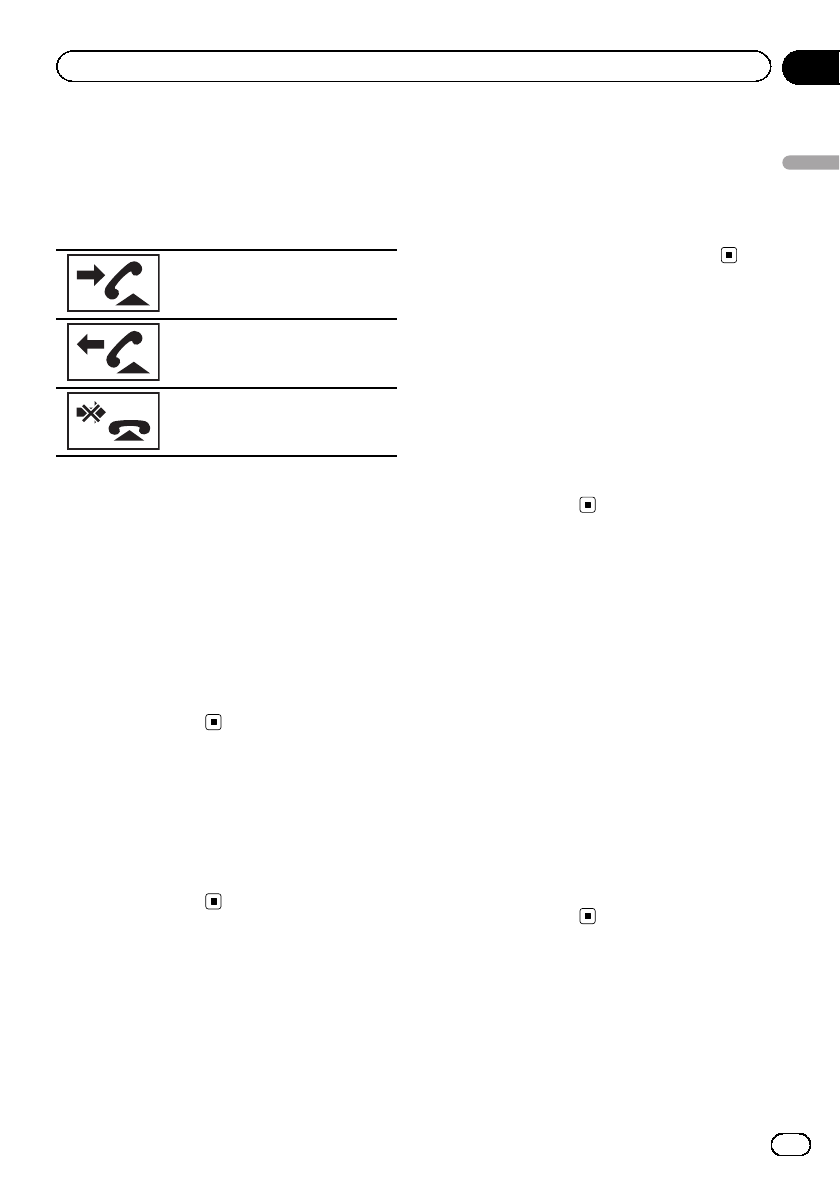
1 Switch to the call history list.
Refer to Introduction of Bluetooth telephone op-
erations on page 37.
2 Select Missed Calls, Dialed Calls or
Received Calls.
Displaying the received call list.
Displaying the dialed call list.
Displaying the missed call list.
3 Touch the list number to select a phone
number.
Name and phone number are displayed in the
detailed list.
#If you want to store the phone number, touch
and hold the list.
4 Make the call.
Refer to Introduction of Bluetooth telephone op-
erations on page 37.
5 End the call.
Refer to Introduction of Bluetooth telephone op-
erations on page 37.
Setting automatic answering
If this function is on, this unit automatically
answers all incoming calls.
%Turn automatic answering on or off.
Refer to Introduction of Bluetooth telephone op-
erations on page 37.
Adjusting the other party’s
listening volume
To maintain the good sound quality, this unit
can adjust the other party’s listening volume.
If the volume is not loud enough for the other
party, use this function.
%Select Far-End VOL.
Refer to Introduction of Bluetooth telephone op-
erations on page 37.
1—2—3
#This function can be performed even while
talking on the phone.
#Settings can be stored for each device.
Switching the ring tone
You can select whether or not to use this
unit’s ring tone. If this function is set to on,
the ring tone for this unit will sound.
1 Connect your cellular phone to this
unit.
2 Turn ring tone on or off.
Refer to Introduction of Bluetooth telephone op-
erations on page 37.
Using the preset dial lists
You can easily store up to six phone numbers
as presets.
1 Display the preset screen.
Refer to Introduction of Bluetooth telephone op-
erations on page 37.
2 Touch one of preset dial keys to select
the desired phone number.
#If you want to delete a preset phone number,
touch and hold the preset dial key.
3 Make the call.
Refer to Introduction of Bluetooth telephone op-
erations on page 37.
4 End the call.
Refer to Introduction of Bluetooth telephone op-
erations on page 37.
En 53
Section
14
Detailed instructions
Detailed instructions
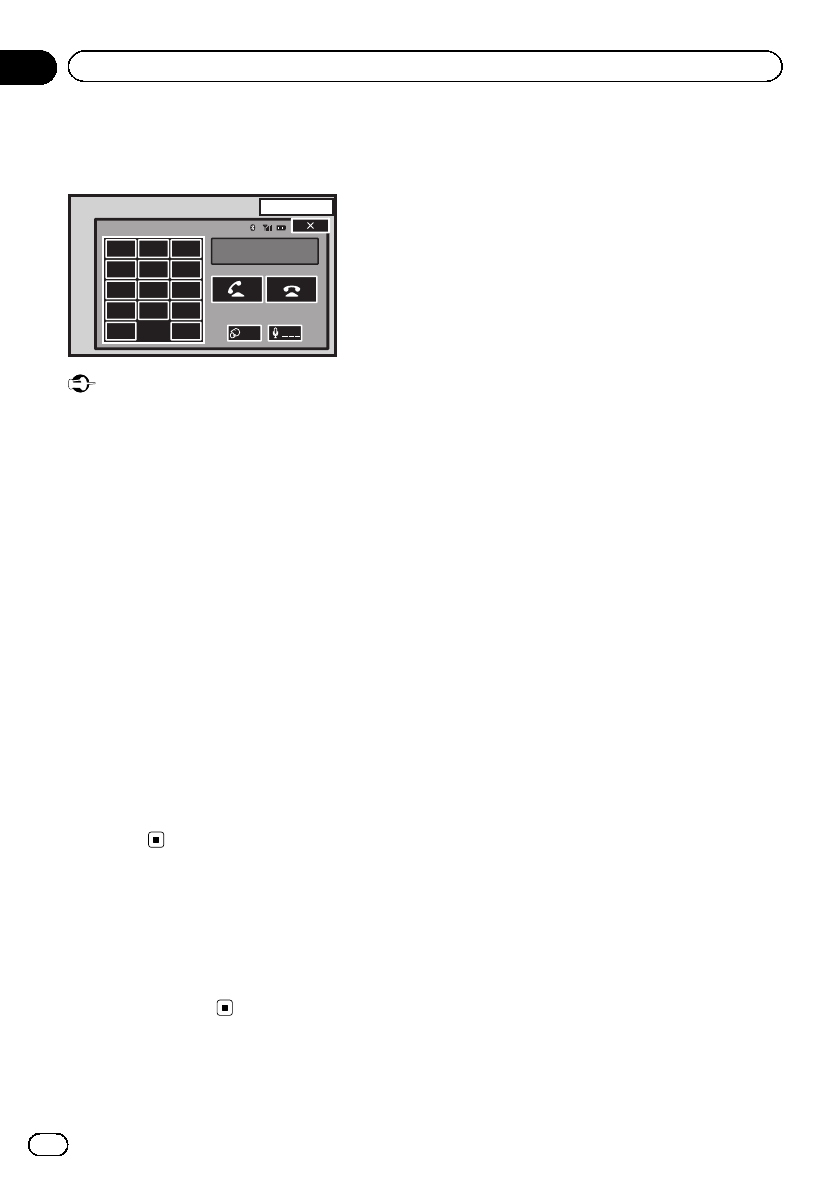
Making a call by entering
phone number
13 APR
PM
12:25
1
123
456
789
*0#
C+
Abcdefghi
XXXXXXXXXXXXXXXX
Private
ON
Vol
Important
Be sure to park your vehicle in a safe place and
apply the parking brake when performing this op-
eration.
1 Switch to the entering phone number
mode.
Refer to Introduction of Bluetooth telephone op-
erations on page 37.
2 Touch the number icons to input the
numbers.
#Up to 24 digits can be entered.
3 Make the call.
Refer to Introduction of Bluetooth telephone op-
erations on page 37.
4 End the call.
Refer to Introduction of Bluetooth telephone op-
erations on page 37.
Note
Entering phone number mode cannot be oper-
ated unless a Bluetooth telephone is connected
to this unit.
Setting the private mode
During a conversation, you can switch to pri-
vate mode (talk directly on your cellular
phone).
Refer to Introduction of Bluetooth telephone op-
erations on page 37.
En
54
Section
14 Detailed instructions
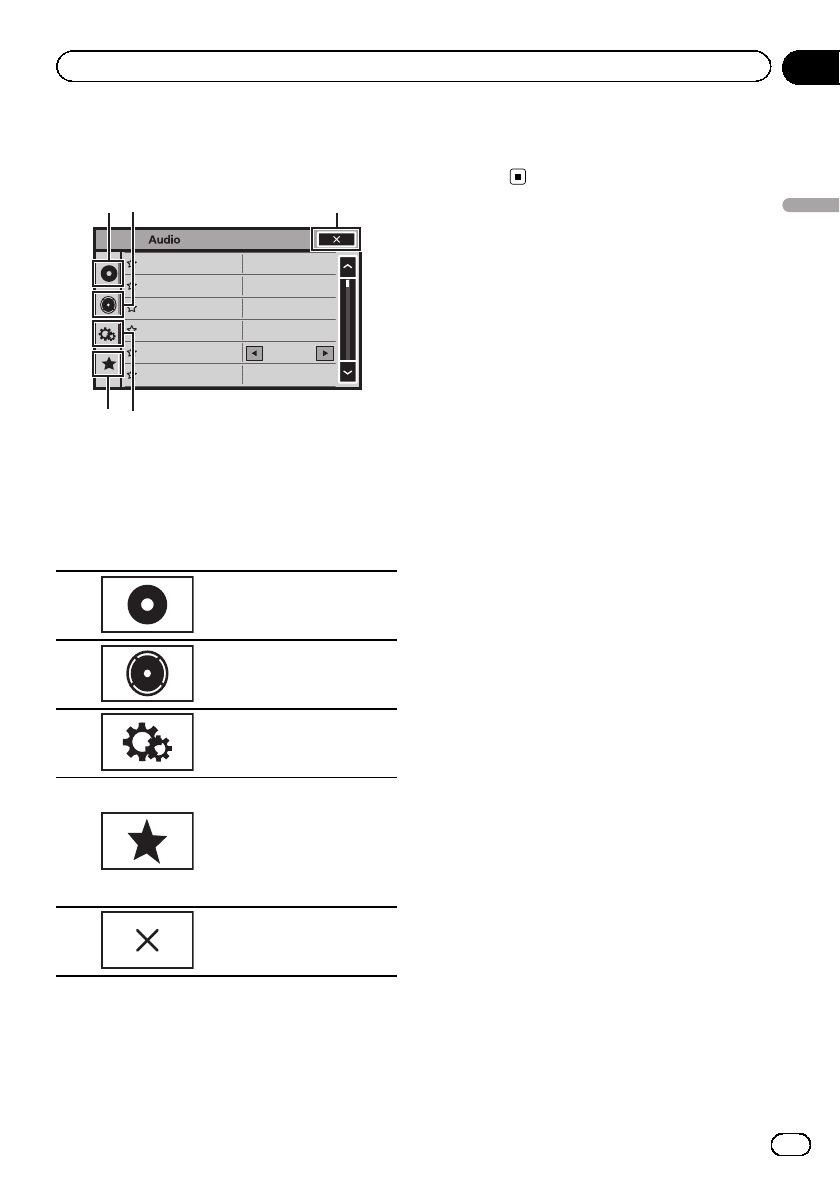
Introduction of menu
operations
SonicCenter Control FR:0
Powerful
On
LR:0
LR:0
OFF
ON
Loudness
Subwoofer
Bass Booster
High Pass Filter
Source Level Adjuster
Fader/Balance F/R 0
Powerful
Off
L/R 0
L/R 0
OFF
ON
Graphic EQ
Auto EQ
Sonic Center Control
Loudness
Subwoofer
12
43
5
1 Display menus.
Refer to Basic operations on page 14.
2 Touch any of the following touch panel
keys to select the menu to be adjusted.
Touch panel keys
1
Video Setup menu
Refer to Setting up the Video
player on page 59.
2
Audio function menu
Refer to Audio adjustments
on the next page.
3
System menu
Refer to System settings on
page 63.
4
Favorite menu
You can choose menus with-
in each menu (Audio func-
tion menu, etc.) and register
them to this favorite menu.
Refer to Favorite menu on
page 69.
5Returning to the current
source display
Notes
!You can display the Video Setup menu when
aDisc,USB or SD source is selected.
!If you start the Video Setup menu, playback
is stopped.
!You cannot display the Audio function menu
when the mute function is on or a JPEG file is
playing.
En 55
Section
15
Menu operations
Menu operations

Audio adjustments
Using fader/balance adjustment
You can change the fader/balance setting to
provide an ideal listening environment for all
of the occupied seats.
1 Display the audio function menu.
Refer to Introduction of menu operations on
the previous page.
2 Touch Fader/Balance on the audio func-
tion menu.
3 Touch aor bto adjust the front/rear
speaker balance.
Range: Front 15 to Rear 15
#Select F/R 0 L/R 0 when only using two
speakers.
#The front/rear speaker balance cannot be ad-
justed when the rear output setting is
Subwoofer. Refer to Setting the rear output and
subwoofer controller on page 63.
4 Touch cor dto adjust the left/right
speaker balance.
Range: Left 15 to Right 15
Note
You can also set the fader/balance by dragging
the dot on the displayed table.
Using the equalizer
You can adjust the equalization to match the
car’s interior acoustic characteristics as de-
sired.
Recalling equalizer curves
There are seven stored equalizer curves which
you can easily recall at any time. Here is a list
of the equalizer curves.
Display Equalizer curve
Powerful Powerful
Natural Natural
Vocal Vocal
Display Equalizer curve
Flat Flat
Custom1 Custom 1
Custom2 Custom 2
S.Bass Super bass
!The equalizer curves for Custom1 and
Custom2 can be adjusted.
!You cannot select Custom1 and Custom2
when using the auto-equalizer.
!When Flat, no changes are made to the
sound. You can check the effects of the
equalizer curves by switching alternatively
between Flat and another equalizer curve.
1 Display the audio function menu.
Refer to Introduction of menu operations on
the previous page.
2 Touch Graphic EQ on the audio function
menu.
#You cannot select or adjust the equalizer
curves of Custom1 and Custom2 when using the
auto-equalizer.
3 Touch the desired setting.
S.Bass—Powerful—Natural—Vocal—Flat—
Custom1—Custom2
Adjusting the 8-band graphic equalizer
You can adjust the level of each band for the
equalizer curves.
!A separate Custom1 curve can be created
for each source. If you make adjustments
when a curve other than Custom2 is se-
lected, the equalizer curve settings will be
stored in Custom1.
!ACustom2 curve that is common for all
sources can be created. If you make adjust-
ments when the Custom2 curve is se-
lected, the Custom2 curve will be updated.
1 Display the audio function menu.
Refer to Introduction of menu operations on
the previous page.
En
56
Section
15 Menu operations

2 Touch Graphic EQ on the audio function
menu.
3 Touch the desired setting.
S.Bass—Powerful—Natural—Vocal—Flat—
Custom1—Custom2
4 Touch the table to adjust the level of
the equalizer band.
Range: +12dB to –12dB
Using the auto-equalizer
The auto-equalizer is an equalizer curve cre-
ated by auto EQ (refer to Auto EQ (auto-equaliz-
ing) on page 67).
You can turn the auto-equalizer on or off.
If you connect an optional microphone to this
unit, you can use this function.
1 Display the audio function menu.
Refer to Introduction of menu operations on
page 55.
2 Touch Auto EQ to turn the auto-equali-
zer on or off.
#You cannot use this function if auto EQ has
not been carried out.
Using sonic center control
Sound that is suited for the listening position
can easily be created with this function.
1 Display the audio function menu.
Refer to Introduction of menu operations on
page 55.
2 Touch Sonic Center Control on the
audio function menu.
3 Touch cor dto select a listening posi-
tion.
Range: Left 7 to Right 7
Adjusting loudness
Loudness compensates for deficiencies in the
low-frequency and high-frequency ranges at
low volume.
1 Display the audio function menu.
Refer to Introduction of menu operations on
page 55.
2 Touch cor dto select a desired level
for loudness.
Off (off)—Low (low)—Mid (mid)—High
(high)
Using subwoofer output
This unit is equipped with a subwoofer output
which can be turned on or off.
!The cut-off frequency and output level can
be adjusted when the subwoofer output is
on.
1 Display the audio function menu.
Refer to Introduction of menu operations on
page 55.
2 Touch Subwoofer on the audio function
menu.
3 Touch On or Off next to Subwoofer to
turn the subwoofer output on or off.
4 Touch Normal or Reverse next to Phase
to select the phase of subwoofer output.
5 Touch cor dnext to Level to adjust
the output level of the subwoofer.
Range: +6 to –24
6 Touch cor dnext to Frequency to se-
lect the cut-off frequency.
50Hz—63Hz—80Hz—100Hz—125Hz
Only frequencies lower than those in the se-
lected range are outputted from the subwoo-
fer.
Boosting the bass
You can boost the bass level.
En 57
Section
15
Menu operations
Menu operations

1 Display the audio function menu.
Refer to Introduction of menu operations on
page 55.
2 Touch cor dto select a desired level.
Range: 0to +6
Using the high pass filter
When you do not want low sounds from the
subwoofer output frequency range to play
from the front or rear speakers, turn on the
HPF (high pass filter). Only frequencies higher
than those in the selected range are output
from the front or rear speakers.
1 Display the audio function menu.
Refer to Introduction of menu operations on
page 55.
2 Touch cor dnext to the frequency to
select cut-off frequency.
Off (off)—50Hz—63Hz—80Hz—100Hz—
125Hz
Only frequencies higher than those in the se-
lected range are output from the front or rear
speakers.
Adjusting source levels
With SLA (source level adjustment), the vo-
lume levels of each source can be adjusted to
prevent significant differences between
sources.
!Settings are based on the FM volume level,
which remains unchanged.
1 Display the audio function menu.
Refer to Introduction of menu operations on
page 55.
2 Compare the FM volume level with the
level of the source you wish to adjust.
3 Touch Source Level Adjuster on the
audio function menu.
4 Touch aor bto adjust the source vo-
lume.
Range: +4 to –4
Notes
!When selecting FM as the source, you cannot
switch to Source Level Adjuster.
!The AM volume level can also be adjusted
with this function.
!Video CD, CD, compressed audio, DivX,
MPEG-1, MPEG-2 and MPEG-4 are automati-
cally set to the same source level adjustment
volume.
!When an iPod and a USB storage device are
connected to USB input 1 or USB input 2, the
source level adjustment volume for each is
automatically set to the same level for each
USB input. USB input 1 and USB input 2 are
not automatically set to the same setting.
!External unit 1 and external unit 2 are automa-
tically set to the same source level adjustment
volume.
En
58
Section
15 Menu operations

Setting up the Video player
Setting the subtitle language
You can set a desired subtitle language. When
available, the subtitles will be displayed in the
selected language.
1 Display the Video Setup menu.
Refer to Introduction of menu operations on
page 55.
2 Touch Subtitle Language on the
Video Setup menu.
A subtitle language menu is displayed.
3 Touch the desired language.
The subtitle language is set.
#If you have selected Others, refer to When you
select Others on this page.
Notes
!If the selected language is not available, the
language specified on the disc is displayed.
!You can also switch the subtitle language by
touching the icon during playback. (Refer to
Playing moving images on page 24.)
!The setting made here will not be affected
even if the subtitle language is switched dur-
ing playback using Subtitle.
When you select Others
A language code input display is shown when
Others is selected. Refer to Language code
chart for DVD on page 110.
%Touch 0 to 9 to input the language
code.
#To cancel the entered numbers, touch C.
#To register the code, touch the following touch
panel key.
Registering the code.
Setting the audio language
You can set the preferred audio language.
1 Display the Video Setup menu.
Refer to Introduction of menu operations on
page 55.
2 Touch Audio Language on the Video
Setup menu.
An audio language menu is displayed.
3 Touch the desired language.
The audio language is set.
#If you have selected Others, refer to When you
select Others on this page.
Notes
!If the selected language is not available, the
language specified on the disc is used.
!You can also switch the audio language by
touching Audio during playback. (Refer to
Playing moving images on page 24.)
!The setting made here will not be affected
even if the audio language is switched during
playback using Audio.
Setting the menu language
You can set the preferred language in which
the menus recorded on a disc are displayed.
1 Display the Video Setup menu.
Refer to Introduction of menu operations on
page 55.
2 Touch Menu Language on the
Video Setup menu.
A menu language menu is displayed.
3 Touch the desired language.
The menu language is set.
#If you have selected Others, refer to When you
select Others on this page.
Note
If the selected language is not available, the lan-
guage specified on the disc is displayed.
Setting the multi-angle DVD
display
The angle icon can be set so it appears on
scenes where the angle can be switched.
En 59
Section
15
Menu operations
Menu operations

1 Display the Video Setup menu.
Refer to Introduction of menu operations on
page 55.
2 Touch Multi Angle on the Video Setup
menu to turn angle icon display on or off.
Setting the aspect ratio
There are two kinds of display: a wide screen
display that has a width-to-height ratio (TV as-
pect ratio) of 16:9, and regular display that has
a TV aspect of 4:3. Be sure to select the correct
TV aspect for the display connected to V OUT.
!When using regular display, select either
Letter Box or Pan Scan. Selecting 16:9
may result in an unnatural picture.
!If you select the TV aspect ratio, the unit’s
display will change to the same setting.
1 Display the Video Setup menu.
Refer to Introduction of menu operations on
page 55.
2 Touch TV Aspect on the Video Setup
menu to select the TV aspect ratio.
Touch TV Aspect repeatedly until the desired
aspect ratio appears.
!16:9 –Wide screen picture (16:9) is dis-
played as is (initial setting)
!Letter Box –The picture is the shape of a
letterbox with black bands on the top and
bottom of the screen
!Pan Scan –The picture is cut short on the
right and left sides of the screen
Notes
!When playing discs that do not specify
Pan Scan, the disc is played back in
Letter Box display even if you select the
Pan Scan setting. Confirm whether the disc
package bears the 16 : 9 LB mark.
!The TV aspect ratio cannot be changed for
some discs. For details, refer to the disc’s in-
structions.
Setting the slideshow interval
JPEG files can be viewed as a slideshow on
this unit. In this setting, the interval between
each image can be set.
1 Display the Video Setup menu.
Refer to Introduction of menu operations on
page 55.
2 Touch Time Per Photo Slide on the
Video Setup menu to select the slideshow
interval.
Touch Time Per Photo Slide repeatedly until
the desired setting appears.
!5sec –JPEG images switch at intervals of 5
seconds
!10sec –JPEG images switch at intervals of
10 seconds
!15sec –JPEG images switch at intervals of
15 seconds
!Manual –JPEG images can be switched
manually
Setting parental lock
Some DVD video discs let you use parental
lock to restrict children from viewing violent
and adult-oriented scenes. You can set paren-
tal lock to the desired level.
!When you have a parental lock level set
and play a disc featuring parental lock,
code number input indications may be dis-
played. In such cases, playback will begin
when the correct code number is entered.
Setting the code number and level
A code number must be registered in order to
play back discs with parental lock.
1 Display the Video Setup menu.
Refer to Introduction of menu operations on
page 55.
2 Touch Parental on the Video Setup
menu.
3 Touch 0 to 9 to input a four digit code
number.
#To cancel the entered numbers, touch C.
En
60
Section
15 Menu operations

#To register the code, touch the following touch
panel key.
Registering the code.
The code number is set, and the level can now be
set.
4 Touch 1 to 8 to select the desired level.
5 Touch Enter.
The parental lock level is set.
!8–Playback of the entire disc is possible
(initial setting)
!7to 2–Playback of discs for children and
non-adult-oriented discs is possible
!1–Playback of discs for children only is
possible
Notes
!We recommend to keep a record of your code
number in case you forget it.
!The parental lock level is stored on the disc.
Look for the level indication written on the
disc package, included literature or on the
disc itself. Parental lock of this unit is not pos-
sible if a parental lock level is not stored on
the disc.
!With some discs, the parental lock may be ac-
tive only for certain levels of scenes. The play-
back of those scenes will be skipped. For
details, refer to the instruction manual that
came with the disc.
Changing the level
You can change the set parental lock level.
1 Display the Video Setup menu.
Refer to Introduction of menu operations on
page 55.
2 Touch Parental on the Video Setup
menu.
3 Touch 0 to 9 to input the registered
code number.
4 Registering the code.
Registering the code.
This sets the code number, and the level can
now be changed.
#If you enter an incorrect code number, the
icon is displayed. Touch Cand enter the correct
code number.
#If you forget your code number, refer to If you
forget your code number on this page.
5 Touch 1 to 8 to select the desired level.
6 Touch Enter.
The new parental lock level is set.
If you forget your code number
%Press RESET.
Setting the DivX subtitle file
You can select whether or not to display DivX
external subtitles.
!The DivX subtitles will be displayed even
when Custom is selected if no DivX exter-
nal subtitle files exist.
1 Display the Video Setup menu.
Refer to Introduction of menu operations on
page 55.
2 Touch DivX® Subtitle on the
Video Setup menu to select the desired
subtitle setting.
!Original –Display the DivX subtitles
!Custom –Display the DivX external subti-
tles
Notes
!Up to 42 characters can be displayed on one
line. If more than 42 characters are set, the
line breaks and the characters are displayed
on the next line.
!Up to 126 characters can be displayed on one
screen. If more than 126 characters are set,
the excess characters will not be displayed.
En 61
Section
15
Menu operations
Menu operations

Displaying the DivXâVOD
registration code
In order to play DivX VOD (video on demand)
contents on this unit, the unit must first be re-
gistered with a DivX VOD contents provider.
For registration, generate a DivX VOD registra-
tion code and submit it to your provider.
!Keep a record of the code as you will need
it when you register your unit to the DivX
VOD provider.
1 Display the Video Setup menu.
Refer to Introduction of menu operations on
page 55.
2 Touch DivX® VOD on the Video Setup
menu.
Registration Code and Deregistration Code
appear.
3 Touch Registration Code.
Your registration code is displayed.
Displaying the deregistration code
If your device is already registered, deregister
it by entering the deregistration code.
1 Display the Video Setup menu.
Refer to Introduction of menu operations on
page 55.
2 Touch DivX® VOD on the Video Setup
menu.
3 Touch Deregistration Code.
#To cancel deregistration, touch Cancel.
4 Touch OK.
The deregistration is complete.
Automatic playback of DVDs
When a DVD disc with a DVD menu is in-
serted, this unit will cancel the menu automa-
tically and start playback from the first chapter
of the first title.
!Some DVDs may not operate properly. If
this function is not fully operated, turn this
function off and start playback.
1 Display the Video Setup menu.
Refer to Introduction of menu operations on
page 55.
2 Touch DVD Auto Play to turn automatic
playback on.
#To turn automatic playback off, touch
DVD Auto Play again.
En
62
Section
15 Menu operations

System settings
Switching the auxiliary setting
Activate this setting when using an auxiliary
device connected to this unit.
1 Display the system menu.
Refer to Introduction of menu operations on
page 55.
2 Touch AUX Input on the system menu
to turn AUX Input on or off.
Setting AV input
Activate this setting when using an external
video component connected to this unit.
1 Display the system menu.
Refer to Introduction of menu operations on
page 55.
2 Touch AV Input on the system menu to
turn AV Input on or off.
Setting the RGB Input
You can switch the setting of RGB input.
1 Display the system menu.
Refer to Introduction of menu operations on
page 55.
2 Touch RGB Input on the system menu
to turn iPhone or NAVI.
Note
If you use Advanced App Mode, set to iPhone.
Setting the App sound mixing
You cannot turn on or off Mixing when this
unit is playing a song of iPod.
The sound of application during Advanced
App Mode can be adjusted.
Enable this setting when you want to mix the
App sound with the sound from a built-in
source (such as the radio). The volume of the
App sound can be selected from 3 levels.
1 Display the system menu.
Refer to Introduction of menu operations on
page 55.
2 Touch App sound mixing on the System
menu to select desired setting.
OFF (off)—Low (low)—Mid (mid)—High
(high)
Setting the rear output and
subwoofer controller
This unit’s rear output (rear speaker leads out-
put and RCA rear output) can be used for full-
range speaker (Full) or subwoofer
(Subwoofer) connection. If you switch the
rear output setting to Subwoofer, you can
connect a rear speaker lead directly to a sub-
woofer without using an auxiliary amp.
Initially, the unit is set for a rear full-range
speaker connection (Full).
1 Turn the unit off.
Refer to Basic operations on page 14.
2 Press HOME to switch to the HOME dis-
play.
3 Touch System key.
System menu is displayed.
4 Touch Rear Speaker on the system
menu to switch the subwoofer output or
full-range speaker.
#When no subwoofer is connected to the rear
output, select Full (full-range speaker).
#When a subwoofer is connected to the rear
output, select Subwoofer (subwoofer).
Notes
!Even if you change this setting, there will be
no output unless you turn the subwoofer out-
put on (refer to Using subwoofer output on
page 57).
!Both rear speaker lead outputs and RCA rear
output are switched simultaneously in this
setting.
Setting the Tag forwarding
The song information (tag) can be saved from
the broadcasting station of HD Radio to your
iPod.
En 63
Section
15
Menu operations
Menu operations
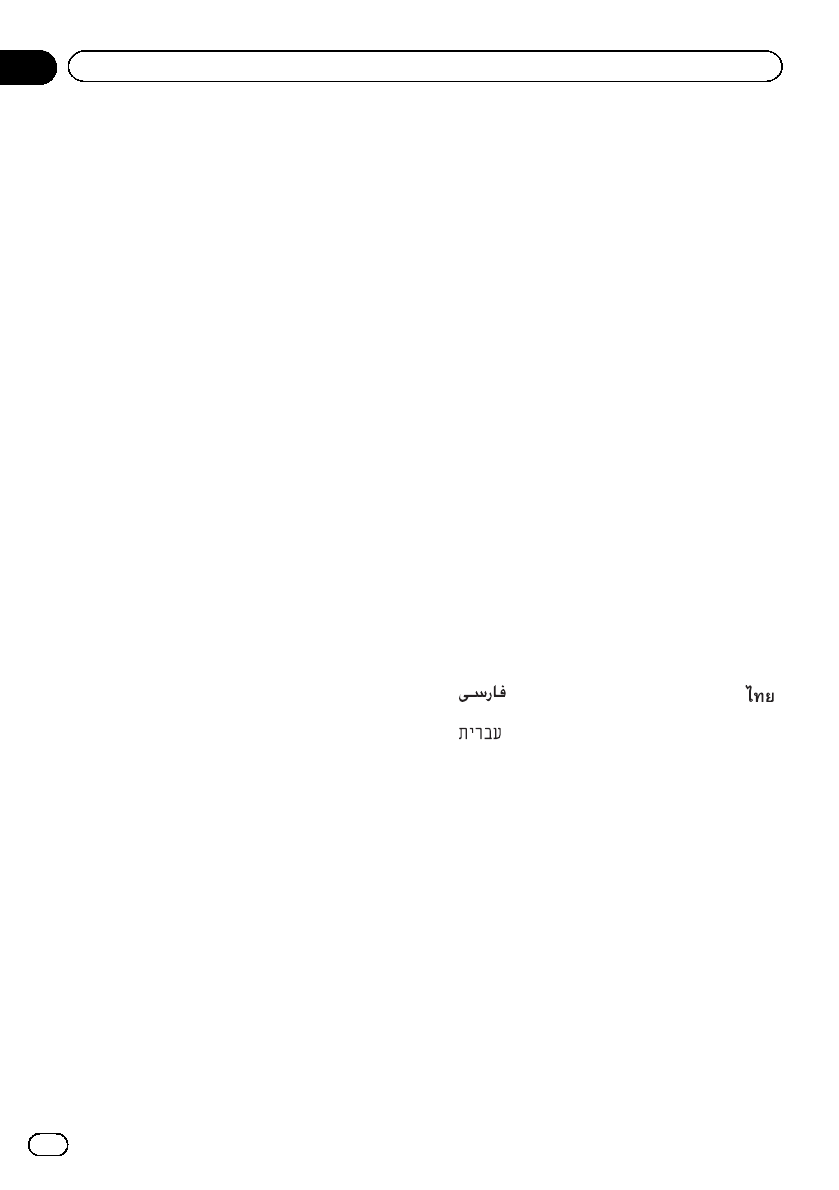
1 Display the system menu.
Refer to Introduction of menu operations on
page 55.
2 Touch Tag forwarding on the system
menu to turn USB1 or USB2.
Switching sound muting/
attenuation
Sound from this system is automatically
muted or attenuated when a signal from
equipment with a mute function is received.
!Sound from this system returns to normal
when the muting or attenuation is can-
celed.
1 Display the system menu.
Refer to Introduction of menu operations on
page 55.
2 Touch Mute/ATT until the desired set-
ting appears.
Touch Mute/ATT until the desired setting ap-
pears in the display.
!Mute –Muting
!ATT –20dB –Attenuation (ATT –20dB has a
stronger effect than ATT –10dB)
!ATT –10dB –Attenuation
!Off –Turns the sound muting/attenuation
off
Notes
!When Mute is displayed, the sound is turned
off and no audio adjustments can be made.
!When ATT is displayed, the sound is attenu-
ated and only the volume can be adjusted.
(No other audio adjustments can be made.)
!Operation returns to normal when the phone
connection is ended.
Selecting the system language
The system language can be selected from ten
languages.
If text information such as the title name, artist
name or a comment is embedded in a Eur-
opean language, they can also be displayed
on this unit.
!The language can be changed for the fol-
lowing:
—System menu
—Video Setup menu
—Bluetooth menu
—On-screen display
(English and Russian only)
—Multi language setting for DivX
(English and Russian only)
—Language for cautions
Some operations on this unit are prohib-
ited from use while driving or require
careful attention when operated. In
such cases, a caution will appear on the
display. You can change the language
for caution messages with this setting.
!If the embedded language and the selected
language setting are not the same, text in-
formation may not display properly.
!Some characters may not be displayed
properly.
1 Display the system menu.
Refer to Introduction of menu operations on
page 55.
2 Touch System Language on the system
menu to select the desired language.
3 Touch the desired language.
English (English)—Português (Portuguese)—
Español (Spanish)—Français (French)
—(Persian)—Deutsch (German)—
(Thai)—Русский (Russian)—ﺍﻟﻌﺮﺑﻴﺔ (Arabic)
—(Hebrew)
Setting the ever scroll
When ever scroll is set to On, recorded text in-
formation scrolls continuously in the display.
Set to Off if you prefer the information to
scroll just once.
1 Display the system menu.
Refer to Introduction of menu operations on
page 55.
2 Touch Ever Scroll on the system menu
to turn ever scroll on or off.
En
64
Section
15 Menu operations
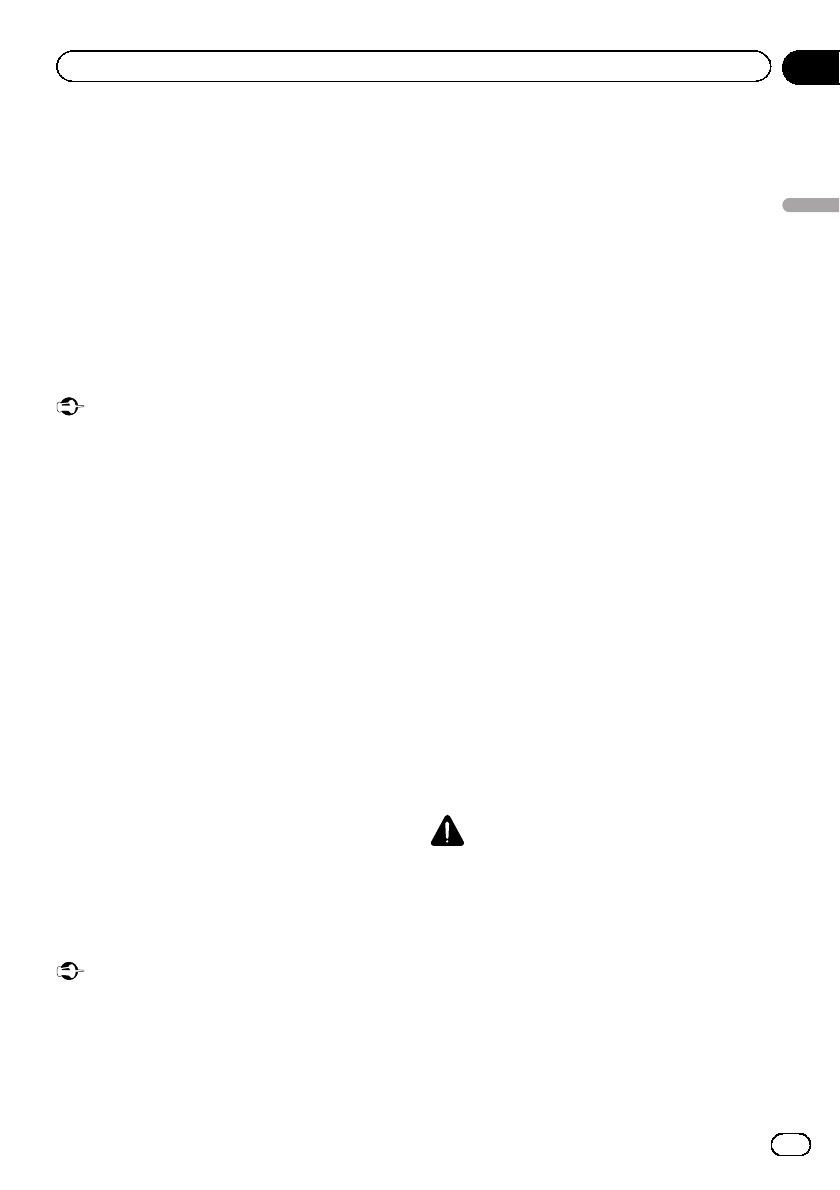
Setting the Bluetooth audio
You need to activate the Bluetooth Audio
source in order to use a Bluetooth audio
player.
1 Display the system menu.
Refer to Introduction of menu operations on
page 55.
2 Touch Bluetooth Audio on the system
menu to turn Bluetooth audio on or off.
Clearing Bluetooth memory
Important
Never turn the unit off while the Bluetooth mem-
ory is being cleared.
1 Turn the unit off.
Refer to Basic operations on page 14.
2 Press HOME to switch to the HOME dis-
play.
3 Touch System key.
System menu is displayed.
4 Touch Bluetooth Memory Clear on the
system menu.
5 Touch Clear.
After selecting a desired item, a confirmation
display appears. Touch OK to delete the mem-
ory.
#If you do not want to clear the memory, touch
Cancel.
Updating Bluetooth connection
software
This function is used to update this unit with
the latest bluetooth software. For about blue-
tooth software and updating, refer to our web-
site.
Important
Never turn the unit off and never disconnect the
phone while the software is being updated.
1 Turn the unit off.
Refer to Basic operations on page 14.
2 Press HOME to switch to the HOME dis-
play.
3 Touch System key.
System menu is displayed.
4 Touch BT Software Update.
5 Touch Start to display the data transfer
mode.
#Follow the on-screen instructions to finish up-
dating the bluetooth software.
Displaying the Bluetooth
system version
If this unit fails to operate properly, you may
need to consult your dealer for repair. In such
cases, you may be asked to specify the system
version. Perform the following procedure to
check the version on this unit.
1 Turn the unit off.
Refer to Basic operations on page 14.
2 Press HOME to switch to the HOME dis-
play.
3 Touch System key.
System menu is displayed.
4 Touch Bluetooth Version Information to
display to the version of the Bluetooth
module of this unit.
Setting the rear view camera
(back up camera)
CAUTION
Pioneer recommends the use of a camera
which outputs mirror-reversed images.
Otherwise, the screen image will appear re-
versed.
This unit features a function that automatically
switches to the rear view camera video (R.C
IN) when a rear view camera is installed on
your car and the shift lever is moved to the RE-
VERSE (R) position. (For more details, con-
sult your dealer.)
En 65
Section
15
Menu operations
Menu operations

!After you set up the rear view camera set-
ting, move the shift lever to REVERSE (R)
and confirm that the rear view camera
video is shown on the display.
!Change this setting if the display switches
to the rear view camera video by error while
you are driving forward.
!To stop watching the rear view camera
video and return to the source display,
press and hold MUTE.
!Touch the RearView source icon to display
the rear view camera image while driving.
Touch the source icon again to turn the
rear view camera off. For details, refer to Se-
lecting a source using the touch panel keys
on page 15.
1 Display the system menu.
Refer to Introduction of menu operations on
page 55.
2 Touch Camera Polarity on the system
menu to select the appropriate setting.
!Battery –When the polarity of the con-
nected lead is positive while the shift lever
is in REVERSE (R) position
!Ground –When the polarity of the con-
nected lead is negative while the shift lever
is in REVERSE (R) position
!Off –When a rear view camera is not con-
nected to this unit
Note
You can also switch the rear view image by press-
ing the touch key, regardless of the
Camera Polarity setting on the system menu.
Refer to Basic operations on page 14.
Setting the video signal
When you connect this unit to an AV equip-
ment to this unit, select the suitable video sig-
nal setting.
!As this function is initially set to Auto, the
unit will automatically adjust the video sig-
nal setting.
!You can operate this function only for the
video signal input into the AV input.
1 Display the system menu.
Refer to Introduction of menu operations on
page 55.
2 Touch Video Signal Setting on the func-
tion menu.
Video Signal Setting items are displayed.
!AV –Adjusts the AV video signal
!AUX –Adjusts the AUX video signal
!Camera –Adjusts the rear view camera
video signal
3 Touch cor dto select the desired
video signal appears.
Auto—PAL—NTSC—PAL-M—PAL-N—
SECAM
Setting the Artwork Dance
When a song is played by MIXTRAX, the art-
work display can be moved based on the
music type.
1 Display the system menu.
Refer to Introduction of menu operations on
page 55.
2 Touch Artwork Dance setting on the
system menu to turn On or Off.
Changing the picture adjustment
You can adjust the Brightness (brightness),
Contrast (contrast), Color (color) , Hue (hue),
Dimmer (dimmer), and Temperature (tem-
perature) for each source and rear view cam-
era.
!You cannot adjust Color,Hue and
Contrast for the audio source.
1 Display the system menu.
Refer to Introduction of menu operations on
page 55.
En
66
Section
15 Menu operations
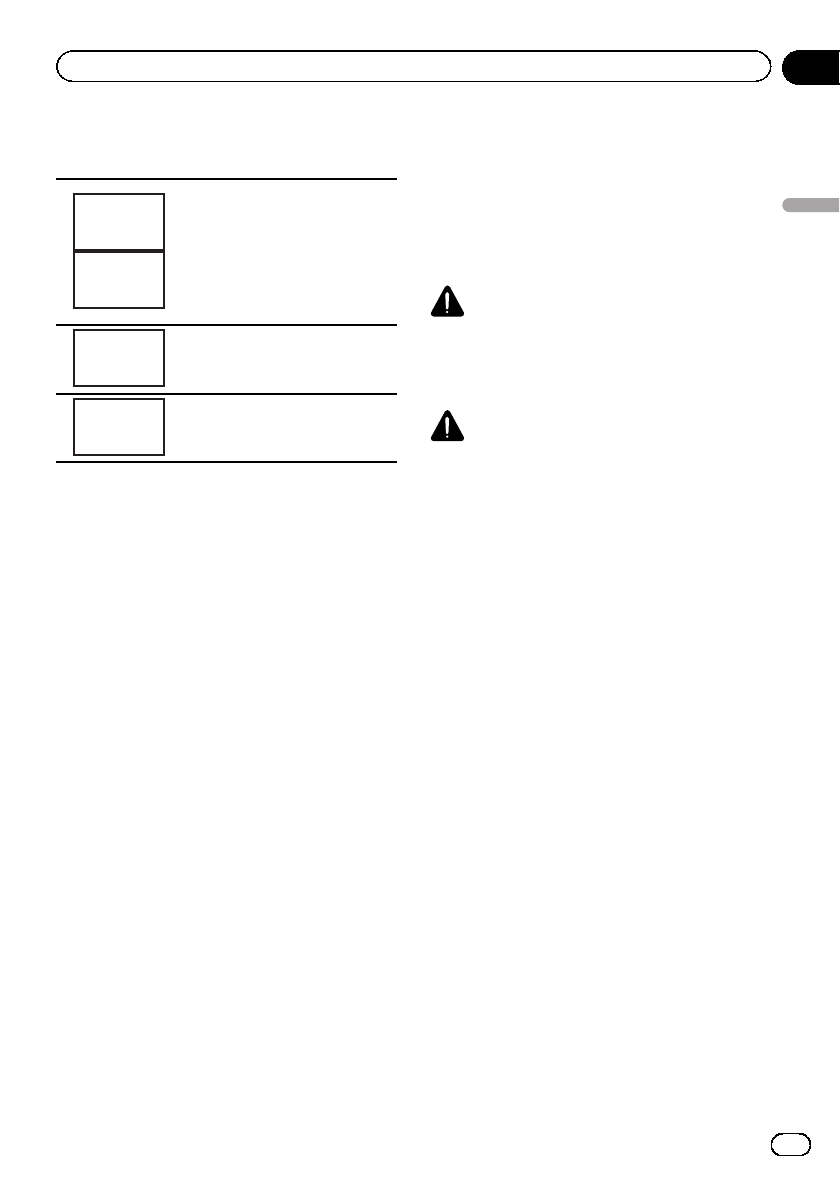
2 If you are adjusting the
Picture Adjustment, select the unit.
NAVI
App
Completing Picture Adjustment
for the Navigation system when
the RGB input setting is set to
NAVI.
Completing Picture Adjustment
for the Advanced App Mode
when the RGB input setting is
set to iPhone.
Rear
View Adjusting the Picture Adjust-
ment for the rear view camera.
Source Adjusting the Picture Adjust-
ment for the source.
3 Touch any of the following touch panel
keys to select the function to be adjusted.
Picture Adjustment items are displayed.
!Brightness –Adjusts the black intensity
!Contrast –Adjusts the contrast
!Color –Adjusts the color saturation
!Hue –Adjusts the tone of color (red or
green is emphasized)
!Dimmer –Adjusts the brightness of the dis-
play
!Temperature –Adjusts the color tempera-
ture, resulting in a better white balance
#You can adjust Hue only when the color sys-
tem is set to NTSC.
#With some rear view cameras, picture adjust-
ment may not be possible.
4 Touch cor dto adjust the selected
item.
Each time you touch cor d, the level of the
selected item increases or decreases.
#Dimmer can be adjusted from +1 to +48.
#Temperature can be adjusted from +3 to –3.
Notes
!You cannot operate this function while driving.
!Different Brightness/Contrast/Dimmer set-
tings can be set for when the illumination
switch is on and when it is off.
Auto EQ (auto-equalizing)
The auto-equalizer automatically measures
the car’s interior acoustic characteristics, and
then creates an auto-equalizer curve based on
that information.
!To perform this function, dedicated micro-
phone (e.g. CD-MC20) is required.
WARNING
As a loud tone (noise) may be emitted from the
speakers when measuring the car's interior
acoustic characteristics, never perform auto TA
or auto EQ while driving.
CAUTION
!Thoroughly check the conditions before per-
forming auto EQ as the speakers may be da-
maged if these functions are performed when:
—The speakers are incorrectly connected.
(For example, when a rear speaker is con-
nected as a subwoofer output.)
—A speaker is connected to a power amp de-
livering output higher than the speaker’s
maximum input power capability.
!If the microphone is placed in an unsuitable
position the measurement tone may become
loud and measurement may take a long time,
resulting in battery drainage. Be sure to place
the microphone in the specified location.
Before operating the auto EQ function
!Carry out auto EQ in as quiet a place as
possible, with the car engine and air condi-
tioning switched off. Also cut power to car
phones or portable telephones in the car, or
remove them from the car before carrying
out auto EQ. Sounds other than the mea-
surement tone (surrounding sounds, en-
gine sound, telephones ringing etc.) may
prevent correct measurement of the car in-
terior acoustic characteristics.
!Be sure to carry out auto EQ using the op-
tional microphone. Using another micro-
phone may prevent measurement, or result
in incorrect measurement of the car inter-
ior acoustic characteristics.
!In order to perform auto EQ, the front
speaker must be connected.
En 67
Section
15
Menu operations
Menu operations
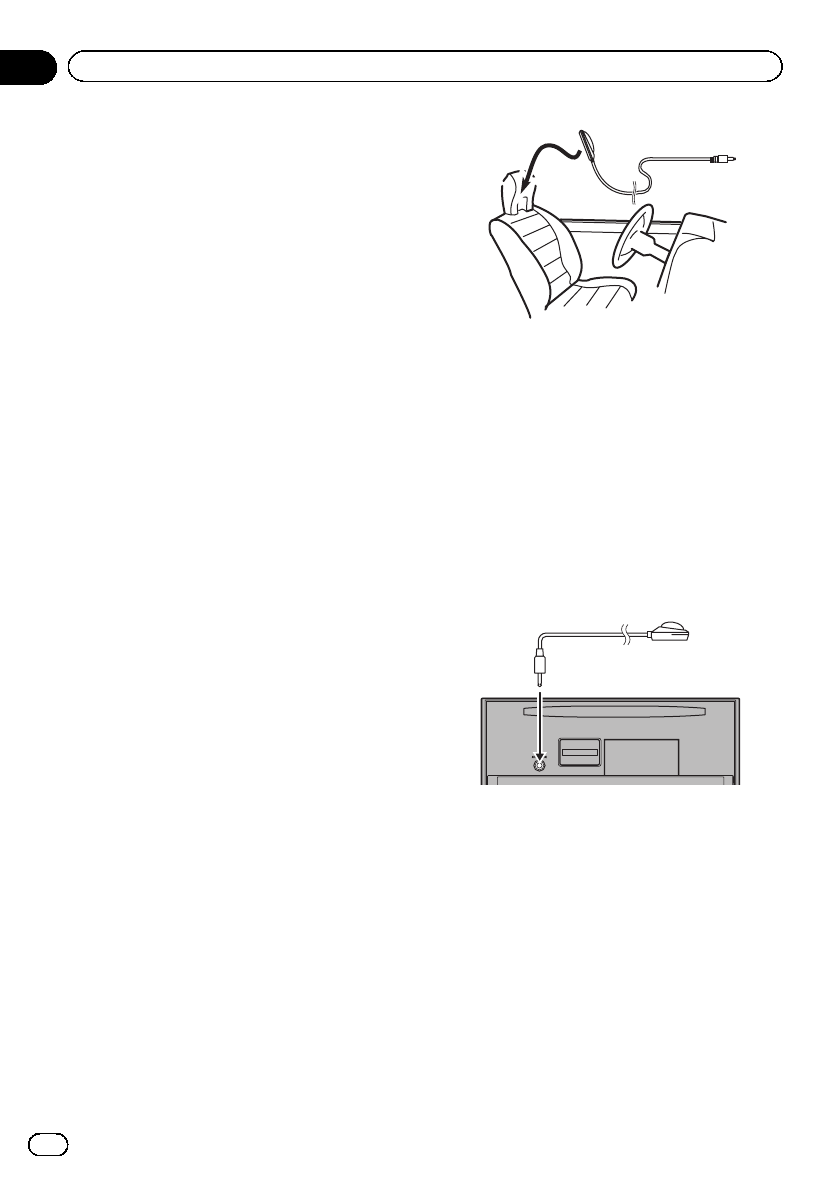
!When this unit is connected to a power
amp with input level control, auto EQ may
not be possible if the power amp’s input
level is set below the standard level.
!When this unit is connected to a power
amp with an LPF, turn this LPF off before
performing auto EQ. Also set the cut-off fre-
quency for the built-in LPF of an active sub-
woofer to the highest frequency.
!The distance has been calculated by com-
puter to be the optimum delay to give accu-
rate results for the circumstances, so
please continue to use this value.
—The reflected sound within the car is
strong and delays occur.
—The LPF on active subwoofers or exter-
nal amps delay the lower sounds.
!Auto EQ changes the audio settings as fol-
lows:
—The fader/balance settings return to the
center position. (Refer to Using fader/
balance adjustment on page 56.)
—The equalizer curve switches to Flat.
(Refer to Recalling equalizer curves on
page 56.)
—The front, center and rear speakers will
automatically be adjusted to a high
pass filter setting.
!Previous settings for auto EQ will be over-
written.
Performing auto EQ
1 Stop the car in a place that is quiet,
close all the doors, windows and sun roof,
and then turn the engine off.
If the engine is left running, engine noise may
prevent correct auto EQ.
2 Fix the optional microphone in the cen-
ter of the headrest of the driver’s seat, fa-
cing forward.
The auto EQ may differ depending on where
you place the microphone. If desired, place
the microphone on the front passenger seat to
carry out auto EQ.
3 Turn the ignition switch to ON or ACC.
If the car’s air conditioner or heater is turned
on, turn it off. Noise from the fan in the air
conditioner or heater may prevent correct auto
EQ.
4 Display the system menu.
Refer to Introduction of menu operations on
page 55.
5 Touch Auto EQ Measurement to enter
auto EQ measurement mode.
6 Plug the microphone into the micro-
phone input jack on this unit.
7 Touch Start to start auto EQ.
8 When the 10-second countdown starts,
get out of the car and close the door within
10 seconds.
A measurement tone (noise) is emitted from
the speakers, and auto EQ measurement be-
gins.
When auto EQ is completed, The measure-
ment has finished. Please disconnect the
microphone and then push HOME key. is
displayed.
When the car’s interior acoustic characteris-
tics cannot be measured correctly, an error
message will be displayed. (Refer to Under-
standing auto EQ error messages on page 97.)
En
68
Section
15 Menu operations

#It takes about nine minutes for auto EQ mea-
surement to be completed when all the speakers
are connected.
#To stop auto EQ, touch Stop.
9 Store the microphone carefully in the
glove compartment or another safe place.
If the microphone is subjected to direct sun-
light for an extended period, high tempera-
tures may cause distortion, color change or
malfunction.
10 Press h(eject) to close the panel.
Favorite menu
1 Display menu columns to register.
Refer to Introduction of menu operations on
page 55.
#You can customize menus except
Video Setup menu.
2 Touch and hold the menu column to
register it.
#To cancel registration, touch and hold the
menu column again.
3 Display the favorite menu and choose a
registered menu.
Refer to Introduction of menu operations on
page 55.
Note
You can register up to 12 columns.
En 69
Section
15
Menu operations
Menu operations
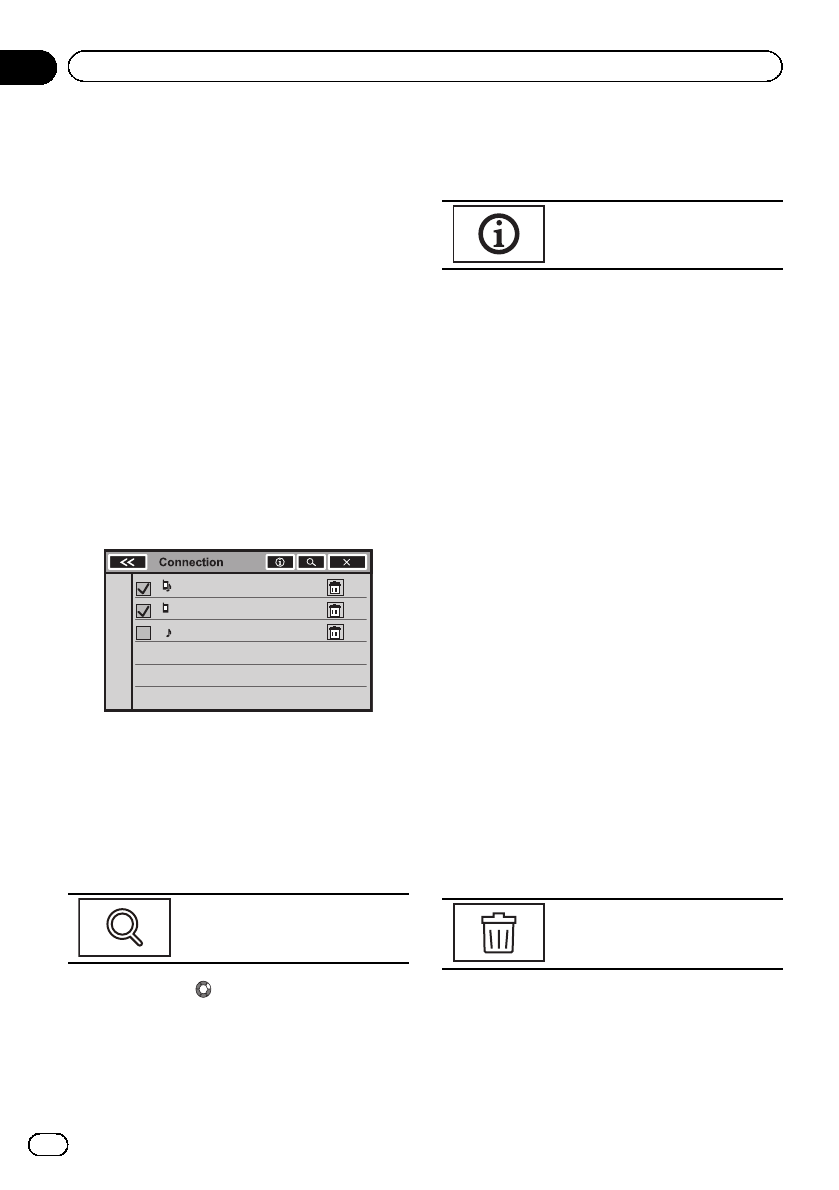
Introduction of Bluetooth
connection menu operations
Refer to Basic operations on page 14.
If you are using a cellular phone that can be
connected via Bluetooth wireless technology,
we recommend that you use your phone to
search for this unit and establish a connection
between it and your phone. The PIN code is
set to 0000 as default. The product name for
this unit will display on your phone as the de-
vice name. For details, refer to Entering PIN
code for Bluetooth wireless connection on page
72. For further details concerning the proce-
dures for establishing Bluetooth wireless con-
nections, refer to the instruction manual for
the phone.
Pairing from this unit
01: Phone1
02: Phone2
03: Phone3
1 Display the Bluetooth Connection
Menu.
Refer to Introduction of Bluetooth telephone op-
erations on page 37.
2 Touch Connection to select a device.
3 Start to search.
Starting to search.
While searching, is displayed and when
available devices are found, the device names
or Bluetooth device addresses (if names can-
not be obtained) are displayed.
#If you want to switch between the device
names and Bluetooth device addresses, touch
the icon.
Switching between the device
names and Bluetooth device ad-
dresses.
#To cancel searching, touch Stop.
#If three devices are already paired,
Memory Full is displayed and pairing cannot be
performed. In such cases, delete a paired device
first. Refer to this page.
#If no device can be found, Not Found is dis-
played. In such cases, check the status of the
Bluetooth device and search again.
4 Touch a device name to select the de-
vice you want to connect to.
While connecting, Pairing is displayed. If the
connection is established, Paired is displayed.
!If your device support SSP (Secure Simple
Pairing), 6-digit number appears on the dis-
play of this unit. Once the connection is es-
tablished, this number disappears.
#If the connection fails, Error is displayed. In
such cases, try again from the beginning.
#The PIN code is set to 0000 as the default, but
can be changed. Refer to Entering PIN code for
Bluetooth wireless connection on page 72.
#Once the connection is established, the de-
vice name is displayed.
Touch the device name to disconnect.
#If you want to delete a paired Bluetooth tele-
phone, display Delete OK?. Touch Yes to delete
the device.
Deleting a paired device.
#Never turn the unit off while the paired
Bluetooth telephone is being deleted.
En
70
Section
15 Menu operations

Using a Bluetooth device to pair
If you cannot open the connection between
your Bluetooth device and this unit from your
Bluetooth device, you can use this function to
establish a connection.
1 Display the Bluetooth Connection
Menu.
Refer to Introduction of Bluetooth telephone op-
erations on page 37.
2 Touch Special Device to select the spe-
cial device.
#Bluetooth devices that are difficult to establish
a connection with are called special devices. If
your Bluetooth device is listed as a special device,
select the appropriate one.
3 Touch the special device list to open the
connection.
This unit is now on standby for a connection
with the Bluetooth device.
#If three devices are already paired,
Memory Full is displayed and pairing cannot be
performed. In such cases, delete a paired device
first. Refer to the previous page.
4 Use your Bluetooth device to establish
a connection.
The connection method is different depending
on the Bluetooth device. Refer to the manual
for your Bluetooth device to establish a con-
nection.
While connecting, Pair your phone is dis-
played. If the connection is established,
Paired is displayed.
#If the connection fails, Error is displayed. In
such cases, try again from the beginning.
#You may also need to enter a PIN code into
this unit. If your telephone requires a PIN code to
establish a connection, look for the code on the
telephone or in its accompanying documenta-
tion.
#The PIN code is set to 0000 as the default, but
can be changed. Refer to Entering PIN code for
Bluetooth wireless connection on the next page.
Connecting to a Bluetooth
device automatically
If this function is set to on, a connection be-
tween your Bluetooth device and this unit will
take place automatically as soon as the two
devices are less than a few meters apart.
Initially, this function is set to on.
1 Display the Bluetooth Connection
Menu.
Refer to Introduction of Bluetooth telephone op-
erations on page 37.
2 Touch Auto Connect to turn automatic
connection on.
If your Bluetooth device is ready for a
Bluetooth wireless connection, a connection
to this unit will automatically be established.
#To turn automatic connection off, touch
Auto Connect again.
If connection fails, “Auto connection failed.
Retry?”appears. Touch Yes to reconnect.
3 Once you turn your vehicle’s ACC
switch on again, a connection is estab-
lished automatically.
Switching visible unit
This function sets whether or not to make this
unit visible to the other device.
Initially, this function is set to on.
1 Display the Bluetooth Connection
Menu.
Refer to Introduction of Bluetooth telephone op-
erations on page 37.
2 Touch Visibility to select visibility off.
#To turn visibility on, touch Visibility again.
Displaying Bluetooth Device
address
This unit displays its Bluetooth device ad-
dress.
1 Display the Bluetooth Connection
Menu.
Refer to Introduction of Bluetooth telephone op-
erations on page 37.
En 71
Section
15
Menu operations
Menu operations
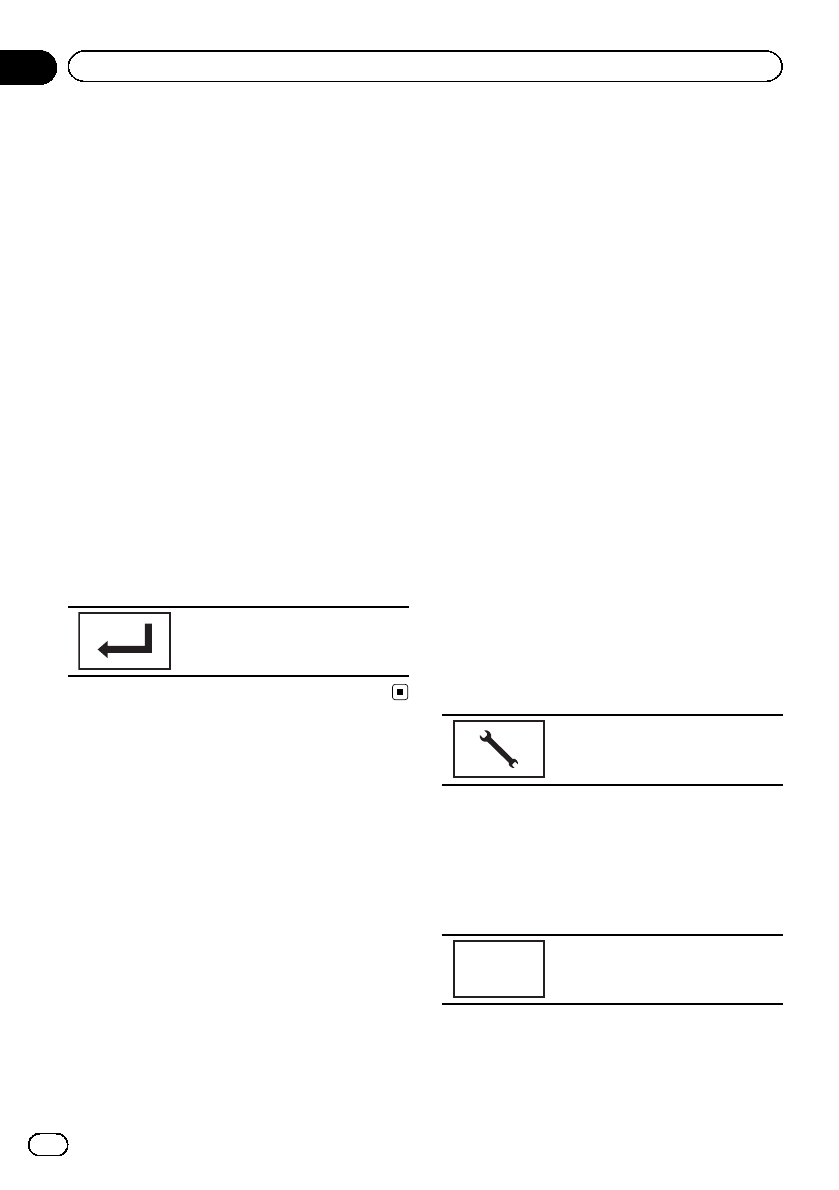
2 Touch Device Information to display de-
vice information.
The Bluetooth device address is displayed.
Entering PIN code for Bluetooth
wireless connection
To connect your Bluetooth device to this unit
via Bluetooth wireless technology, you need to
enter a PIN code on your Bluetooth device to
verify the connection. The default code is
0000, but you can change it with this function.
1 Display the Bluetooth Connection
Menu.
Refer to Introduction of Bluetooth telephone op-
erations on page 37.
2 Touch PIN Code Input to select
PIN Code Input.
3 Touch 0 to 9 to input pin code.
4 After inputting PIN code (up to 8 di-
gits), store in this unit.
Storing the PIN code in this unit.
Introduction of Theme
setting menu operations
Refer to Basic operations on page 14.
Selecting the illumination color
This unit is equipped with multiple-color illu-
mination.
Direct selection from preset
illumination colors
You can select an illumination color from the
color list.
1 Display the Theme menu.
Refer to Basic operations on page 14.
2 Touch Illumination and then touch a
color on the list.
Customizing the illumination color
1 Display the Theme menu.
Refer to Basic operations on page 14.
2 Touch Illumination and then touch
Custom.
3 Display the customizing menu.
Displaying the customizing menu.
4 Touch the color bar to customize the
color.
5 Touch cor dto fine-tune the color.
6 Touch the icon and hold to store the
customized color in the memory.
Memo
Storing the customized color in
the memory.
The customized color has been stored in the
memory.
The set color will be recalled from the memory
the next time you touch the same icon.
En
72
Section
15 Menu operations

Selecting the OSD (on-screen
display) color
The OSD color can be changed.
1 Display the Theme menu.
Refer to Basic operations on page 14.
2 Touch Screen.
3 Touch one of the colors on the list.
Selecting the background display
You can switch the background that is dis-
played when listening to a source.
1 Display the Theme menu.
Refer to Basic operations on page 14.
2 Touch Background.
3 Touch the desired setting.
#If no JPEG images are stored in this unit, you
cannot select photo. To store a JPEG image to
this unit, refer to Capture an image in JPEG files
on page 48.
#If you want to delete the captured JPEG
image, touch and hold the key of the JPEG
image.
#You can view the hidden settings by dragging/
flicking the display.
En 73
Section
15
Menu operations
Menu operations
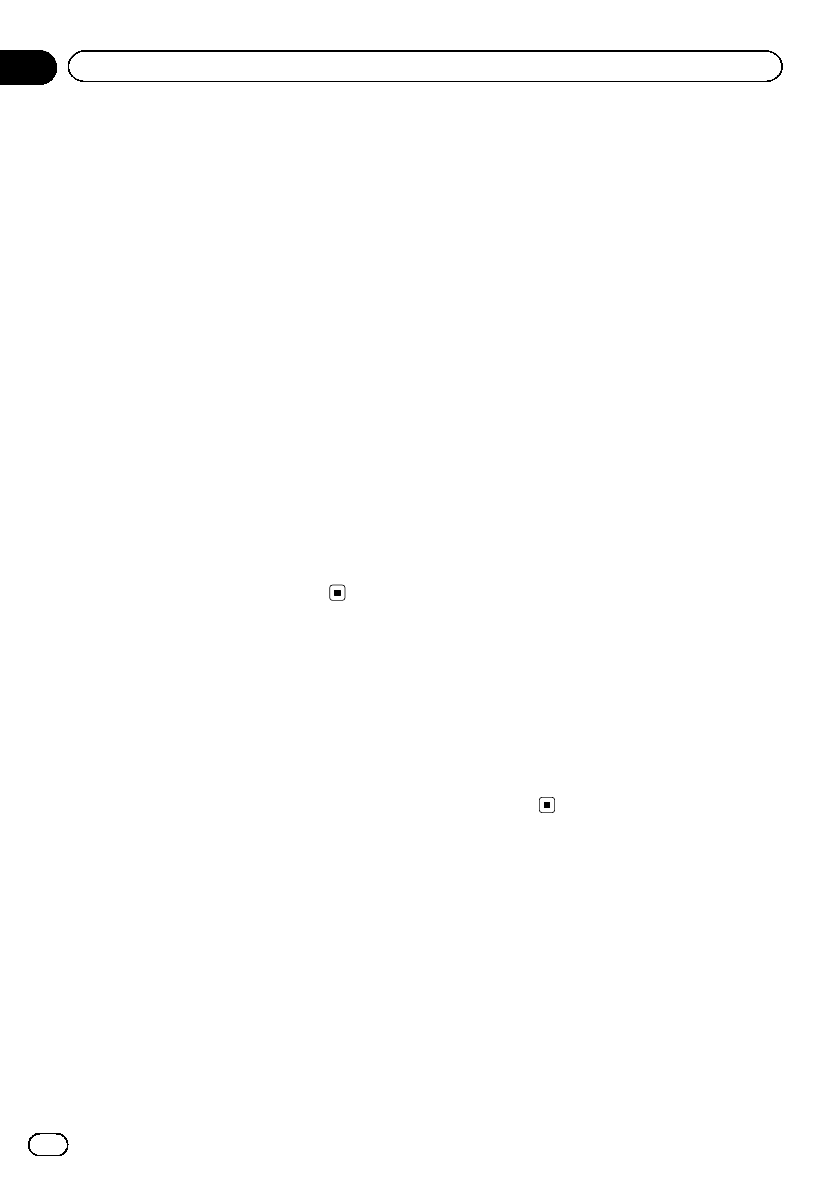
Setting rear monitor output
The output source for the rear monitor can be
switched to the following:
!Mirror –The source on the front screen of
this unit
Disc –The video and sound from the disc
USB/iPod 1 –The video and sound from
the USB storage device
SD –The video and sound from the SD
card
AV –The video and sound from AV input
Off–No source
Notes
!You cannot play DivX files on the rear and
front monitors at the same time.
!The port that supports the rear monitor will
only be USB input 1.
!USB/iPod 1 and SD are compatible DivX/
MPEG-4/WMV/H.264 only.
!You cannot use this function while using MIX-
TRAX. If you use MIXTRAX while this function
is in use, this function will turn off.
Adjusting the response
positions of the touch panels
(Touch Panel Calibration)
If you feel that the touch panel keys on the
screen deviate from the actual positions that
respond to your touch, adjust the response po-
sitions of the touch panel. There are two ad-
justment methods: 4-point adjustment, in
which you touch four corners of the screen;
and 16-point adjustment, in which you make
fine-adjustments on the entire screen.
!Park your car in a safe place and use this
function. Do not operate it while driving.
!Touch the screen gently for adjustment.
Forcefully pressing the touch panel may da-
mage the touch panel. Do not use a sharp
pointed tool such as a ballpoint pen or me-
chanical pen. Doing so may damage the
screen.
!If the touch panel cannot be adjusted prop-
erly, consult your local Pioneer dealer.
1 Turn the unit off.
Refer to Basic operations on page 14.
2 Press and hold HOME to start Touch
Panel Calibration.
The 4-point touch panel adjustment screen ap-
pears. When 2-point appears at once, touch
both.
3 Touch each of the arrows on the four
corners of the screen.
#To cancel the adjustment, press and hold
HOME.
4 Press HOME to complete 4-point adjust-
ment.
Data for the adjusted position is saved.
#Do not turn off the engine while the data is
being saved.
5 Press HOME to proceed to 16-point ad-
justment.
The 16-point touch panel adjustment screen
appears.
#To cancel the adjustment, press and hold
HOME.
6 Gently touch the center of the + mark
displayed on the screen.
After you touch all the marks, the data for the
adjusted position is saved.
#Do not turn off the engine while the data is
being saved.
7 Press and hold HOME to complete the
adjustment.
Using an AUX source
A separately sold auxiliary device such as a
VCR or portable device can be connected to
this unit. When connected, the auxiliary device
is automatically recognized as an AUX source
and is assigned to AUX.
About AUX connection methods
You can connect auxiliary devices to this unit.
En
74
Section
16 Other functions
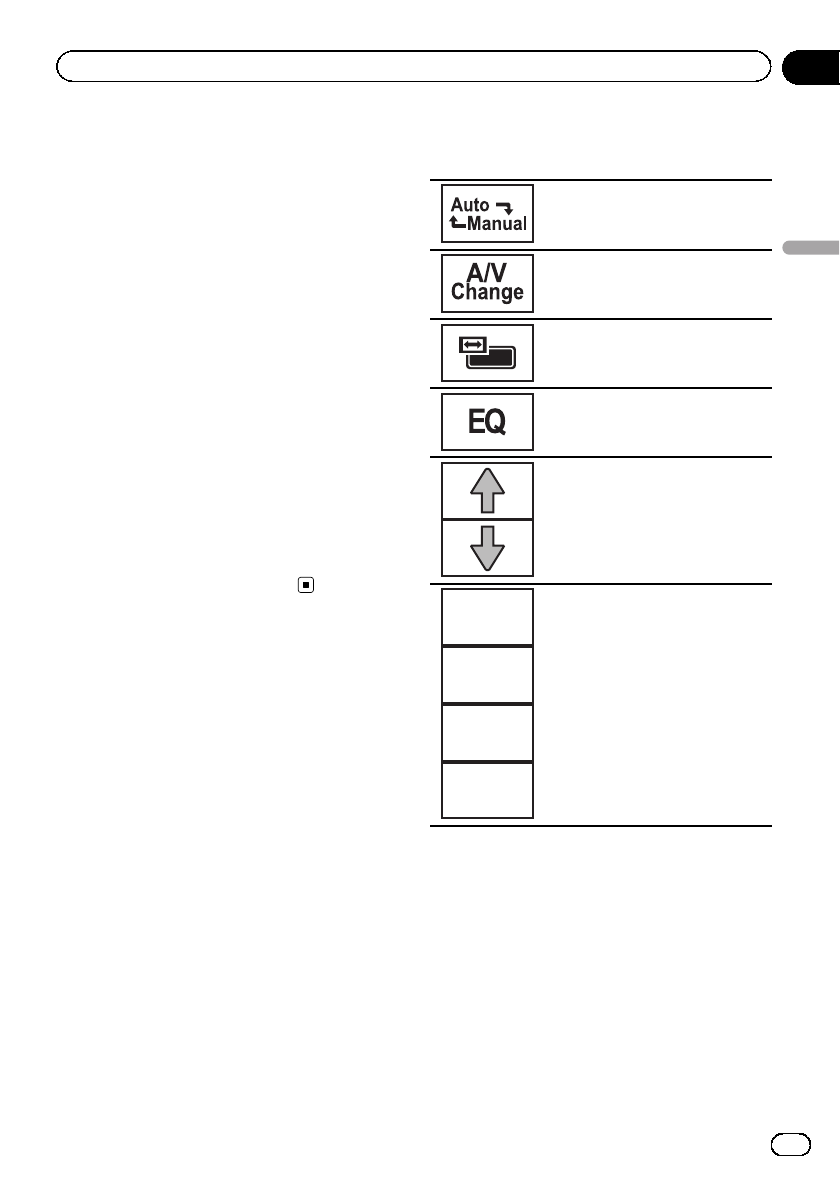
Mini pin plug cable (AUX)
When connecting an auxiliary device using a
mini plug cable
iPods and portable audio/video players can be
connected to this unit via mini plug cable.
!If an iPod with video capabilities is con-
nected to this unit via 3.5 mm plug (4 pole)
cable (such as the CD-V150M), you can
enjoy the video contents of the connected
iPod.
!A portable audio/video player can be con-
nected by using a 3.5 mm plug (4 pole) with
an RCA cable (sold separately). However,
depending on the cable, a reverse connec-
tion between the red (right side audio)
cable and yellow (video) cable may be re-
quired in order for the sound and video
image to be reproduced correctly.
%Insert the stereo mini plug into the
AUX input jack on this unit.
Refer to Installation on page 77.
Refer to What’s what on page 11.
Using an external unit
An external unit refers to a Pioneer product,
such as those which will be available in the fu-
ture. Although incompatible as a source, the
basic functions of up to two external units can
be controlled with this unit. When two external
units are connected, the external units are
automatically allocated to external unit 1 or ex-
ternal unit 2.
The basic operations of the external unit are
explained below. The allocated functions will
differ depending on the connected external
unit. For details concerning these functions,
refer to the owner’s manual for the external
unit.
Basic operations
The functions allocated to the following opera-
tions will differ depending on the connected
external unit. For details concerning these
functions, refer to the owner’s manual for the
connected external unit.
Switching to auto or manual.
Switching to video or audio.
Changing the screen mode.
Refer to Changing the wide screen
mode on page 48.
Switching the equalizer curves.
Refer to Using the equalizer on
page 56.
Actions will differ depending on
the connected external unit.
F1
F2
F3
F4
Function 1 to 4
Actions will differ depending on
the connected external unit.
En 75
Section
16
Other functions
Other functions
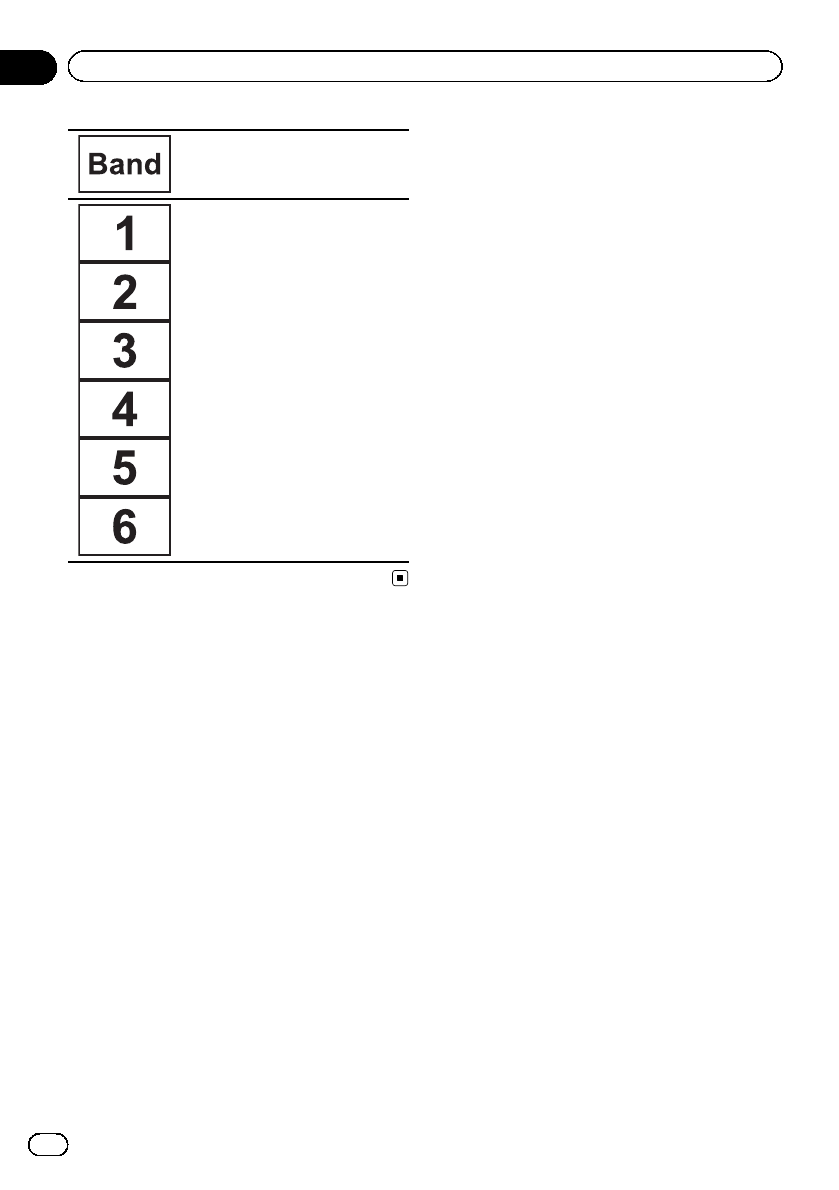
Actions will differ depending on
the connected external unit.
Actions will differ depending on
the connected external unit.
En
76
Section
16 Other functions